- Home
- Collections
- HOLLYWOOD G
- The Scindian
- Scindian 1964
Scindian 1964
BOYS’ HIGH SCHOOL
NAPIER, NEW ZEALAND, 1964
BOARD OF GOVERNORS:
Chairman: MR J.G. EDWARDS, M.A., M.P., Dip. Tchg.
MRS M. DAVIDSON
MRS D. R. LUCAS
MRS J. McTAGGET
DR. E. H. J. BERRY
MR D. DALTON
MR G. P. KELLER
MR L. R. LEWIS
MR L. MORGAN
MR R.B. READ
MR N.G. ROACH
MR E.R. SPRIGGS
MR R.A. WARBURTON
Secretary and Treasurer:
H. JOHNSON, Esq., A.R.A.N.Z.
P.O. Box 377, Napier.
Headmaster:
D. P. CAIRD, B.A., Dip. Ed.
First Assistant:
M. A. F. CAMPBELL, M.A.
In Memoriam
The School deeply regrets the passing of the following two pupils: COLIN CHARLES PORTER, 4R (accidentally) at Bay View on Sept. 7. KEVIN CHRISTOPHER WESTON, 6A (accidentally) at Waikari-iti on October 23.
We express our sympathy to their parents and families.
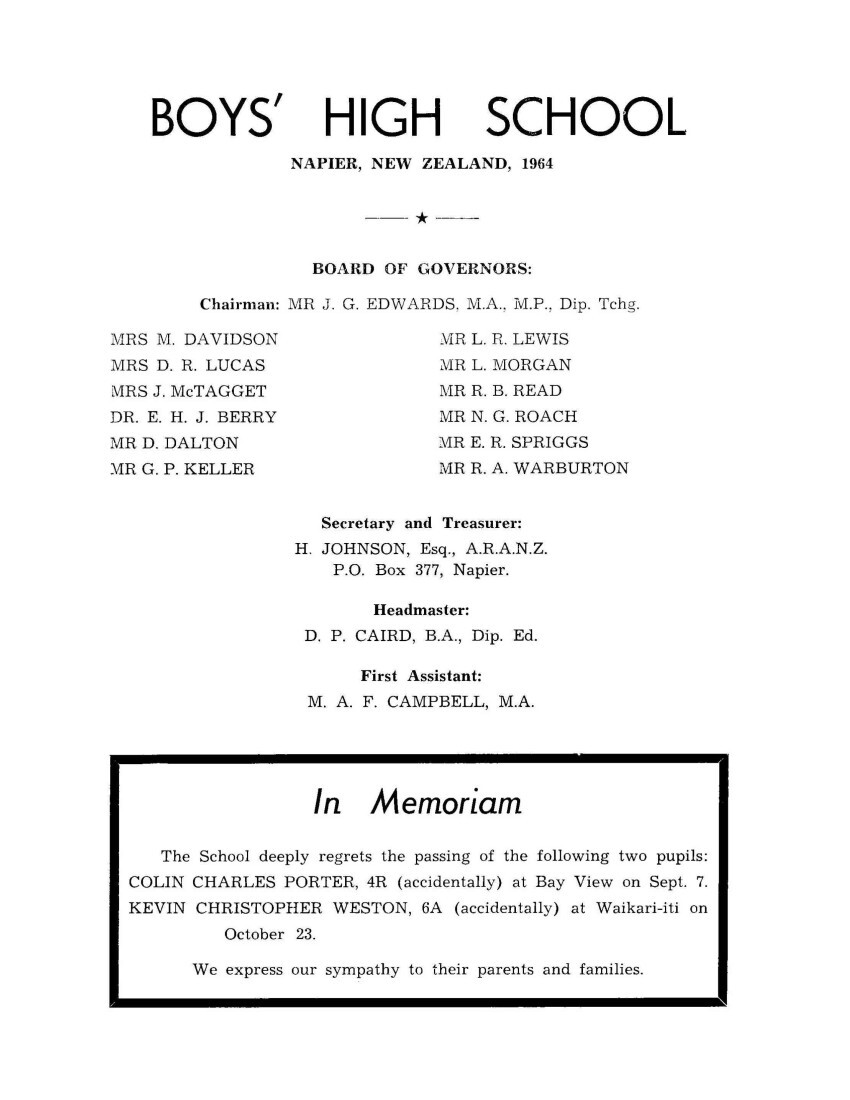
Page 4
SCHOOL DIARY 1964
FEBRUARY
4 – School opened.
18 – Swimming Sports, Preliminaries.
20 – Swimming Sports, Finals.
21 – Reverend Dean Guymer addressed school.
25 – Drill (morning).
MARCH
2 – Performance by Shakespearean Trio.
5-6 – Athletic Sports.
10 – Visit to school by Reverend Hay.
16 – 1st Cricket XI v. Gisborne B.H.S. 1st XI Gisborne. 2nd Cricket XI v. Gisborne B.H.S. end XI at Napier. Tennis team v. Gisborne B.H.S. Tennis team at Gisborne.
19 – New Zealand Drama Quartet.
21 – Inter-secondary Schools’ Athletic Sports at Wairoa.
23 – 1st Cricket XI v. Palmerston North B.H.S. 1st XI at Napier.
25 – Military Drill (morning).
26-31 – Easter Break.
APRIL
6-8 – Third Form Examinations.
8 – Dr. Berry’s Visit to School.
9-15 – Barracks Week.
21 – Visit to School by Victoria University Liaison Officer, Mr R. Hogg.
23 – Annual School Steeplechase.
27-30 – Fifth Form Examinations.
27 – Visit by four Japanese Students.
29 – Military Drill (afternoon).
MAY
1 – Day Boy Prefects’ Dance.
4-8 – Visit to school by Mr T. Young.
8 – First Term Ended.
26 – Second Term Began.
JUNE
7-9 – 1st Rugby XV v. Shirley Boys’ High School 1st XV at Napier. 1st Hockey XI v. Shirley B.H.S. 1st XI at Napier. 1st Soccer XI v. Shirley B.H.S. 1st XI at Napier.
17-18 – “Our Town” presented by Napier Boys’ and Napier Girls’ High Schools.
19-26 – Fourth and Sixth Forms Examinations.
25 – Visit to school farm by Dr. Barna Siri.
30 – XV v. Hastings B.H.S. 1st XV at Napier.
JULY
7 – Visit by Mr Rosali and Mr Bunn.
10 – Boarders’ Exeat.
15 – 2nd and 3rd Rugby XV v. Wairoa College at Wairoa.
16 – Military Drill (morning).
23-24 – 1st Hockey XI v. Gisborne B.H.S. 1st XI at Gisborne. 1st Soccer XI v. Gisborne B.H.S. 1st XI at Gisborne. Indoor Basketball A Team v. Gisborne B.H.S. at Gisborne. 1st Rugby XV v. Gisborne B.H.S. 1st XV at Napier. Debating Team v. Gisborne B.H.S. at Napier.
OCTOBER
1 – Performance of Colenso High School Madrigal Group in assembly. N.Z. Post and Telegraph Communications Display.
3 – Coleman Shield Shoot. Hawke’s Bay Inter- secondary Schools’ Steeplechase at Napier
6-8 – Visit by Mr Hendra.
8 – Tabloid Sports.
13-21 – Fifth and Sixth Forms Examinations.
22-27 – Show and Labour Weekend Break.
NOVEMBER
4 – Chamber of Commerce Arithmetic Competition.
5 – Senior Prepared Speech.
13 – University Accrediting Announced. Physical Education Competitions.
16-30 – School Certificate Examinations.
30 -University Entrance Examinations begin.
DECEMBER
2 – Central Hawke’s Bay visit for Tennis, Softball, Cricket.
7-8 – Military Drill.
8 – 1st and 2nd Cricket XI v. Hastings Boys’ High School.
9 – 1st and 2nd Tennis Teams v. Hastings B.H.S. Prize-giving in Municipal Theatre.
10 – Masters v. 1st Cricket XI.
11 – End of School Year.
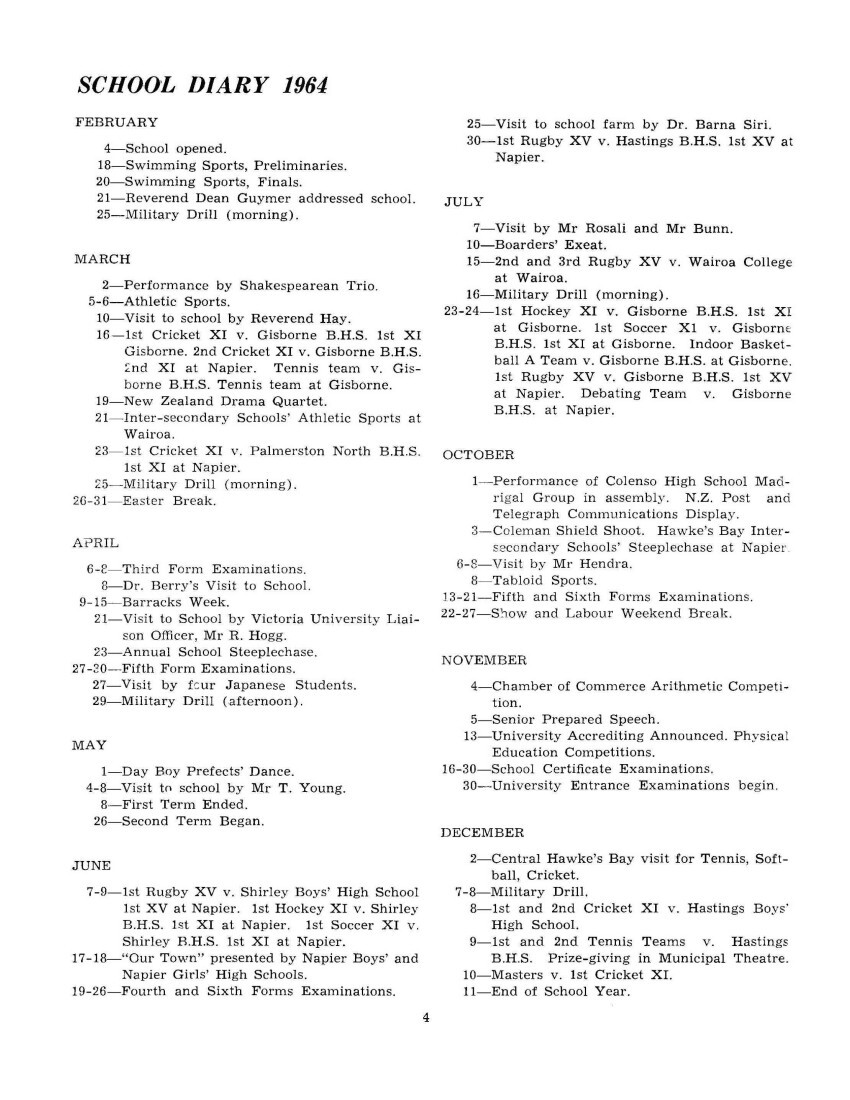
Page 5
EXAMINATION RESULTS 1963
A. J. Schmidt, University Junior Scholar 1963
University Entrance Scholarship: Junior Scholarship: Schmidt, A. J. Passed with Credit: Irwin, J.R.
Higher School Certificate: Angove, D. H.; Barnes. K. W.; Brendon, B. S.; Chin, R.; Dale. G. P.; Hobin, R. V.; Irwin, J. R.; Isles, J. K.W, B. A.; Larsen, W. A.; McGregor, E. W.; Marshall, D. P. J.; Mitchell, A. J.; Nicholas. W. W. H.; Seuseu. K. F.; Schmidt. A. J.; Thompson, R. A.; Williams. G. B.
University Entrance: Dallas, R.; Dick, G. L.; Dobson, N. W.; Ebbett, G. W.; Ferguson. D. B.; Fergusson, D. J.; Frame. C. B.; Gardner, D. R.; Girvan, M. R.; Harvey, G. L.; Higgins, L. G.; Hing, K. R.; Hook, G. B.; Kay, J. A.; Kells, R. I.; Kerr, D. D.; Lee, A. R.; Liddell, G.; Lum, C.; Macdonald, D. O.; McDougall, A. D.; Mackintosh. A. J.; Malcolm, R. K.; Martin, D. W.; Paterson. G. R. H.; Piper, J. A.; Pishief. J.; Potter. J. W.; Robinson, E. E.; Robinson, G. W.; Sadler, W. A.; Sherwood, R. H.; Smith, C. B.; Tolley, A. H.; Tuck. A. G.; Tucker. R. W.; Turbitt. I. T; Turner, W. E. D.; Turner, W. K.; Weston, K. C.; Wilson, A. R.
Endorsed School Certificate: Baudinet, B. R.; Campbell. I. N.; Chandler, H. A.; Chrystal, B.; Cormack, D. W.; Dallas, R.; Dick. G. L.; Dobson. N.W.; Ebbett. G. W.; Elmes, R. F.; Farquhar. R. W.; Fergusson, D. J.; Forrest, C. A. Frame. C B.; Gardner, D. R.; Girvan, M. R.; Hall. G. J. Harvey, G. L.; Higgens, L. G.; Hing. K. R.; Hook, G. B.; Jensen, M.L; Johnson. K.; Keils, R. I. Kerr. D. D.; King, R. L.; Liddell. G.; Loader, P. C.; Macdonald, D. O.; McDougall, A. D.; Mackintosh, A. J.; McKelvie, R. M.; MacLeod, J. D.; Malcolm, R. K.; Martin, D. W.; Morrin, T. A.; Paterson, G. R. H.; Piper, J. A.; Piper. J. M.C; Pischief. J.; Potter. J. W.; Pritchard. N. C.; Robinson, G. W.; Sadler, W. A.; Sherwood, R. H.; Sinclair, J. W.; Smith, C. B.; Spiller, S. P.; Stevens, R. E.; Thomas, F. C.; Tolley, A. H.; Tuck, A. G.; Tucker, R. W.; Turbitt, I. T.; Turner, W. E. D.; Turner, W. K.; Weston, K. C.
School Certificate Examination: Armour, R. W.; Barlow, G. W.; Beattie. I. A.; Campbell, K. S.; Campbell, L. J. M.; Carney, P. R.; Castles, R. J.; Connor, A. M.; Cottrell, R. V.; Cross, R. I.; Crowley, R. M.; Daley, B. W.; de Denne. J. P.; Delugar, J. T.; Donaldson, I. K.; Exeter, G. L.; Exeter, J. D.; Forsyth, J. G.; Fraser, B. C. Harrison, B. H.; Harvey. G. J.; Herbert. S. C.; Hills, D. J.; Howell, M. J.; Johnston, B. L.; Johnson, G. O.; Kohlis, G.; Lambert, M. L.; Lancaster, J. R.; Lum, C.; McBeath, D. J.; McCorkindale, W. R.; McGhie, G. A. J.; Mackay, G. A.; Malthus, D. J.; Marshall, P. G.; Masters, S. C.; Mear, M. D.; Mellor. K. J.; Moffitt. G. H.; Morrison, T. R; Nation, S. I. W.; Neville. R.D.; Norris, M. F, J.; Nuttall, G. K.; Pearse, H. T.; Peddie, R. G.; Prichard, A. K.; Prince, J. O.; Prosser, H. W.; Riggs, A. K.; Rowe, A. J; Scott, J. L.; Scott, R. S.; Shearn, D. M.; Simcox, R.; Simkin, D. L.; Simpson. M. B.; Smart, T.; Smith, A. P.; Taaffe, D. M.; Tennent, H. E. C.; Thornburrow, A. J.; Tuck, P. J. C.; Tucker, R. W.; Turner, B. D., Vivieaere, J. E.; Wallace, K. B.:;Willis, M. W.; Wilson, S. J.

Page 8
MR D. S. McKENZIE
On Friday, 21st August, Mr Dugald S. McKenzie attended his last assembly at our school. After the headmaster had praised the value of his teaching and the quality of his service, the head prefect G. W. Robinson, spoke a warm tribute on behalf of the boys. He said that Mr McKenzie’s work with the agriculture students was an important part of their school life. The head prefect specially mentioned Mr McKenzie’s service as senior house master at Scinde House, and went on to refer briefly to his contribution to softball, shooting and the third Rugby fifteen. After congratulating Mr McKenzie on his appointment as headmaster at Marlborough College, Graeme Robinson called for cheers, which were warmly given by the school.
Mr McKenzie came to this school in 1953. He had been an officer in the Royal Navy during the war, and had later travelled as a Nature Study specialist in the primary school service. Although he had the Lincoln College Diploma of Agriculture. Mr McKenzie came to teach General Science, Social Studies and English. He was closely associated with the major drama productions until 1956. Fro the time when he joined the staff he was a housemaster in Scinde House.
1956 was a big year for Mr McKenzie. When the master in charge of the agriculture course, Mr Midgley, left to begin farming in South Canterbury, Mr McKenzie became the senior agriculture master. In addition he was married and became the senior housemaster of the hostel. From this time forward his responsibilities on the farm and in Scinde House increasingly absorbed his time. On the farm he extended the irrigation installation and developed the course for 6th form Ag. boys who did considerable building construction on the farm. In the hostel he coached a very enthusiastic 4th grade Rugby team, organised concerts, and successfully weathered challenging episodes like the ginger-beer-bug era and the Great Tunnelling Escapade. These pressing demands did not, however, stop him from devoting many hours to the Young Farmers’ Club and to the shooting team at Roy’s Hill.
The farm became increasingly the focus of teaching for a large proportion of the boys at the school, especially for boarders doing the agriculture course. The hostel was continually extending. Mr McKenzie knew how to arouse enthusiasm for the work of the farm, much of which, in itself, is unappealing. Many a time, after a hard day on the farm. Mr McKenzie has had an all-night sitting to mark exams, fill in reports and prepare marks sheets for the end of term. Besides all this, he completed his Diploma in Education with a study of trends at the Napier Boys’ High School, a study which has had some influence on policy-making at this school.
When Mr Neil McKenzie was appointed to Feilding Agricultural High School in 1960, Mr
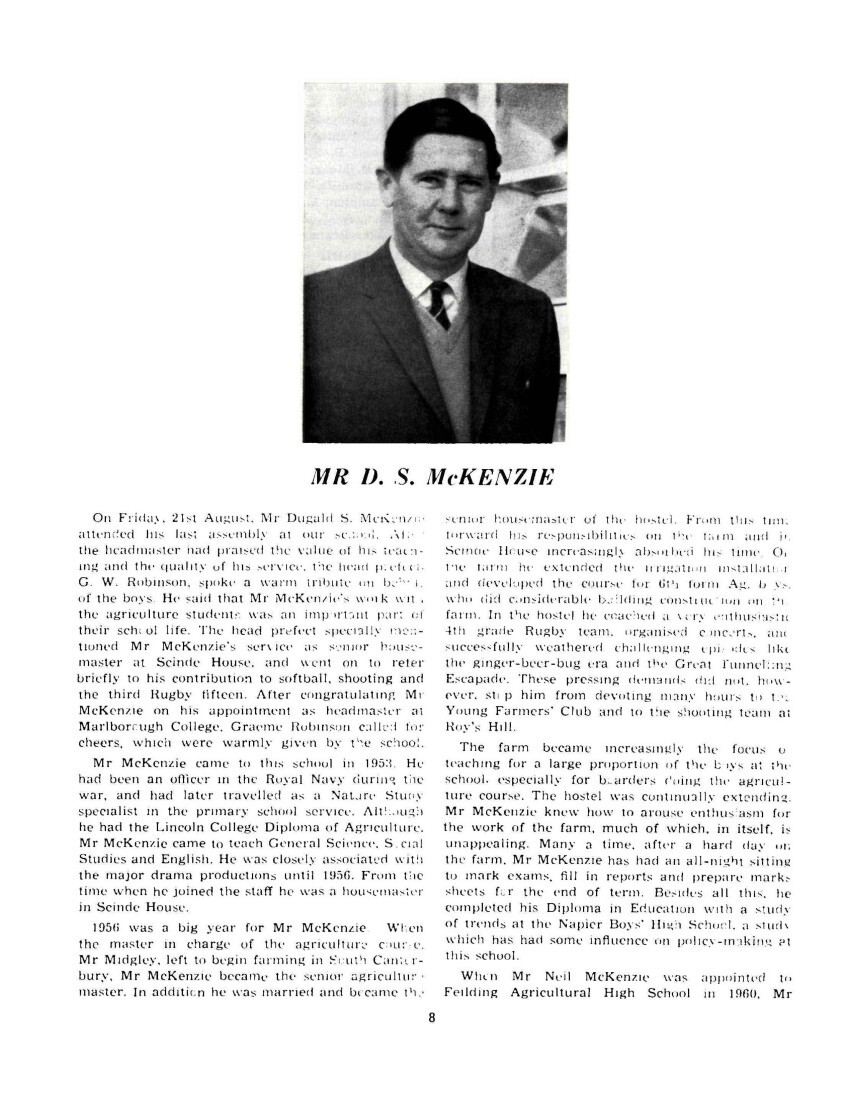
Page 9
McKenzie took over the work of farm supervisor as well as that of senior agriculture master. Shearing and wool-handling courses were extended. The new shearing shed was featured nation-wide by the National Film Unit. The agriculture course established a reputation of being one of the biggest and best in New Zealand. It would be true to say that its graduates during Mr McKenzie’s time honour and esteem the Napier Boys’ High School farm course.
As the pressures of farm business increased, Mr McKenzie became famous in the class-room for his unruffled good humour. In 1962 he left his position as senior hostel master, the work that he had enjoyed so much, and moved to a house on the farm. The farm cadet scheme was being planned and the piggery was being developed as an extra source of profit when Mr McKenzie was appointed to Marlborough College.
This boys’ school in Blenheim (roll: 664) has its own fine traditions and character. Mr McKenzie goes to be its head with a wonderful record of what he has contributed to the Napier Boys’ High School. He has been in charge of our boarding establishment during a period when its numbers doubled. He has headed the agriculture staff and farm, and has become one of New Zealand’s foremost authorities on secondary agricultural education.
We wish Mr and Mrs McKenzie happiness in their new home in Blenheim, and we know that they are enjoying the challenge before them.
N.B.H.S. ATHLETICS IN SARAWAK
We have all been very interested to receive news from Mr and Mrs H. A. Henderson, who have been at Tanjong Lobang School, Miri, Sarawak, since they left us at the end of 1963.
Mr Henderson heads the only school with a Sixth Form in the country. The school goes from Form I to the Upper Sixth, and there are 306 pupils, including 190 boarders. The hot climate does not encourage effort in the middle of the day. School starts at 7.45 a.m.; there is a siesta at noon; and games go on before the evening meal at 8.30 p.m. Our late headmaster is still improving at golf, which he plays in the cool of the evening. He mentioned the warfare with Indonesia and said that, although the border was three weeks away, Miri was garrisoned by British and Malayan troops. Those of us who know Mr Henderson’s rousing challenges to sport will be amused by the following sonnet, written by Tony Hung, a Chinese sixth form pupil, when Mr Henderson stirred up the boys to sporting endeavour. He sent the astonished scholars out to complete a mile run.
We had further proof that Tony Hung’s complaints had good foundation when a report appeared in The Daily Telegraph that the H.B. Rugby Union had sent two rugby balls to Mr Henderson, because their old one had worn out. Mr Henderson’s answering letter of thanks praised the fiery football of the proud native Dayaks, but hinted that he was actively prodding for more keenness among the Chinese and Malay students.
Read this sonnet to find out what it feels like to be a lethargic Sarawakian and have Mr Henderson descend upon you:
AN ATHLETE ON HIS FAILURE TO COMPLETE THE MILE
When I consider how my strength is spent
Ere half the mile, in this vast field and wide,
And feeble, trembling limbs which fain would hide
Lodged with me powerless, though my soul more bent
To serve my Alma Mater, and present
My true account, lest Henderson will chide,
“Doth he exact sports-labour, strength denied?”
I fondly ask. But conscience, to prevent
That murmur, soon replies, “He doth not need
Trophies, medals or silver cups. Who best
Exert themselves, they serve him best. His state
Is bossy: Dozens at his bidding speed
And jump o’er tracks and hurdles without rest;
They also serve who only cheer and wait.”
By TONY HUNG.
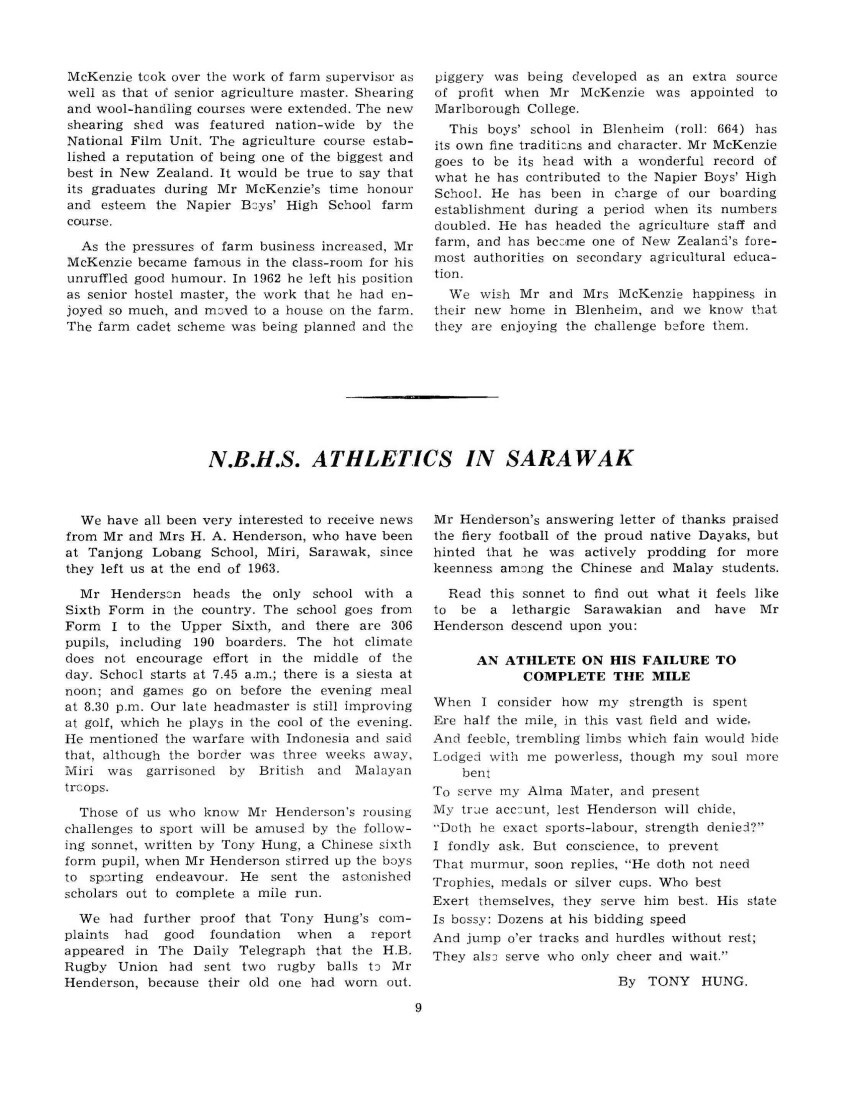
Page 13
Mr A. Smithson, B.A., Dip. Ed., came out from England a little more than three years ago as did Mr J. Hastrop, B.Sc., both masters being graduates of Leeds University. Mr Smithson has taught Senior Geography and English while Mr Hastrop has taken senior Science and Biology. We were aware that in all probability they would return to England at the end of their three year term of duty as teachers in New Zealand. We hope that they have enjoyed their stay in New Zealand but realise that the call of their homeland is strong. We regret that we cannot hold them longer, for their services have been greatly valued. Mr and Mrs Smithson together with Mr and Mrs Hastrop will be travelling in the “Orsova”. May they have a very pleasant voyage and carry away happy memories of their stay with us. As the shores of New Zealand recede we hope they will spare us the “passing tribute of a sigh”. We shall think of them often.
The sudden death this year of Mrs J. Bygate was a shock to us all even though we knew that she had not enjoyed the best of health for some years past. Our deepest sympathy goes to Mr Bygate in his sad loss, to his three boys, Peter, Neil and Bruce (who are well-remembered Old Boys of the School) and to his two daughters. We should like to express our sympathy too to Mr W. Tetley whose brother died very suddenly this year, to Mr J. Young on the loss of his father and to Mr Caird whose mother died this year after a very long illness.
To close on a more cheerful note, we are glad that Mr Pimm has made a good recovery from his spell in hospital last August and extend our heartiest congratulations to Mr and Mrs Pimm on the birth of triplets. We are delighted to know that the two boys and their sister are doing splendidly and that the proud parents are not too bowed down by the added weight of responsibility. We hope that the children will continue to thrive. We shall certainly follow their progress with the very greatest interest.
M.C.
TUCK SHOP
It has been announced that the tuck shop in the north-end cloak room of the Brick Building will be closed at the end of 1964. On a wet Monday the tuck shop has provided lunches for well over 200 boys, who have also enjoyed the convenience of being able to order their lunches.
Mrs Rowe, who has served in the tuck shop since it started, recalled that it was started in 1953 by the caretaker, Mr Sweatman, when the school was raising funds for the baths and gymnasium. Shortly after it was taken over by Mr Rogers.
Mrs Linton, who has been in charge for four years, said that she has had many happy contacts with the boys. The three ladies, Mrs Linton, Mrs Rowe and Mrs Larsen, are sorry to be going. They will look back on the well-known frightening rush at 10.30 am. They have always been glad to see Old Boys who come back for a chat.
One of the boarders said: “Mrs Linton has been very generous in keeping the tuck shop open so late in the afternoon and on Saturday mornings.”
A spokesman for the apprentices said: “The tuck shop has been very convenient for lunches. We thank the ladies for the service they have always given us.”
J. A. Piper, speaking for the prefects, said: “The whole school is grateful for the extra hours of work that Mrs Linton and her assistants have put in. They have always shown particular favour to the prefects on tuck shop supervision. We might even call this devotion beyond the call of duty.”
We close this appreciative note by expressing sympathy to Mrs Linton concerning the death of her son, W. A. Linton, who was at our school 1954-1955. He was accidentally killed on the 26th December, 1963 at the Wanganui Motor-Cycle Racing. The news was especially distressing to all members of the staff who remember him at the school and in the First Hockey Eleven.
PARENTS’ LEAGUE
At the annual meeting of the Parents’ League, held at the school on the evening of Thursday the 5th March, it was the pleasurable duty of the League to welcome the new headmaster, Mr D. P. Caird, and Mrs Caird. The election of officers was as follows: President, Mr F. B. Baudinet; Immediate Past President, Mr J. Tucker; Vice-Presidents, Messrs S. Morrin and V. Knight; Secretary, Mr M. McSporran; Treasurer, Mr J. D. Olsen; Convener of the Ladies’ Auxiliary, Mrs F. Douglas; Committee, Mesdames Campbell, Bull, Baudinet, Smith, J. Godwin, A. B. Godwin, Stitson, Nolan, Hanlen, Danks, Bateman, Darragh, Heath, Knight and Frame; Messrs Taaffe, Darragh, Manson, Smith, Bowling, Winter and Campbell. After the formal part of the meeting, the headmaster spoke to parents and answered questions. The hostel choir also sang several items.
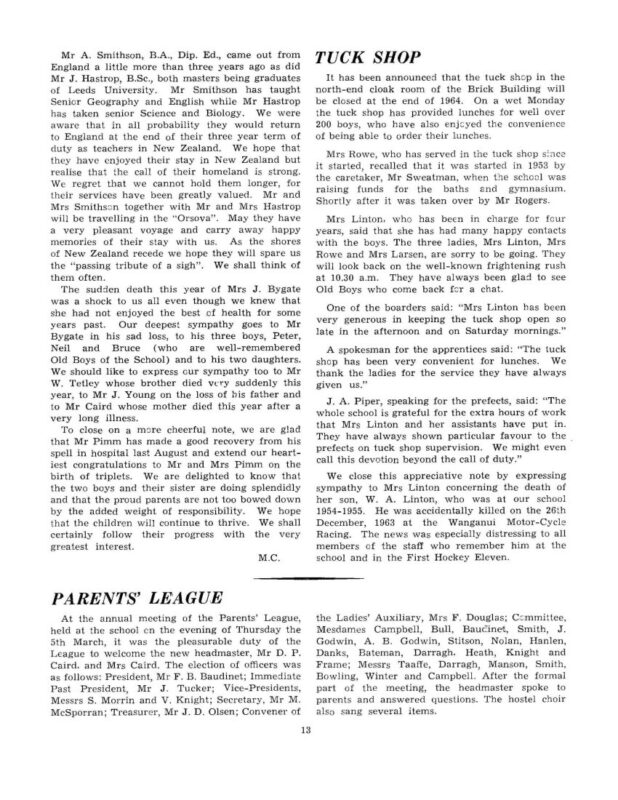
Page 17
Prefects’ rooms, lockers and the replacement of the prefabs would be included in this plan.
Members of the Board have been active in visiting the School. Dr Berry attended the assembly of the 5th February to welcome the new headmaster. Mr Edwards inaugurated the planting of shrubs on the 3rd August in the presence of His Worship the Mayor and other Board Members. Mrs Lucas, Mr Lewis and Mr Roach have attended assembly when visiting the School for Hostel or Farm Committee meetings. The School appreciates that Mr H. Johnson has often come down to give frequent assistance as Secretary to the Board.
TREE PLANTING
A large number of trees were planted along the Chambers Street frontage behind the Assembly Hall and to the west of the tennis courts during an Arbor Day ceremony on the 3rd August. Guests of the Headmaster, Mr D. P. Caird, were Mr J. G. Edwards, M.P., chairman of the Board of Governors, and Member for the District, Mr P. Tait, Mayor of the City of Napier, representatives of the Board of Governors, the Parents’ League, and the Napier Tree Society.
Mr Edwards told the assembled school about the respect for trees that he had seen overseas. Mr Tait explained the aims of the City Council in planting 2000 to 3000 trees per year in Napier. Mr Caird replied, thanking the City Council for considering this school a good area for growing trees. After these speeches, members of the official party planted a group a trees beside the driveway from Chambers Street. Members of the staff, prefects and class captains planted the rest of the area with a variety of trees and shrubs.
The trees have since been staked and tied. Some of the smaller shrubs have found the conditions too dry. As it is no longer possible to mow the area, the control of weeds is a problem, not helped by the fact that the builder’s sheds for the assembly hall alterations have encroached upon the planted area. Some of the bushes are already growing very strong and tall. If they are kept hard pruned, the area should develop into an open, neat shrubbery.
VISITORS TO THE SCHOOL
During past years, the school has always been privileged with the visits of many different personalities. There have been visitors from many different parts of New Zealand, and even from overseas countries. This year a new system was introduced in which many parents of pupils were also invited to the morning assemblies. I am confident that this has been a great success and should certainly be carried out further in the years to come. Well-known Napier personalities, e.g., Mr Arch Barclay, Miss W. McCarthy, Rev. Hay, were also invited to attend morning assemblies, and so our school has indeed been well catered for with a variety of visitors this year.
JAPANESE STUDENTS
The school was strangely quiet on the morning of April 27th, as four Japanese visitors made their way on to the stage of the hall. Most certainly, the attention of the school was focussed on the traditional kimonas [kimonos] worn by the four attractive girls. Each of the girls were students of universities of Japan, studying English, Spanish and Japanese literature. During their spare time in Japan they taught English at various places so as to earn sufficient money to bring them to New Zealand. The aim of their visit was to improve their English and also to gain a greater understanding of New Zealand and its customs. This was aided with the fact that during their tour of this country they were given accommodation in private homes throughout New Zealand.
Mr P. Knight, a member of the staff and also of the Napier Japanese Society, was their host during their stay in Napier.
In assembly, the quartet entertained the school with a bracket of four Japanese songs, including the well-known “Suki Yaki’”. The remainder of their morning was spent in attending several classes.
MR T. YOUNG
A former lecturer of music in Wellington, but now retired, Mr T. Young, paid two visits to the school. The first was from May 4-8, and the second was from August 11-14. Many pupils remembered Mr Young for the series of music broadcasts for primary schools, which he conducted a few years ago. During both visits to the school, Mr Young showed a personal interest, particularly in the music department. He attended most music classes, often conducting the actual lessons himself. He introduced several new ideas on musical appreciation, especially designed for the teenage youth.
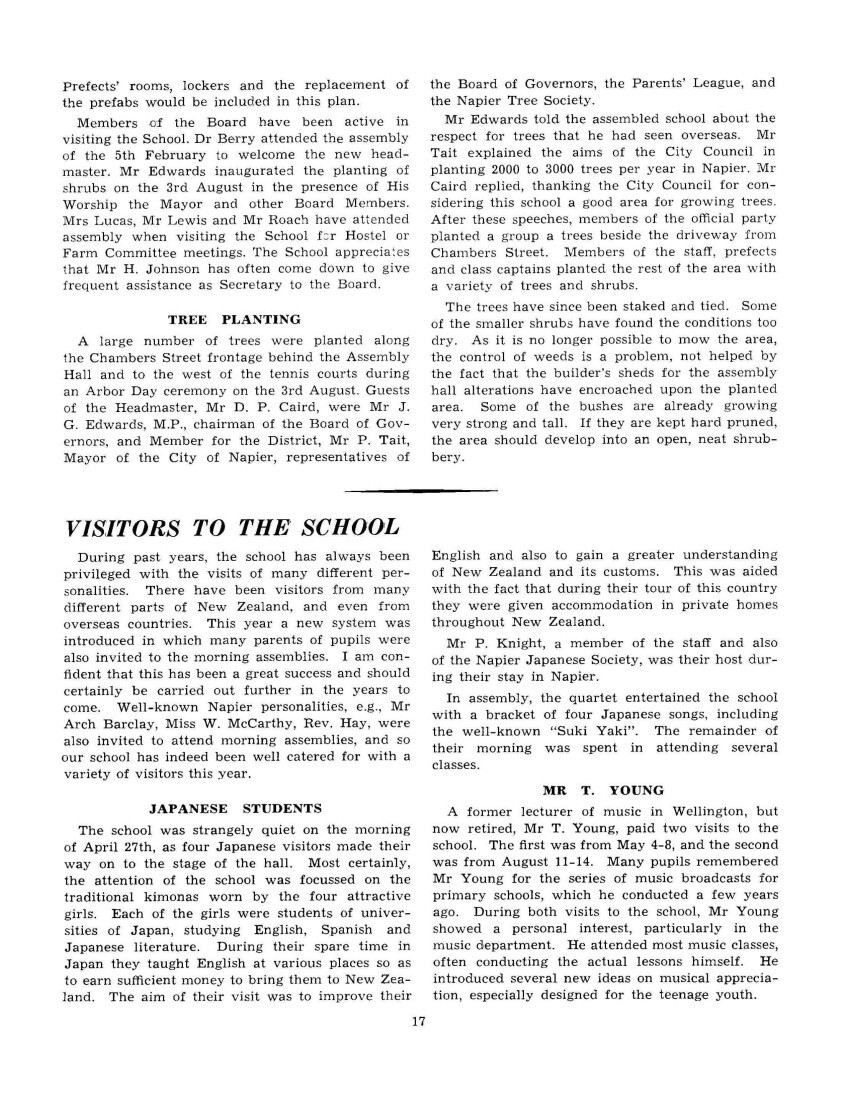
Page 18
SCHOOL DEBATING TEAM
Standing: M. McSporran, S. Nation.
Seated: G. Robinson, Mr B. G. O’Connor, D. Kerr (Leader), J. Scott.
DEBATING AND PUBLIC SPEAKING
SENIOR DEBATING CLUB
This year’s Senior Debating Team was D. Kerr (leader). G. Robinson. J. Scott. M. McSporran and S. Nation. Several Debating Club meetings were held on Friday afternoons after school during the second term. As usual, the debaters were also involved in winter sport, and could not always give time to debating as they would have liked.
Gisborne proved too strong for the school team. Kerr, McSporran and Robinson, who had taken the negative side of the proposition “That racial discrimination exists in New Zealand,” The team travelled to Palmerston North with the First Fifteen, and debated on the topic that New Zealand should continue to promote the development of Secondary Industries.” We lost the debate by 240 points to 215. On the last Wednesday of the second term, the team travelled to Hastings for their final debate. The subject was “That the formation of the Indecent Publications Tribunal is a denial of Liberty.” The team was Kerr, Scott and Nation. Hastings won the debate.
Our school teams debated against proved and worthy opposition. We must congratulate all our opponents. The encouragement and advice of Mr B. G. O’Connor during the year enabled our teams to acquit themselves well, even though they were not victorious. With three of the debating group returning to school next year, and with many other promising junior debaters, it seems likely that debating will continue strong in our school.
JUNIOR DEBATING CLUB
Third and fourth form debaters met during the second term on Wednesdays from 3.30 to 4.30. Attendance grew to sixteen, mostly fourth formers, but we welcomed four or five regular third formers. R Longney was elected chairman, and S. Revell secretary.
The group developed very much and very fast. We began with three round-table discussions. All who were present contributed some lively remarks to our discussion on “Advertising and Cigarette Smoking.” We proceeded to two formal debates. The debate “That Napier is Spending too much on Sea-front Improvement” was particularly lively
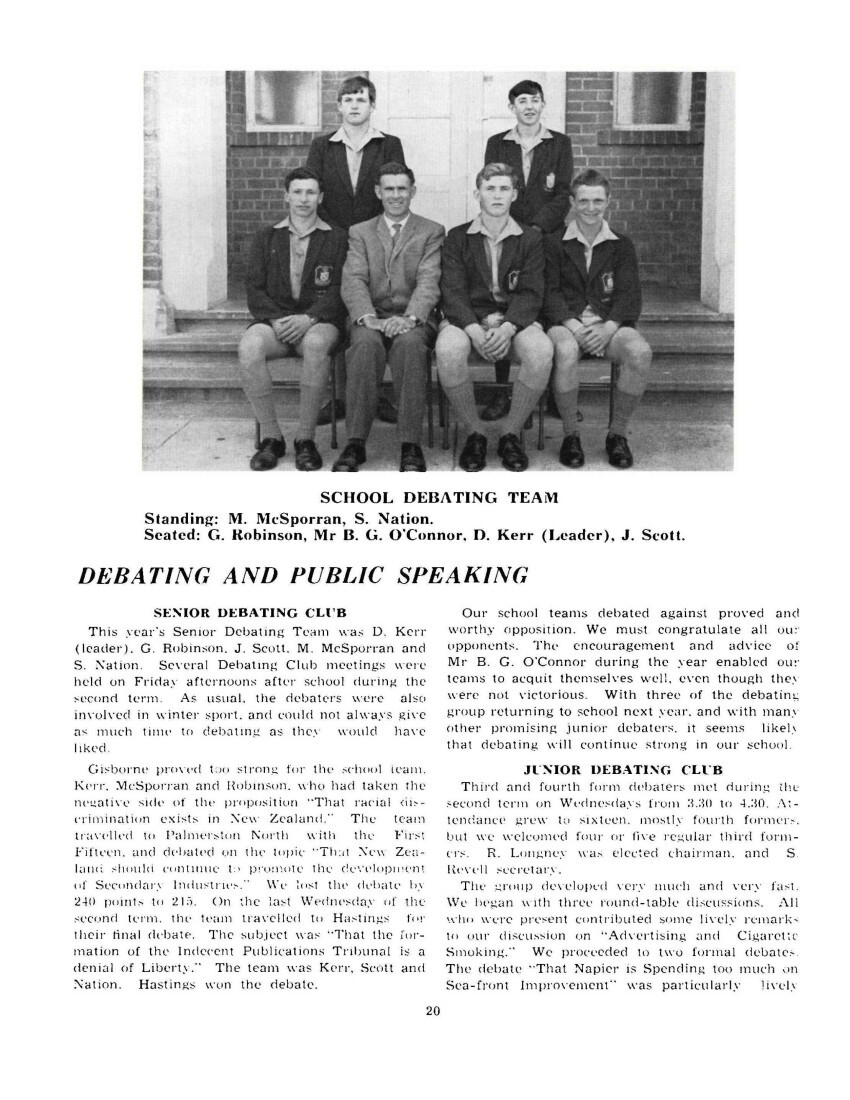
Page 21
and successful. Finally, there were three-minute speeches to select members of a team for a debate against the Girls’ High School. R. Longney, R. Tuck and N. Fenwick won the trials. Unfortunately, because of preparations for their end-of-term concert, the Girls’ High School could not accept the invitation.
This year’s Junior Debating Club has revealed some promising and keen debaters. We thank Mr Mundy for attending our meetings.
SENIOR IMPROMPTU SPEAKING
The Senior Impromptu Speaking Contest took place in our Assembly Hall on 17th September. Ten speakers took part, choosing one of three topics that fell to them by chance, with three minutes to prepare, and three minutes to speak. The judge, Mr D. P. Caird, placed M. McSporran first, J. L. Scott second, M. Howell and D. Kerr third equal.
Most speakers kept to safe, factual topics. McSporran, who was practically the only one to choose an adventurous topic, spoke on “What I like or dislike about the Beatles.” He said that this popular musical group was a sign of the times, when teenagers are absorbed in music, money and material possessions. He disliked their cynical attitude to some of their young fans and interviewers in New Zealand, but he praised what the Beatles have done for Britain in the world, and what they have done for teenagers.
JUNIOR IMPROMPTU SPEAKING
This took place in the Assembly Hall on 24th September. It was judged by Mr Revell. who placed R. Wright first, P. Leslie second, and R. Longney third. Ten boys took part, and their comments were in every way more colourful and uninhibited than in the Senior contest. Wright spoke with a comical air of apology on “Bad Habits.” He did his best to excuse the habits of chewing in the classroom, fiddling with your ruler in Maths, putting your hands in your pockets in winter, and biting finger nails to remove the nicotine.
SENIOR PREPARED SPEECH
The Scinde House Lounge was the gathering place for the Senior Prepared Speech Competition on the morning of the 5th November. Out of eight speakers, four spoke on Racial Discrimination, and three of these speeches came in a row. It was with the perfect agreement of the audience that Mr Roy Peach, the judge, commented, “Racial Discrimination unfortunately continues a favourite.” Mr Peach, who is a lawyer and an old boy of the school, placed M. McSporran first, S. Nation second, and J. Howell third. McSporran, speaking on “Racial Discrimination,” certainly covered material that the others had never thought of mentioning, and impressed very much as a public speaker. In both speech competitions this year, M. McSporran has been the only fifth former competing among sixth formers, and has won both events. Mr Peach congratulated J. A. Piper for his talk about the Laser Ray, but regretted that it was a lecture rather than a public speech.
At the conclusion, our Headmaster, Mr Caird, and our Head Prefect. G. W. Robinson, thanked Mr Peach for giving up his time amid the demands of the lawcourts.
ANTHONY EDEN CUP
The title this year was: “What can Youth suggest to encourage Commonwealth Cooperation?” Our school representative. S. I. W. Nation, spoke in the H.B. Finals at the Red Cross Hall, Napier, on July 23. The winner, who came from Hastings Girls’ High School, went to the Dominion Finals in Timaru.
D.D.K.
Mouth in Action
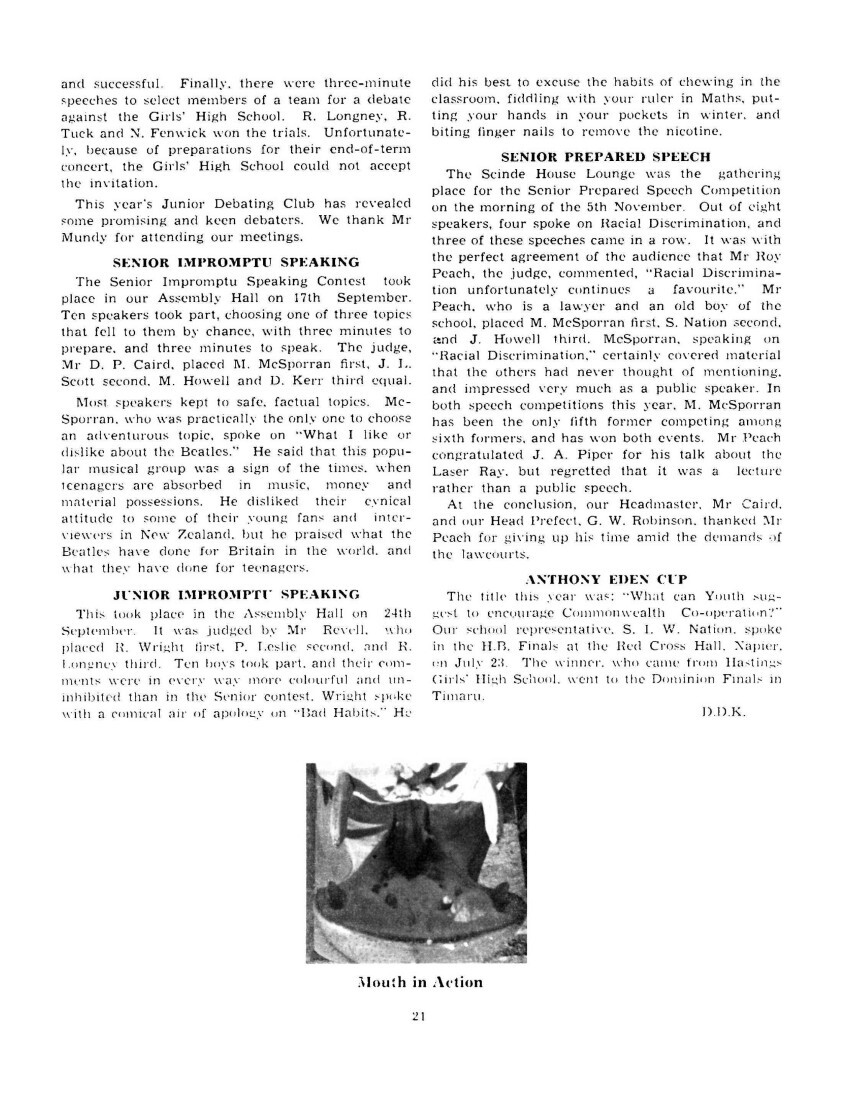
Page 22
6A NOTES
‘Of course, we had odd dizzy spells’
6A this year exceeded one score!
We had our teachers gasping for more
Breath to balance our working rate.
We know they’ll be glad when we migrate.
Scholastically we did quite well –
Of course, we had odd, dizzy spells.
But overall this 6A fair
Had a most successful year.
Now to introduce us all –
Robert Dallas is our first port of call.
He became a day boy and to his delight,
Discovered day was day, and night was night.
G. L. Dick is our hockey fan,
But maths he cannot understand.
George R. Ebbett, an ambitious boy,
Perhaps with his problems he’s a little coy.
Ferguson is no scientist,
But with his arts he’ll make the “list”.
Our man Higgens works very well,
In every subject does he excel.
Jackson this year sits no exam,
But will work next year for his bread and jam.
Tony Kay from England afar
Is our favourite soccer star.
Russell Kells studies biology,
Loves his Girl’s High ecology.
Donald Kerr our studious mate,
Thinks Australia is simply great.
Our sole life-saver in the class
Is Ralph Lee, with his solid mass.
Colin Lum is two of a kind,
He’s a musician and basketballer combined.
Roger Malcolm caused a disaster,
In every subject he baffled his master.
Witty Jim Piper is a scholarship-sure,
No exam pains does he endure.
Bulgarian-born Pishief runs quite well,
Perhaps another Peter Snell?
Eric Robinson gets in our hair,
Trumpeting his “Londonderry Air”.
Graeme Robinson, the head of the school,
Believes in fun and playing the fool.
Sadler’s life is full of statics,
Still, he enjoys his mathematics.
Sherwood is our muscle man—
Can row a boat, kick a ball, or do a handstand.
C.B. Smith is always swotting,
From English prose to scientific plotting.
You’d think Turner had no time for games,
He’s too busy constructing nick-names.
Wilson is our hawk-eyed boy,
Shooting is his greatest joy.
And so we end this list of names;
But there is one more, a very special friend,
Who left us for canoeing over Show week-end.
Kev. Weston bravely met the tragic morrow,
And touched our lives with lasting sorrow.
C.L.
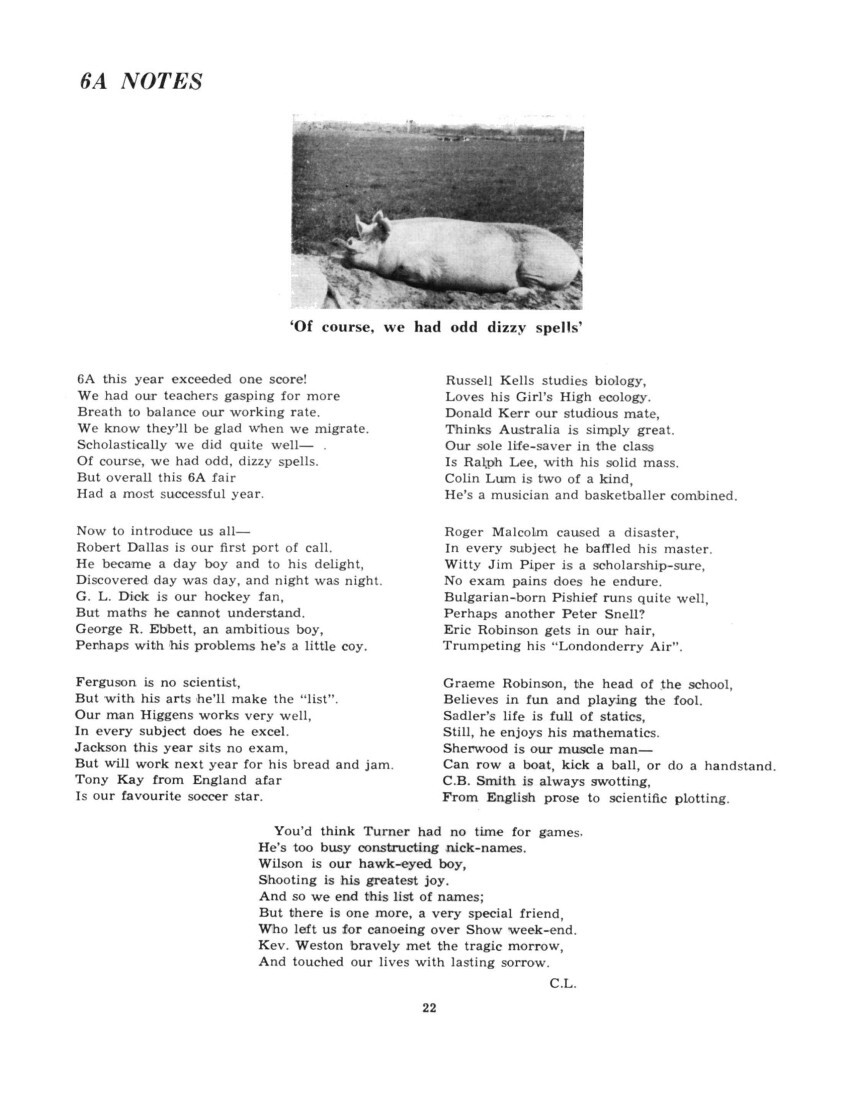
Page 23
MEMORIAL LIBRARY
“The consulting room of a wise man is a Library.”- Dawson.
The Memorial Library is the reference and reading centre of the School. Every effort is being made to provide extra reading material for all subjects of the curriculum as well as supplying recreational reading at all levels. With the increased cost of books and the vast amount of new publications the problem of book selection becomes increasingly difficult but it is our aim to cater for as many as possible.
Every English class except the sixth form is timetabled for a Library period but the time is rapidly approaching when additional rooms will need to be added to cater for other classes wishing to use the Library for research work. Also with expanding numbers in the Senior School provision will have to be made for facilities for study quarters for independent research. The Library must not be a mere depository of books but an integral part of the learning and teaching facilities of the School. The Library has been used for meetings by a number of teacher organisations and by some School Clubs. It is a place of which every boy should be proud, and it is hoped that every boy in the School takes time to appreciate the sacrifice made by the Old Boys for whom the Library is a Memorial.
“Their name liveth for evermore”.
During the year we have added 426 new books to the stock bringing our total to 9102 books. We are grateful for 73 books presented by Mr N. Harris, Australian Department of the Interior, French Legation, Mr R. Mundy, Atlantic Oil Company, Mr G. Walsh M.P., J. N. Anderson & Son, Ltd., Naval Board, Longmans, Green & Co. Ltd, Heinemann Ltd., Theosophical Society, Mr G. Fitzpatrick, Internal Affairs Department, S. Nation, K. McClure.
We also acknowledge gratefully the gift of a new set of the Encyclopaedia Britannica.
The 5/- donation system continues to develop and we acknowledge the following – M. Collins, L. Watkins (4), G. Dale (2), C. Frame (2), R. Masters (2), W. Nicholas (4), W. Larsen (4), R. Tucker, J. Irwin (5), A. Schmidt (4), J. Isles (4), K. Barnes (4), G. Williams (2), P. Thomas (4), J. Bee (4), J. Stayt (4), J. Ferguson (4).
While it is recommended that boys leaving should donate the refund they receive on the return of their text books it is hoped that other boys will show their appreciation of the services of the Library by a gift of 5/-. Books purchased with this money are inscribed with the names 23 of those who made the purchase possible. Sixteen non-fiction books were purchased through this scheme and now provide a permanent gift for use by others.
Further books have been added to the Foster and Holt Memorial Shelves and a collection of Senior English and Technical Books is being established.
Of the new books purchased 70% have been non-fiction and divide as follows – English Language and Literature 20%, History 12%, Science 12%, Reference 12%, Travel end Biography 10%, Sport 6%, General Arts 6%.
Extensive use of the Country Library Service facilities has been made and 914 books have been borrowed on the following topics: Senior reading, Junior reading, hobbies, geography, music, woodwork, agriculture, social studies, French, sports, stamp collection, animals, as well as individual requests on a variety of subjects.
Our total issues for the year continue to increase, reaching a record of 17,723 books, of which 56% have been non-fiction. The non-fiction issues divide as follows: Science 12%, Travel and Biography 9%, History 8%, English Language and Literature 8%, Social Sciences 7%, Sport 6%.
The Library assistants have once again performed an outstanding service to the School. They have all contributed unselfishly of their time and energy and have worked well under the Senior Assistant – S. Nation. Without their assistance the Library would cease to function as an efficient unit because the demands on Library services are so diverse that the Librarian and Assistant Librarian are fully occupied with administration and organisation. The main services handled by Library Assistants are the daily housekeeping of shelves, checking stock, repairing books, organisation of reserve system, processing new books, checking and packing Country Library Service loans, and tracing material for special topics. Book repairs occupy the greatest amount of time, 758 were repaired or reconditioned this year, so that the standard of our book stock is maintained at the highest possible level. Form Librarians are also an indispensable part of our system, they handle all class issues and returns.
The work of the Library Staff has been helped greatly by additional shelving fitted in the workroom, giving better facilities for “Stack” books, helping in the processing of new books, and better organisation for book repairs. The linoleum replacing the old cork flooring has added greatly to the appearance of the workroom. We are grateful to the Headmaster and the Governors for
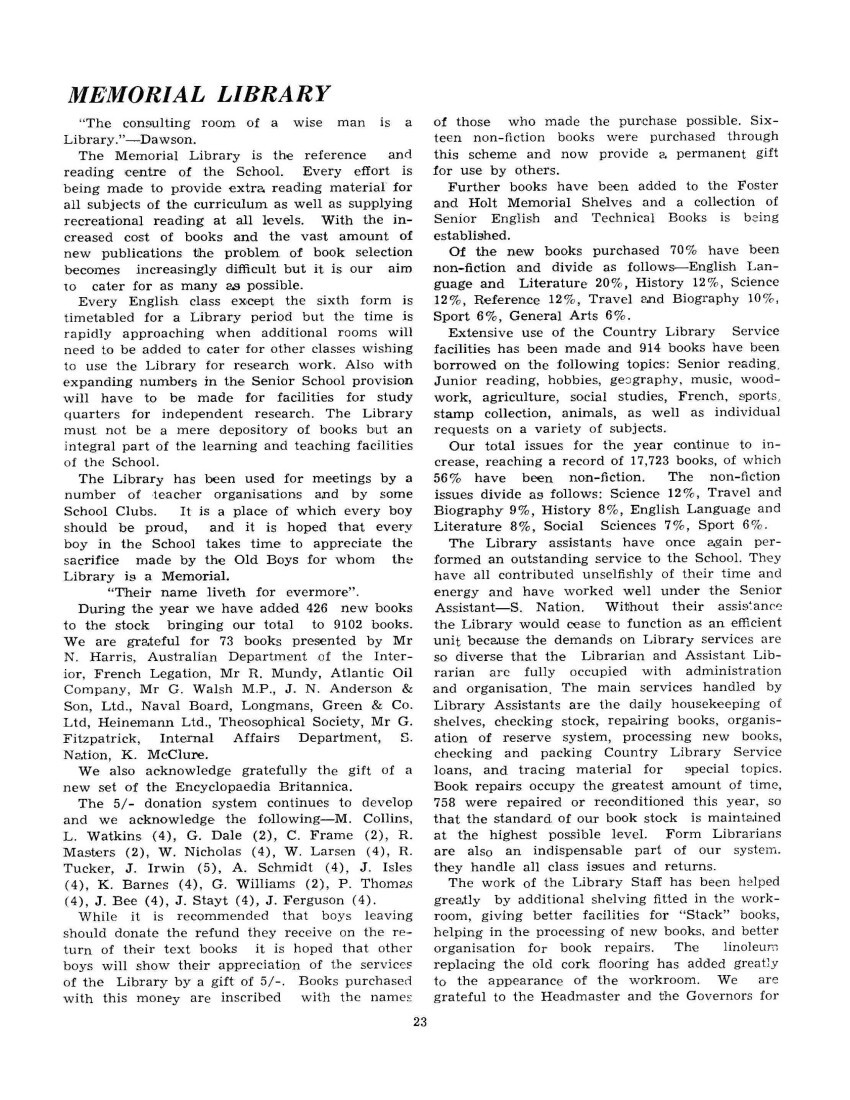
Page 24
making these improvements possible. We would also like to thank all those who have helped the work of the Library in many small and unrecorded ways, it is this sense of responsibility and cooperation that make the work of the Library so rewarding.
It is our hope that when a boy leaves school he will have received a sound training in Library procedures. We use The Bliss system of classification but as long as a boy can handle a catalogue he should be able to use any Library even if it uses the Dewey or the Library of Congress Classification. If training is given in an intelligent approach to books no boy need ever be lost or lonely in a Library.
“A Library is not a luxury, but one of the necessaries of life.” – H. S. Beacher.
Library Staff: Librarian, Mr A. T. Howlett Assistant Librarian, Mrs M. Brocklehurst. Library Assistants, S. Nation (Snr), G. Holdsworth (Deputy), P. Brown, W. McCorkindale, G. Phillips, R. Scott, R. Westerman, J. Ferguson, K. Smith, M, Smith, A. Masemann, A. Bowling, D. Cooper, G. Smith, K. West. The Prefect on Library Duty: R. Dallas. A.T.H.
MUSIC
The standard of singing in the school has greatly improved with the introduction of hymns as part of the School Assembly. In addition to hymns, songs have been used for special occasions. The school has been fortunate to have Colin Lum. 6A, as accompanist for assembly singing.
Also as a feature of assembly, items have been [been] given at regular intervals and we are grateful to the following: C. Lum, B. Ferguson, J. Ferguson, E. Robinson, R. Stevens, R. King, A. Masemann, who have entertained us so well. In addition we have had the following guest performers at assembly: Napier Girls’ High School Sextet, Colenso High School Madrigal Group, and Mr A. Barclay.
For the Anzac Service this year the school sang “Let Us Now Praise Famous Men” – Galway, and “Worship” – Martin Shaw.
A large number of boys attended a special schools concert by the Alard Quartet from Canterbury University held at Napier Girls’ High School and arranged by the Hawke’s Bay branch of the School Music Association. The Scinde House Choir gave items at a meeting of the Parents’ League. Items for Prize Giving this year will be: “The Spacious Firmament’ – H. Walford Davies, “The Lord’s Prayer”- West Indian Spiritual, “Raise Your Voices” – arranged Mitchell, as well as the traditional songs, “Forty Years On”, “Gaudeamus” and the two National Anthems.
The singing competition was held in November and the results were: 1st, E. Robinson; 2nd, R. King; 3rd, G. Phillips.
It is pleasing to note that large numbers of boys have attended musical performances in town both by local and visiting companies, and have realised the important part that music plays in community life.
A. T. H.
PIPE BAND
Our Napier Boys’ High School Pipe Band, wearing the Napier tartan kilt, appeared in public on three occasions, all during the first term. These were for the welcome to the Shirley Boys’ High School teams, for the battalion parade during barracks week, and for the Parents’ League on the 23rd April. The band gave a good display of marching, and played the airs “Rowan Tree,” “Bonny Galloway,” “Scotland the Brave,” and “Boys’ Brigade.”
Members of the band were:
Drum Major: Mr K. Flowers and later H. Trafford.
Pipe Major: G. R. Lydford.
Pipers: Sgt. T. Wharton, N. Struthers.
Drummers: Sgt. G. Warman, Cpl. G. Crarer, D. Caird, T. Karatau.
A number of younger boys are learning in Napier and will doubtless help the band to flourish when they come to High School. We thank Mr Mansfield, of the City of Napier Pipe Band, who has taught learners on Sunday mornings, and Mr K. Flowers for the time he has devoted to the band.
G.R.L.
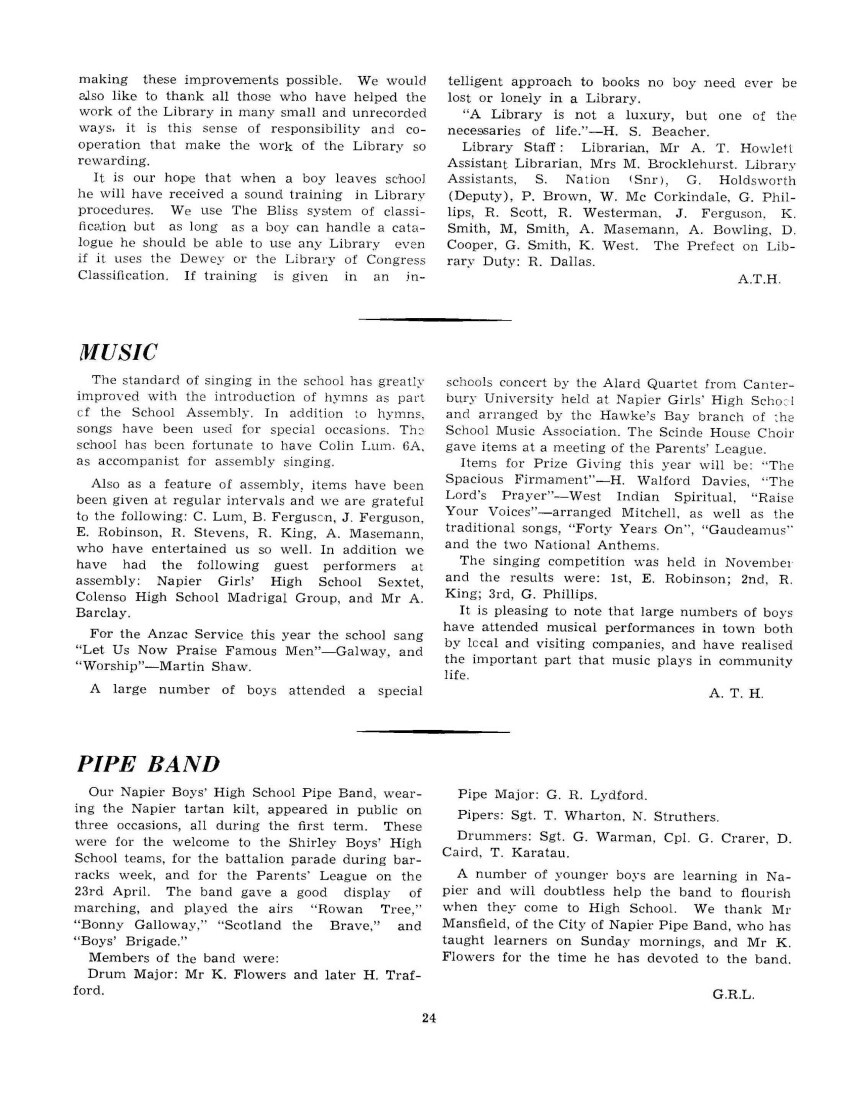
Page 25
CLUB NOTES:
ART CLUB
Under the guidance of Mr I. Roberts, the Art Club has continued into its second year, although not on quite so large a scale as last year. The club meets on Wednesdays and Fridays at lunch time in the art room, and any new members are always welcomed.
To cultivate an interest in art, a project this year has been to hang in the school corridors pictures painted by school pupils. A still larger collection of work, in various media, could be seen in the annual exhibition which came earlier than was expected. This resulted in a decrease in quantity, but not in the quality of the work.
Members would like to thank those who have given their time and efforts to assist the club.
T.K.D.
POTTERY
This year pottery has been part of the art syllabus for all forms. A kiln and two potter’s wheels have been provided by the Department at the cost of £200. The kiln is controlled by a German device which combines a time switch and a thermostat. It will raise the heat to 900 degrees centigrade gradually over a controlled time, keep the temperature constant for the required time, and then start to cool the kiln down at a controlled rate, so that it takes a day to cool. Even so, Mr Roberts has had to visit the kiln regularly on Sundays to keep two regular weekly firings going through this year.
Mr Roberts has successfully developed a glaze which will take on the local Havelock clay. Six colours are being obtained by the use of metal oxides. The boys acquire an understanding of the chemical processes involved in the glazing and firing, which is a rewarding experience.
The problem of keeping the unfinished pottery from one art period to the next has been solved by three frigidaires, which keep the moist pottery in a nice workable state until the owner comes again next week. Two local firms very kindly donated the refrigerators to the school.
“Pottery suits all abilities.” says Mr Roberts. “I don’t grudge going out to Havelock to collect the clay for the boys who are keen to learn.”
CRUSADERS
At our Wednesday lunch-hour meetings this year the average attendance has been thirty-five. The officers were: E. Robinson (Junior Leader), G. Pond (Secretary), J. Lincoln, R. Heiford, D. Ewart-Jones, E. Hodgkinson, R. Porter, C. Clark and G. Eagle. (Crusader Badgeholders). We are again grateful to Mr M. Yeoman and Mr R. Mundy for acting as leaders.
Seven visiting speakers have generously given us of their time. Two of these were particularly important to us. Mr Thompson of the Middle East General Mission was the first Crusader Leader at this school, twenty-five years ago. Mr Murray Lennox, who is departing to India as a Christian Youth worker, is an old boy of the school, and a former Crusader, who left in 1958.
Beside weekly Scripture studies, we showed five films from the Gospel Film Trust, and held three evening reunions with the Girls’ High School Crusader Union, the attendance at these being about forty. This year we have had faithful members from every form from third to sixth, contributing to the great spirit of the Union. Our motto for the year could be what Captain Coughlan, of the Church Army, said to us on the eve of his departure from Napier: “I think that committed Christian boys should be in every outgoing activity of the school.”
We would like to thank the prefects for ensuring peace and quiet in the corridor outside while speakers were talking to us. We are grateful to Mr Caird for allowing us the use of the film room for our meetings.
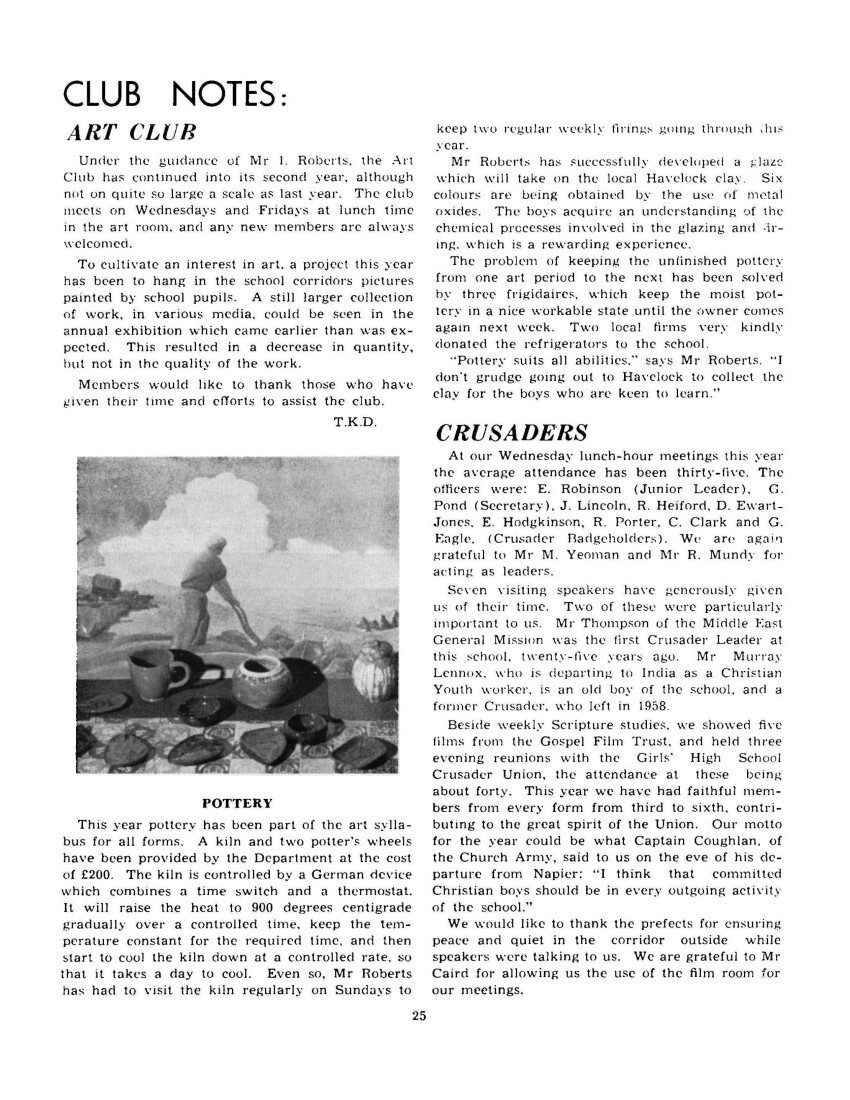
Page 26
Departure for Snow Camp
ANNUAL SNOW CAMP
On Friday, 10th July, nineteen Crusaders from our school tramped into the Ruahines, led by Dr Martin (of the Crusader Movement). Messrs Yeoman, Fraser, Mundy and Ivan Porter. We trekked up the Waipawa riverbed under falling snow and waded through the icy river dozens of times. After scrambling through scrub and down scree under the driving sleet, we crossed the saddle to come down a frozen cataract valley on the other side. On Saturday we did not go mountaineering as planned, since it took most of the time for the four groups (Yetis, Shirkers, Beatles and Weevils) to cook their meals with wet wood and fireplaces in the snow Mr Mundy’s group succeeded in getting a fire alight only for a few brief moments, and would probably have starved if the other groups who knew how to light fires had not let them cook over theirs. On Sunday we tramped back to the cars by 3 p.m. and reached home at 6 p.m. with plenty of aches and dirty wet socks. However, we had had a great time together.
M. Johnson and G. Eagle at Waikaremoana
ANNUAL SUMMER CAMP
About six members of our union are attending the summer Crusader Camp at Lake Waikaremoana, which caters for about 63 boys from all over the North Island. Graham Eagle, who was with Doc. Martin at this year’s camp in January, reports: “The night after we arrived, we began our annual ten-day contest with the wily opossum. There were at least thirty opossum traps placed strategically around the camp. At night it was death to enter the bush. For tea just about every night we enjoyed roast opossum.
“The thirteenth proved to be a bad day. Our raft which we built of rotten timber sank with all hands on board. It took about two days to clean the bay of debris, and canoes were constantly running into submerged masts. Operation Pancake consisted of a two-day overnight hike, also by canoe, sleeping in the bush with fern for beds, and feeding on a leathery variety of pancake cooked on the open fire. One boy, who didn’t seem to appreciate my cooking, took to eating cooked frogs!”
Cynthia Burr as Emily
Clive Bayliss as George
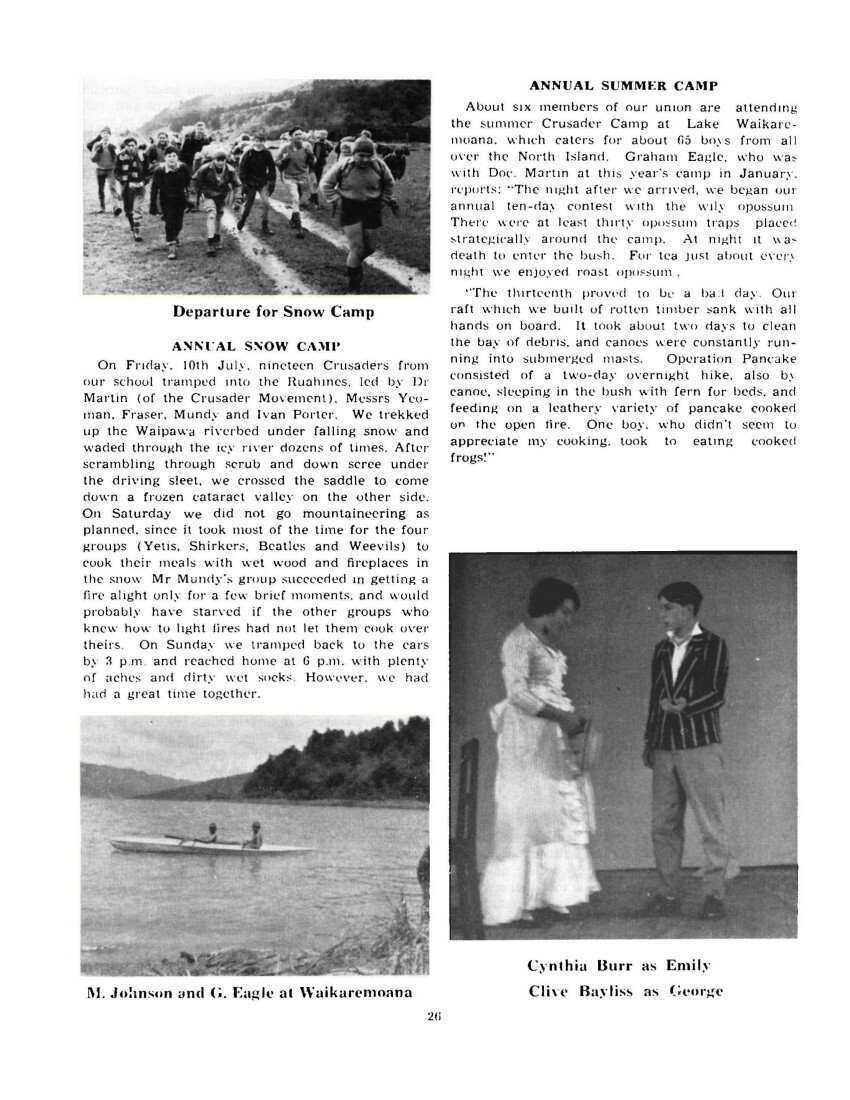
Page 27
DRAMA CLUB
Rehearsal of “Our Town”
For the second year in succession a combination of the talents of Napier Girls’ and Napier Boys’ High Schools resulted in an extremely successful production. Under the competent guidance of Mr Monrad, Miss Sproule and Miss Daniels, Thornton Wilder’s “Our Town” was greeted by both schools and public alike with unreserved enjoyment. Special thanks go to the make-up crew, to all who helped with scenery and costumes, and to the principals of both schools for their co-operation.
“The Axe and the Tree”, by A. J. S. Coppard, was also produced by Mr Monrad, with a cast of the junior members of the club. This was presented at a Parents’ League meeting and was very well received.
A spur to the club’s enthusiasm was provided by two touring groups. The first was a Shakespearian group: Desmond Lock, Sybil Westland and Ronald Barker; and the second was the N.Z. Players Quartet: Eric Wood, Raeburn Hirsch, Anton Low and Margaret Atherton. The N.Z. Players presented scenes from “The Lady’s Not For Burning,” “Man For All Seasons,” “Mock Doctor,” “Importance of Being Earnest” and extracts from Shakespeare.
The Drama Club has enjoyed a successful and profitable 1964, and looks with anticipation towards an equally enjoyable 1965.
R.T.D.
FRENCH PENFRIENDS
James Perquin
For nearly two years I have been corresponding with James Perquin, who lives in Frontenex, Savoy, France. James is a very keen sportsman. He goes in for soccer, swimming, Rugby, skiing and cross-country running. He has won twelve medals for skiing.
He often writes strange English, which makes me realise what my French must look like to him. When he wanted to tell me that his little brother was three and a half years old, he said, “Him is aff past three.”
James has sent me birthday and New Year cards printed in French, a little carved Swiss chalet filed with special sweets, and a little carved animal called a chamois, of which there are many in the mountains round about his home.
When James was telling me about the All Black tour of France, he mentioned that his father had been very good at Rugby, and had been at one time full-back of the French Fifteen. I have sent many cards and small presents to James in France, as it helps to keep the correspondence going.
N. A. Hazlewood, 4 Beta.
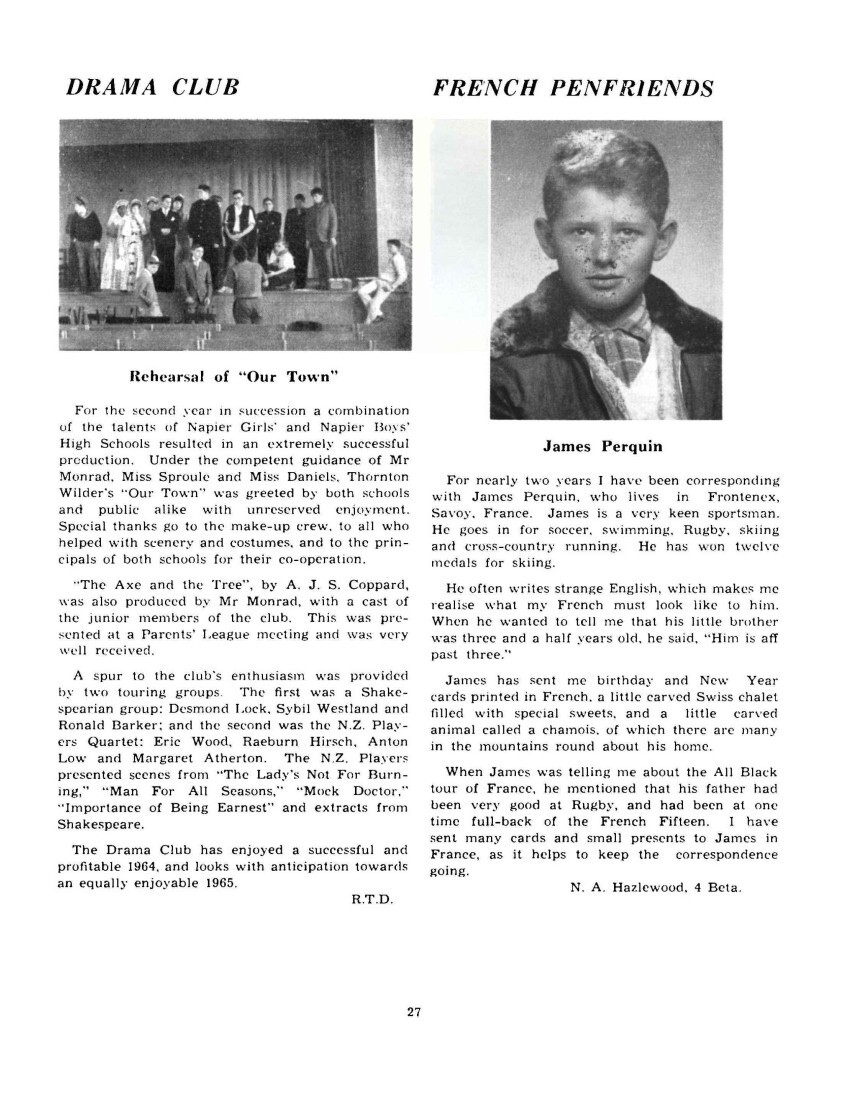
Page 28
Bernard Vignon
A French penfriend, what an abundance of knowledge you can gain from one.
My penfriend Bernard Vignon, 14 years old, lives in Gresy, a small town with 600 inhabitants, in the province of Savoie. Gresy is situated under the majestic Mt. Blane. His home is a flat over the post office in the Town Hall of Gresy.
His father works in a factory and his mother is the local postmistress at the Post Office. His hobbies are swimming, skiing, sports and collecting match-box toys.
He has sent me postcards of Lake Geneva, his home town, and of Mt. Blanc. Other items are a wide assortment of stamps and his photograph. To keep up regular correspondence, one must swop souvenirs and write regularly about topics of interest.
W. F. Mills, 4 Beta.
When a person takes French for a subject he is bound to achieve one ambition and that is to have a French penfriend. To maintain a good relationship you have to buy souvenirs, cards and many minor items, just to please the correspondent.
I have a penfriend. Her name is Josiane Bonnetier and she is sixteen years old. Her father is a car inspector in a Renault factory in Paris. Josiane’s main interests and hobbies are studying English, collecting stamps and she is also a keen cyclist and likes modern music. She is a supporter of the All Blacks and likes to hear their war-cry before a game.
Having a penfriend in another country widens your outlook and you learn more about the country than what you would do reading the papers.
You can see what I have gained by taking French for a subject.
M. W. Vaughan, 4 Beta.
YOUNG FARMERS’ CLUB
With over one hundred members the club has been particularly active this year, participating in many of the activities of the Heretaunga district, such as stock-judging, pasture judging and radio leadership. The debating team must be congratulated for winning the East Coast Council debating competition.
The committee for 1964 has been: R. H. Sherwood (chairman). P. R. Carney (vice-chairman), G. W Ebbett (secretary-treasurer). R. H. Nant (committee member). Three debating teams were entered in a knock-out competition for the Heretaunga district. The N.B.H.S. A team, comprising S. Nation (leader), D. Kerr and G. Robinson, won the district competition and went on to compete in the East Coast Council competition. The team met with strong opposition from Central Hawke’s Bay and Wairarapa teams, but were successful in winning the final – a truly commendable effort.
Monthly meetings were held in the Scinde House Lounge, all meetings being well attended by fifty members or more. Mr L. Rolls gave an interesting talk on Lincoln College and illustrated his talk with coloured slides. G. Ebbett and I. Beattie reported on the Rural School at the Waikato Winter Show. Mr J. Nott. from the Department of Agriculture, described the agriculture courses at the universities. Mr Crisp, of the Lands and Survey Department, spoke on land development. At a film evening, several films on farming topics and rugby tours were screened.
This year the N.Z. Young Farmers’ Federation has sponsored a Farm Safety Campaign, and our club has featured the importance of Farm Safety. H. Tennent has acted as our club Farm Safety Officer, and has given several reports on various safety topics to monthly meetings.
In August the club held a farewell evening for Mr D. S. McKenzie, our senior advisory member for several years. We are greatly indebted to Mr McKenzie for his help with club evenings, speakers and field days both at club and district level.
G. W. E.
Vandals have been going into cemeteries and belting up the grave-stones. They have nothing interesting to do in the week-ends and something should be provided. Instead of destroying other people’s grave-stones, they should be given something interesting to do. They should not be allowed to bash up cops: they should be given something interesting to do instead. Vandals are very good boys at heart. They should not be put away in jail; they should be told where they are wrong and given something interesting to do.
A. R. Tuck, 4A.
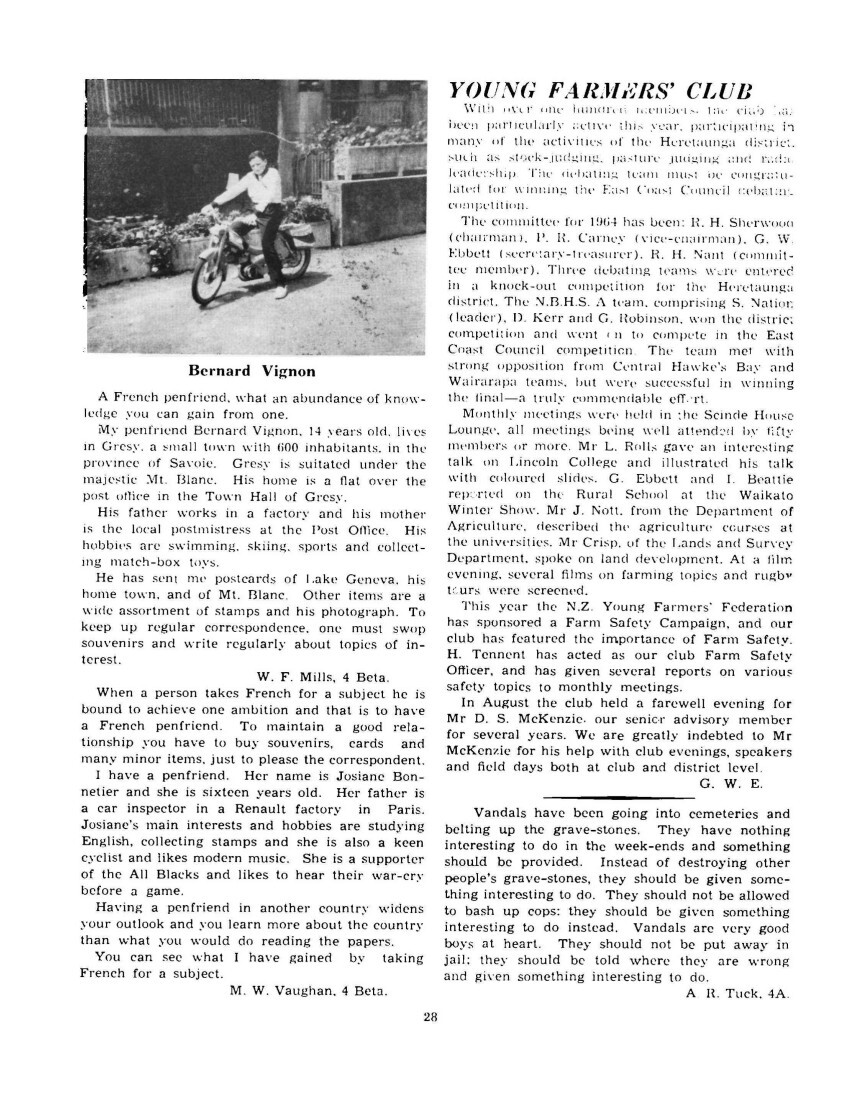
Page 29
4R SOCIAL STUDIES TOUR
At 9.30 a.m. on Monday October 5th. 4R left by bus for the district of Tokaanu for a week’s Social Studies trip. Class captain Albert Gray continues the story: –
As the bus rumbled up through the steep hills of the Taupo road, we saw where the road is being altered into a modern highway. We came through the pumice country and reached Taupo in time tor lunch. Straight afterwards we visited the surging Huka Falls on the Waikato River. Not many of the boys had seen them before and there were plenty of photos taken. Then we went on to the Wairakei geothermal plant. First, we visited the information office near the hissing steam bores. Then we went on to the generating plant. We made our way among the great concrete generator bases, all neatly painted yellow. It was almost impossible to hear explanations with the roar of high-pressure steam in the twisting pipes above our heads. The bus took us back round Lake Taupo to meet our billeters at Tokaanu School.
On Tuesday morning we met again at the school, and the bus took us to the trout hatcheries. We saw the four-days-old fingerlings, and we were shown the rainbow trout, with its big gullet, and the brown trout. Next, we saw the workmen herding the trout in the stream in order to get the eggs. The same morning we went near bush scenery to visit Fletcher’s timber mill. They showed us the logs being cut into 6 x 4 planks. Two men work at the great circular saws, sending the waste to the right and the good timber to the left. It is cut into lengths and sizes before being stacked outside for four weeks. We saw them machining the timber into weatherboards, and some being tanalised by being dipped for eight minutes in big vats. The timber is inspected and stamped and crated to supply a large area of the North Island.
We continued our way to the top of Waihi Bay for lunch. In the afternoon three Maori boys conducted us on a tour of Waihi Maori village. We saw the meeting house. They took us into the white church which looks over the bay, and we saw the two stained glass windows which show the Holy Family with Maori faces. We visited the chief’s grave, which was made like a little meeting house, painted white with a red roof. On the way back to Tokaanu some went for a swim in the hot pools and others went to see the hot mud pools.
On the Wednesday morning the bus took us round the south of Lake Taupo to the boating harbour at the entrance to the Waikato River. There we went on board the tourist launch and spent from 10 a.m. till 4 p.m. sailing round Lake Taupo. We stopped at the Kinloch boating harbour for lunch. The launch took us close up to the waterfalls and the Karangahape cliffs. In spite of the cool wind everybody enjoyed themselves. Again lots of photos were taken. Two boys bought fishing licences so as to fish for trout. Bob Reid caught two. The launch put us off at the Waihi boating harbour, where the bus was waiting to take us the short distance back to our billets.
Thursday was an enjoyable day of fun. We went by bus up to Mount Ngaurahoe [Ngauruhoe] past the Chateau Tongariro. It was a thrill to get into the snow at the ski-lift: some hired skis and got instruction. Others had snow fights down by the canteen. Great fun was had with sledges in the crisp, chilly snow, and some fooled around with snowmen. Before two o’clock we were in the bus again on our way back to Tokaanu.
On Friday at 10 a.m. we said friendly farewells at Tokaanu school, especially to our billeters and the headmaster. We crowded into the bus for home. Although we stopped at Taupo for a snack, by the time we got across the long dry plains, a crowd of hungry boys descended on the Tarawera Hotel for lunch. The bus made steady speed over the winding road where once it took three days to reach Napier from Taupo. At 4 p.m. we were back in Napier.
Here we give our thanks to Mrs J. Bulled who accompanied us, and Mr Knight who organised the trip.
Photo caption – A. Gray, Mr Knight, R. Reid
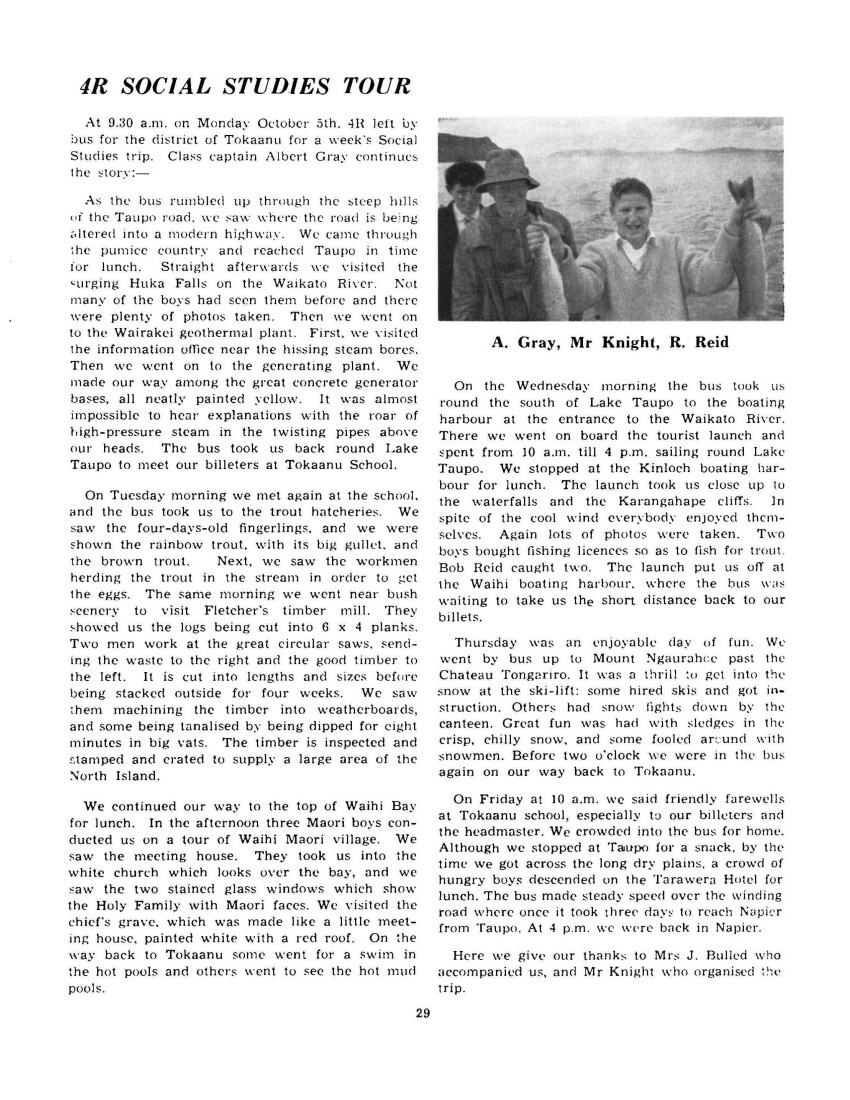
Page 30
MASTER FIX-IT
It is fifty years since Eric Battershill, a third-year pupil of our school, was taken to court in Hastings and prosecuted for using a wireless apparatus of his own making. This event of 1913 caused a big stir at N.B.H.S. where Battershill was hotly defended against the charges of being a criminal and the author of a misdemeanour. The N.Z. Press Association reported that Eric Battershill ran away to Australia in 1914 and became a millionaire.
Dare we hope for the same bright future for Kevin Donaldson of 4B? In the first six months of 1963 he assembled a TV receiver at home in his spare time. The set had a 2l-inch screen and cost £83. Kevin fitted it in a mahogany cabinet and, after it had been used by the Donaldson family for some time, he sold it to a friend. Since then he has built another set with a 23-inch screen, which gives the advantage of squared corners to the image.
After this experience, Kevin has found that he has sufficient knowledge to spot faults and fix TV sets. He has special equipment for voltage checks at certain points of the circuit, and is able to take graphs with an oscillograph, so as to see where the performance of the set departs from the normal type. At the present time, many sets are still under guarantee and people do not call in a serviceman. But Donaldson is often called on for emergency help at weekends and especially to repair sets brought back from Japan which people do not like to take to the radio repair shops. An average job takes him two to four hours, although he may be working at a difficult repair for two days. A common fault is with the linearity controls. When a picture goes unlinear, the head may appear as big as the body and the limbs put together.
This amateur TV man does not keep a stock of parts, but buys himself the parts that are required for repairs. Most parts cost under £5. He tries to charge a reasonable price, but he realises that he must not cause trouble with the shops by doing work for nothing. Most people are happy to pay him on the spot.
Having been interested in radio since he was in standard four, Donaldson is thinking of becoming a radio technician. It is the practical side of TV that he likes best. He realizes that he has yet to learn many other aspects of theory. He cannot start as a radio technician unless he takes a proper apprenticeship with the Post and Telegraph Department or in Broadcasting.
Donaldson still remembers the big moment when he plugged in his first set and waited to see what happened. At first the set gave no sound and no picture. He traced an unconnected wire which was causing the lack of sound, and then found a wrong connection to the picture tube. He then had to wait for the Hawke’s Bay TV translator to come into operation, and found that he had four pictures. one in each corner of the screen. This fault was traced to a wrong coil. The Philips Company in Wellington changed the coil, and then the set went well.
Kevin has his own motorbike. He finds it interesting to get round on different repair jobs and meet all kinds of people. He may even on occasions be seen deep in consultation with the Caird family about the efficiency of the second-channel TV aerial on the headmaster’s residence.
A freckled fourth-former, Donaldson already has an unflustered tradesman’s manner. His steady eyes turn in a slow smile, and his freckled sturdy fingers already look remarkably sure and patient. He works on an average for half an hour a night on TV work. He tries not to let it interfere too much with his homework and preparation for exams. “I do not often watch TV.” he says. “On an average I do about six to seven hours a week on my own TV work.” We hope that if this copy of the Scindian falls into the hands of the Hastings Magistrate, he will be more lenient than to Eric Battershill.
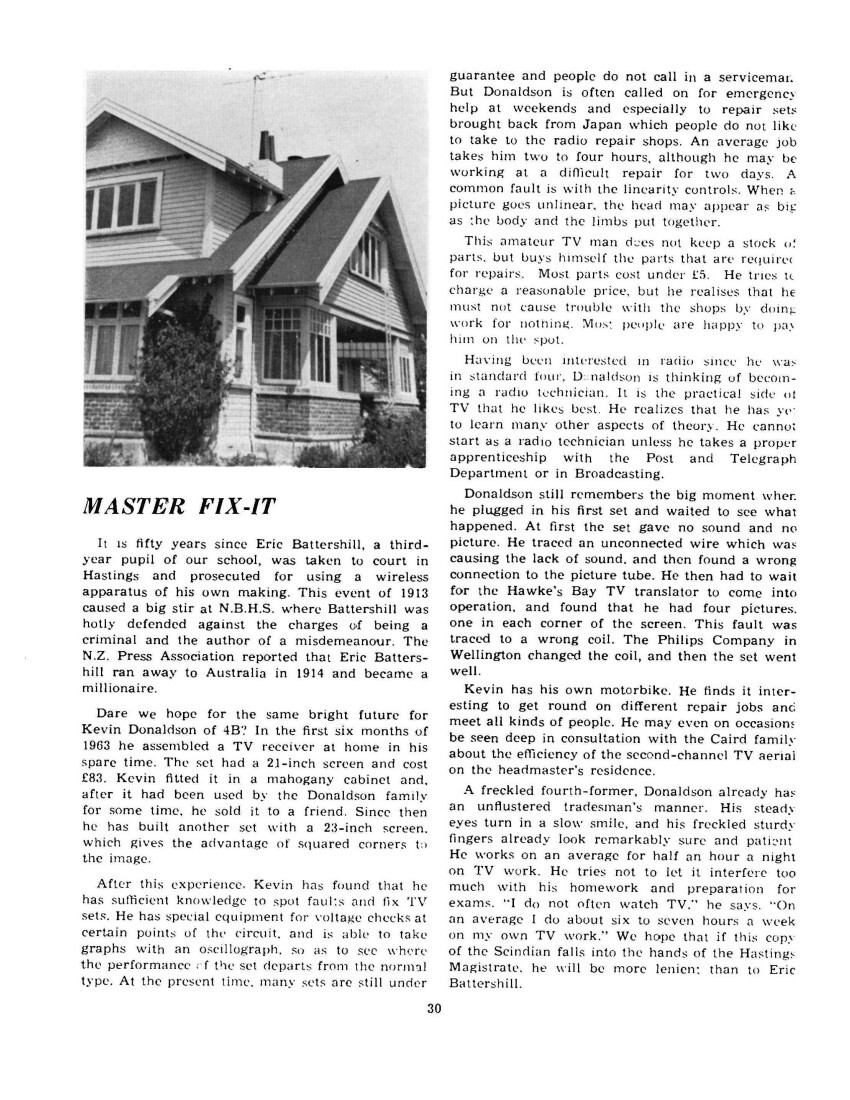
Page 31
AGGRESSION
At the Tauranga Memorial Hall on Saturday, 15th August 1964, Robert Young of 4B won the N.Z. Junior Amateur Flyweight Wrestling title. The Daily Telegraph said: “Young’s skilful application and strength enabled him to pin four opponents in the first round.”
Young, who weighs seven stone ten pounds, explained, “I started wrestling when I was six years old. My father knew Mr J. Lock of Napier, who is an official referee and judge. I had no brothers to defend me, so my father thought that I should learn to fight my own battles.”
Robbie Young belongs to the Napier Wrestling Club and thinks that he would not have got far if it had not been for his coach, Mr L. O. Wells, who was manager of the Napier team at the Tauranga Championships. Mr Wells, known to the boys as “Bomber”, was coach of the N.Z. Wrestling team that went to India.
At the championships, Young wrestled five bouts, the most of anyone at the tournament. He won against opponents from Christchurch, Palmerston North, Waikato and Auckland. Then, knowing that his title was already safe, he lost on points to an opponent from Wellington who became runner-up. Out of fifty competitors, Young was awarded the Lloyd Woods Shield for the most scientific wrestler at the championships, presented by the chairman of the N.Z. Wrestling Association.
Mr Wells instructs his boys never to fight outside if they want to keep on the right side of the Wrestling Association. “The holds you learn,” says Young, “are not to hurt but to get someone on the mat in the quickest way possible.” Wrestling makes you think and concentrate before you do a hold, and it is good for youth to learn to think before they go into things.
Robert Young, who is five foot one in height, wiry and light for his fifteen years, is popular with the fourth formers. He plays rugby in winter and keeps fit by training hard. Before the championships, he ran round Napier Hill each night, wrestled four nights a week, and trained on Saturdays. He constantly reads wrestling books. In the summer he goes in for cricket, indoor soccer and swimming.
In all his wrestling, Young has lost only one bout, and that was on points. His coach recommended that he should keep in view selection for the flyweight wrestling in the next Empire Games and Young is willing to give it a go.
Wong Soo
BENTONG
My home town of Bentong is in Malaya, situated some 45 miles north-east of Kuala Lumpur, the capital of Malaysia. The road to Bentong runs from the better developed West Coast, ascends the central ranges through breath-taking scenery of tropical jungle and deep valleys, then slopes down through rubber plantations.
The town was built at the beginning of the century, when tin deposits were found. The tin was mined out in a short time, but since then the town has grown into a fairly prosperous centre of rubber and timber production. The shops are found in two-storeyed brick buildings with a long porch along each block. Clustered in a semicircle across the river are five villages with long rows of wooden houses.
Almost all the people in the villages are rubber-tappers. They work at the rubber plantations all round the town and along the main roads. At 5.30 a.m. the town comes to life. Workers stream out of the villages in the cold early-morning mist on bicycles, motor-scooters and lorries. They are going out to rubber estates from one mile to fifteen miles away.
If you were to go into a class of thirty pupils in an English school, fourteen would be Malay, twelve would be Chinese, three would be Indian, and sometimes one or two would be Eurasian.
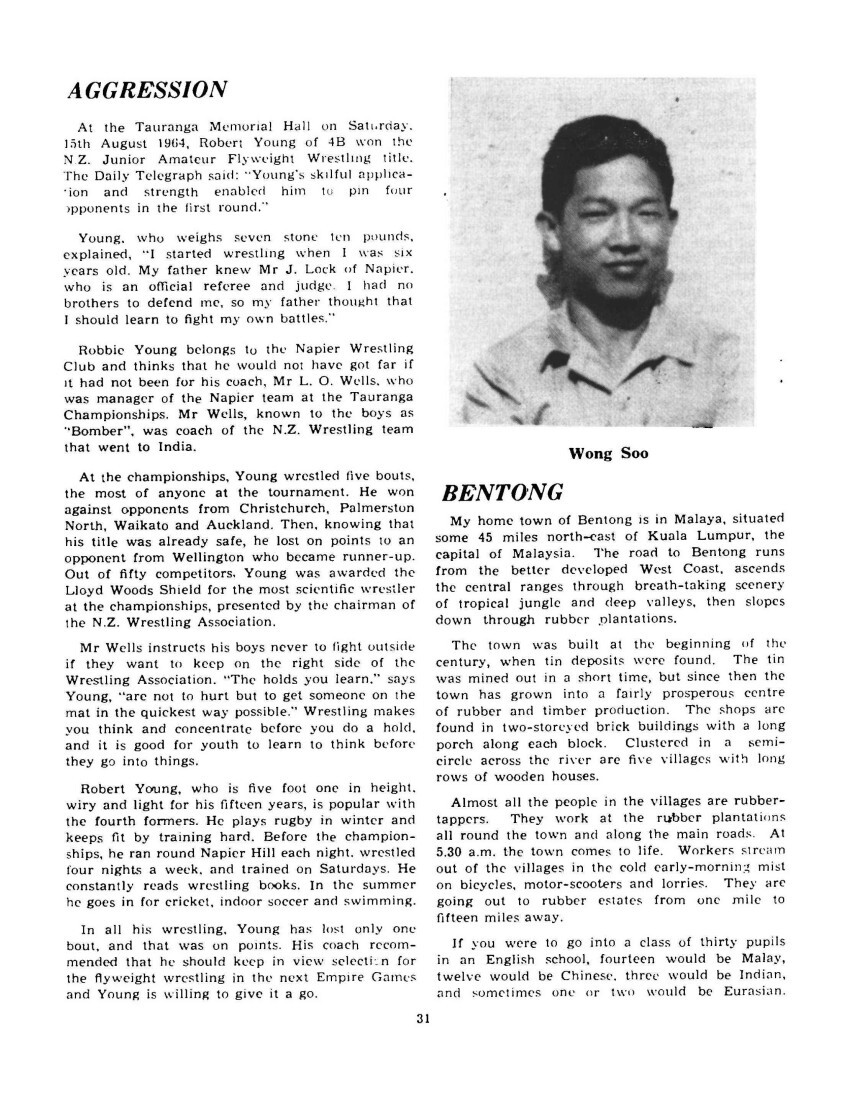
Page 32
At my English-speaking school, I formed friendships regardless of race. We share the great festivals of each race, when families keep open house for all their friends. For our big Chinese festival of the New Year, my Malay and Indian friends came into our home. On the table would be at least a dozen kinds of home-made cakes, sweets and candies. Everybody helped themselves. I would also go to share the Malay and Indian festivals, when Malay or Indian foods would be spread before us.
Malays, who are all Muslims, are forbidden to eat pork. But pork is the everyday meat of the Chinese. Hindus cannot take beef, which both Malay and Chinese will eat. Rice is the common food of all; what goes with the rice is each one’s own affair, be it curried beef, fried fish, or roasted pork.
There are three cinemas in Bentong, the Rex, Cathay and Lyceum, showing British, American, Malay and Indian films, also Chinese films from Hong Kong. The town is busiest at night. Three wide main streets make up the centre of the town, with a big market place at one end. This market is the busiest place in the town, supplying fresh fruit, vegetables, beef and pork. Within the market place are eating shops which cater for labourers, students and businessmen. Stalls offer a great variety of snacks: curried rice and chicken and chow. Coffee shops are the public meeting places of the townsfolk. Favourite pastimes of many during the evenings are snacks at the eating stalls or coffee shops, or strolling along the streets or in the parks (not often in couples, by the way) On the whole, there is racial harmony in Bentong for, of course, we are all Malaysians.
WONG SOO, 6B.
FARM NOTES
The school farm is 240 acres and of diversified nature. It is the laboratory and workshop of the Agriculture Course. But it has to be run as a commercial proposition so as to earn the respect of the boys and the farming community. New ventures are always being tried. Some items of interest that have happened during the year are mentioned below.
Since 1963 we have a barn-type piggery which can house eight sows. During the year the numbers have been round about thirty-three pigs. The emphasis is on porker production although one or two pigs have been taken through to the baconer stage. Already two or three litters of porkers have been sold. The pigs are fed entirely from homegrown crops and garbage from the hostel. The crops have been maize, fodder-beet and barley for barley-meal.
The dairy unit had fifty to sixty pedigree Friesian cows milking on town supply. There has been no change except for the construction of stock yards. These will help in the management of the dairy unit, and also the transportation of stock. These have a handy bobby calf pen.
New Stock Yard
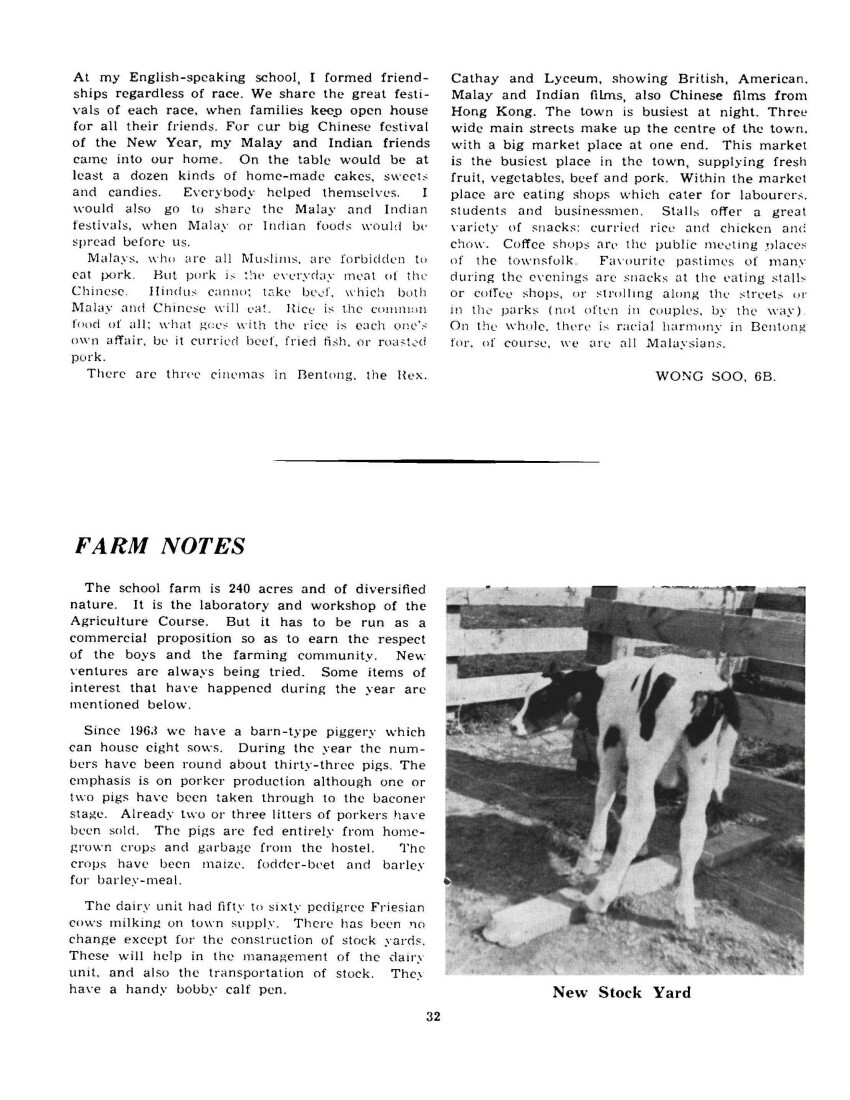
Page 33
On Thursday, the 23rd April, the Ag. Course had a display evening for parents. Visitors were shown around the woolshed, the dairy unit, the piggery, and the farm machinery. Talks were given by senior Ag. boys: G. Ebbett, H. Tennent, I. Beattie and D. Goulding. Mr McKenzie also showed film slides of the farm to the parents in the Assembly Hall.
Mr R. G. Montgomery, from the Agriculture Department, has made several visits during the year. He is using the woolshed for experiment in wool-shed design, and it has attracted considerable interest among senior boys. Mr Montgomery is designing lift-and-swing gates, draught-proof chutes and several types of gratings. Mr Montgomery is trying out shed lighting that will give an even, diffused light, not casting shadows likely to annoy the shearers.
One of the main features of the year, as far as practical work goes, has been the shearing week. This week was held at the end of October. Mr Montgomery, assisted by Mr Davies, a retired farmer, instructed in wool-handling, and wool-board techniques of throwing a fleece, skirting, sorting and pressing wool. Mr Sutton, a Wool Board shearing instructor, taught shearing, grinding of gear and machine safety. He instructed in the Bowen technique of shearing.
Mr McKenzie left at the end of the second term. He has done much for both the farm and Ag. course over the past twelve years. On behalf of those concerned with the Ag. course, I would like to wish him well in his new position as headmaster of the Marlborough Boys’ College.
Mr McKenzie’s leaving has meant a redistribution of responsibility for Mr Smart and Mr McGlashan: Mr Smart teaching in the classroom and Mr McGlashan demonstrating on the farm. Mr W. J. McGlashan, the newly appointed farm manager, has had a life-time experience in farming in Hawke’s Bay. He hopes to keep the farm running efficiently and economically so as to be a training institution for boys. He served right through to the finish of the war as an Armoured Corps instructor, and is used to handling groups for instructional purposes. Next year, Mr McGlashan will be residing in the farm manager’s house. He says: “I have found the farm well equipped with buildings and implements, and plan to make full use of it.”
The N.B.H.S. Ag. course and farm are more or less unique in New Zeaand [Zealand]. It is the only Ag. course having a large farm which is not subsidised by the Government. It is self-maintaining, and able to combine the theoretical side with much practical work such as supplementary and cash cropping, dairying, fat lamb flock, Southdown stud, and general maintenance.
The farm has many friends among the local farming community and farmers’ organisations. I wish to express our thanks to them all, especially to the Farm Advisory Committee.
R.H.S.
FARM CADET SCHEME
The Board of Governors has agreed to have in the future a scheme to train cadets in the skills of farming at N.B.H.S. The school farm is capable of giving cadets examples of a wide range of farming types and a basic background in general farming problems.
The course will be aimed at turning out farm workers, shepherds and future farm managers or farm owners. At first four cadets will be accepted. They will alternate about various units on the farm, each cadet spending a period on (a) the sheep unit, (b) the town supply dairy unit, (c) the pig unit, (d) the cropping unit and (e) the farm maintenance and engineering unit.
Cadets will be required to write farm diaries, reports on various activities, and do some theory work but their programme, which will be basically practical, will not be tied to that of the school.
G.W.E.
FARM INSTRUCTIONAL WORKSHOP
This large, varied and well equipped workshop is situated in the school farm area, which assists in creating a farm atmosphere. A unique feature is that all tools and equipment are in one shop. This enables it to be self-contained, and to occupy the Ag. boys in various types of practical work at the same time.
The aim of the course is to introduce and practise the use of tools needed for the various types of maintenance on a modern farm. Basic principles of the following subjects are covered: Woodwork, metalwork (hot and cold working), oxyacetylene and arc welding, leatherwork, pipework, concrete, drawing and sketching, motor vehicle and tractor maintenance.
This year much time has been spent in developing the workshop. All classes have made a contribution, often by volunteer groups out of normal school hours. The enthusiasm of those engaged has been pleasing and interesting to observe.
Senior students have carried out more advanced constructive work for the farm. This year a large concrete apron was laid at the shop entrance. Also a tray was constructed for the farm’s new Thames Trader chassis. Next year it is hoped to erect a classroom, a motor vehicle model room, and a sheep-cattle crate along with its hoist and tackle.
J.W.Y.
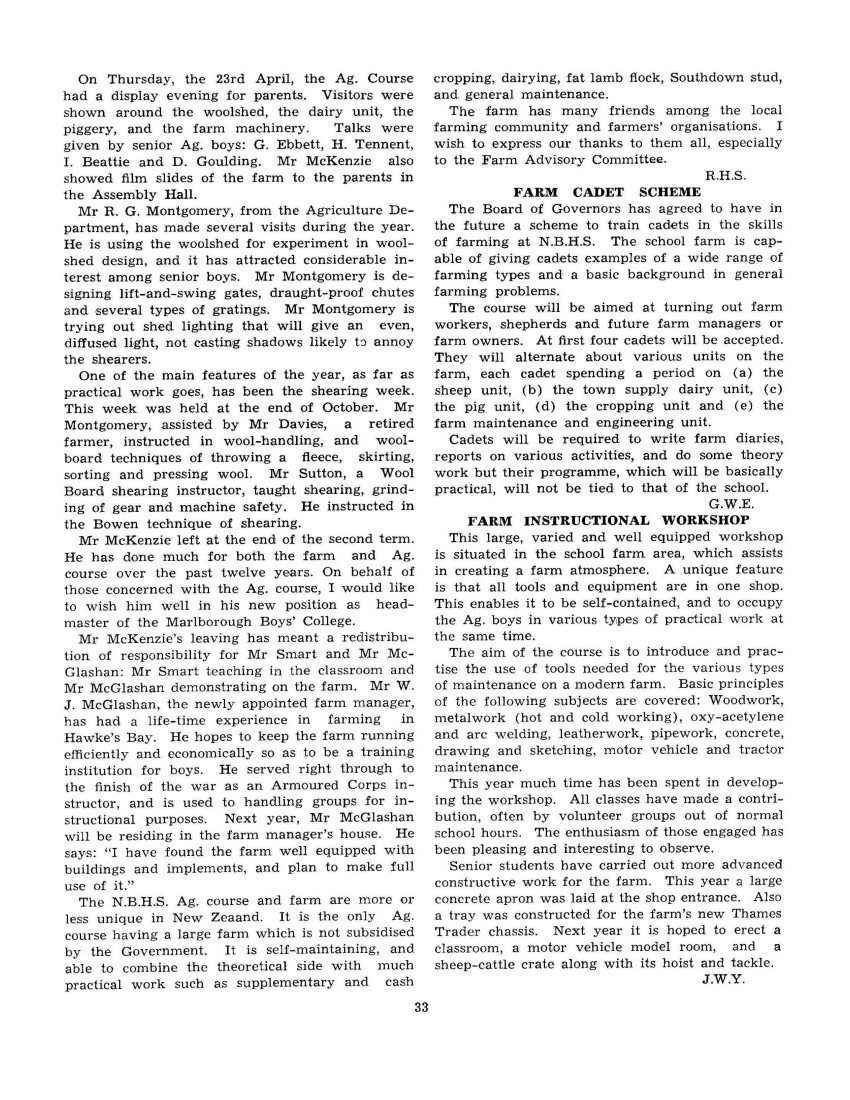
Page 34
HOUSE NOTES:
DAY BOYS’ HOUSE NOTES
There are two kinds of House achievements. The first is the relay type of event, which whips up tremendous immediate enthusiasm and depends upon the brilliant performance of the leading House members. This year Napier House has had most of its success in this kind of event. The second kind of achievement is where every member’s contribution adds up slowly to a grand House total. Colenso and Clyde Houses have had a particularly good year in this way. Hawke and Heretaunga have been noted for a balance between the brilliant individual performances and the good over-all contribution from every member of the House. Every day boys’ House congratulates Colenso House on its golden year, when it has nobly raised the standard against Scinde House on several occasions.
COLENSO HOUSE
Number: 103.
Leaders: Piper (captain), Vivieaere (vice-captain).
Master in Charge: Mr Webster.
Swimming: 2nd in house points. 1st in junior relay.
Steeplechase: 1st in intermediate points.
Tabloid Sports: 1st in both grades.
Athletics: 1st in Senior Relay.
Inter-house Shooting: 3rd.
CLYDE HOUSE
Number: 206.
Leaders: Karatau (captain), Dallas (vice-captain)
Master in Charge: Mr O’Connor.
Steeplechase: 3rd in all three grades for house points.
Tabloid Sports: 3rd in senior.
Athletics: 2nd in intermediate and senior relays.
HAWKE HOUSE
Number: 137.
Leaders: Mear (captain), Campbell (vice-captain).
Master in Charge: Mr Tuck.
Swimming: 3rd in Junior relay. 2nd in Senior relay.
Steeplechase: 2nd in Intermediate points.
Tabloid Sports: 3rd in Junior grade.
Athletics: 3rd in Junior relay.
HERETAUNGA HOUSE
Number: 97.
Leaders: Wilson (captain), Pishief (vice-captain).
Master in Charge: Mr Matthews.
Swimming: 1st in Intermediate relay. 2nd in Junior relay.
Steeplechase: 1st in Senior points.
Inter-house Shooting: 2nd.
NAPIER HOUSE
Number: 110.
Leaders: Hall (captain), MacLeod (vice-captain).
Master in Charge: Mr Carpenter.
Swimming: 3rd in House points. 3rd in Senior relay.
Athletics: 1st in Junior relay. 3rd in Senior and Intermediate relays.
SCINDE HOUSE NOTES
SCINDE HOUSE – FLOREAT SCINDIA
Hostel Director:
Mr D. P. CAIRD.
Matron:
Mrs J. M. HARVEY.
Sub-Matrons:
Mrs O. GURNEY, Mrs J. LUNDY, Miss J. WILSON.
Housemasters:
Mr A. T. HOWLETT, Mr K. C. FLOWERS. Mr G. BEER, Mr R. ANDERSON, Mr P. R. WARE.
Prefects: G. W. Robinson (Head), D. D. Kerr, R. H. Sherwood, G. W. Ebbett, P. R. Carney, B. Chrystal.
Retirement: Miss G. Butcher, a very devoted sub-matron since 1959, has retired to live with friends in Napier.
1964 has been a year of changes for Scinde House, but nevertheless it has been a year of outstanding achievements.
The greatest number of changes took place on the hostel’s administrative staff. Mr Caird, our new headmaster, took over the role of hostel supervisor and Messrs Ware and Anderson joined us as resident housemasters. Mr Howlett re-joined us after a year’s respite, and Mr Flowers, after a pleasant interlude, also returned to Scinde House when Mr Brown moved up on to the Hill to a plot of his own. Add to these Mr Beer and you have an efficient group of men who have controlled the running of the hostel this year.
Assisting in the control were six prefects – G. Robinson, D. Kerr, R. Sherwood, G. Ebbett, P. Carney and B. Chrystal – the first five of these, and G. Dick, had the distinction of being school prefects, also.
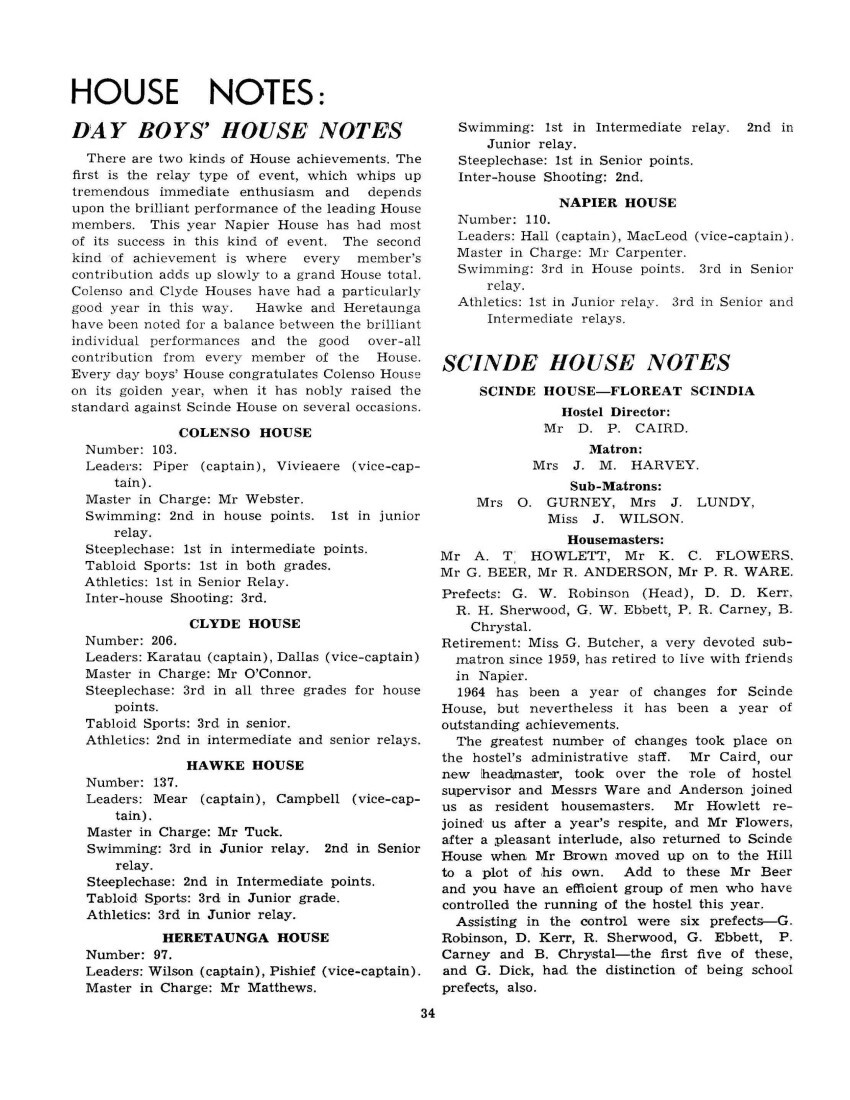
Page 35
The health of the boys in the hostel was cabably [capably] cared for by Mrs Harvey and her team of sub-matrons. Mrs Kinniburgh became acting matron when Mrs Harvey was on holiday in Scotland and to these two women and the rest of the domestic staff go our thanks for the way in which they have carried out their many duties.
In the many inter-house competitions held during the year, Scinde House showed the day school that it was an even better team than ever this year. The swimming sports were won by the boarders for the first time in four years and the spirit of the boys entering was to be commended. P. Robinson scored an individual success when he came runner-up to the intermediate champion.
Once again the boys in the shorts with the royal blue stripe were well to the fore in the athletic sports and the high standard of running and throwing attained by the boarders after hours of practice proved to be too good for the other five houses.
The steeplechase too resulted in a victory for the fitter Scinde House boys. G. Robinson and R. Nant filled the first two places in the senior race, this giving Nant the senior athletic championship with Robinson runner-up. B. Mackintosh was second in the intermediate steeplechase and the juniors’ race went to R. Neill with K. Farquharson second. It is interesting to note that five of the first nine runners home in the junior steeplechase were boarders. The inter-secondary school athletic team contained eleven boarders.
With D. Little (106) and D. Kerr (105) playing major roles, Scinde House managed to clinch the inter-house shooting cup by a margin of thirty-six points, although no boarders were included in the school shooting team. The other members of our team were P. Carney, R. Sherwood, R. Kells and B. Taaffe.
The tabloid sports did not go entirely our way this year and we managed second place only in each of the senior and junior grades. It must be noted however that our conduct and marching were judged superior to those of the other houses.
The most glorious day of the year was without doubt the 20th August, the day that the boarders defeated the dayboys in the annual Rugby clash by one of the largest margins on record. The keenness of the team members and the ardour of the supporters, among which number there were many old boys, were richly rewarded. Eight of the team, P. Carney, J. de Denne, J. Andrews, B. Chrystal, D. Kerr, G. Robinson, R. Sherwood and B. Harvey had gained their Rugby caps for being in the school first XV; R. Nant, G. Field, R. Forrest, B. Tucker and D. Goulding were second XV players; R. Treseder played for the third XV and M. Simpson was a fourth grader.
Scinde House boys were to be seen playing in every school Rugby team each Saturday in the winter term and more than a third of the boys playing for the school were boarders.
Three boys, G. Dick, G. Ebbett and B. Snee earned their hockey colours this year and a large number of boys played for other teams in this sport. We also had several indoor basketball players this winter including B. Marshall, who was in the School A team.
The first cricket XI numbers four boarders among its members: B. Chrystal, E. Castles, J. de Denne and B. Snee. Chrystal’s long hours of practice were rewarded when he was included in the Hawke’s Bay Colts’ team for its match against Manawatu Colts. Snee, who has earned two sets of colours in his third form, has the makings of an exceptional sportsman and he will doubtless be an asset to the hostel in years to come.
Once again a softball team comprised of boarders is having an enjoyable year playing in the Senior B competition at Hastings.
During the summer months quite a few boys are travelling large distances each week for rowing training. To R. Sherwood, A. Sherwood, D. Munro, H. Trafford, D. Oliver and S. Alder these long hours of training have brought the honour of being in the school rowing eight.
D. Kerr and P. Carney are members of the school tennis team and Kerr is also in the Hawke’s Bay tennis team.
Much credit for the interest of the juniors in Rugby and cricket must go to Mr Beer who has put a great deal of time into passing on to these boys his wide knowledge of the ball games. With keenness such as he has aroused in the boys he has coached we can rest assured that Scinde House boys will do well in school sporting activities in the future.
Regular Y.F.C. meetings have been held in the lounge during the year, and with a membership of over 100 boys it is the biggest club on the East Coast.
Film evenings were held in the assembly hall every Saturday and these were supplemented by visits to theatres in the city for such entertainments as “Lawrence of Arabia” and “Bombers B-57” and the musicals “Belle of New York” and “Maid of the Mountains.”
Mrs Hogge and Mr Coady conducted dancing classes in the winter term and the boys’ new-found skills were severely tested at a successful Boarders’ Social which was held at the end of the term. Because of the lack of a convenient date no Scinde House Athletic Sports were held this year.
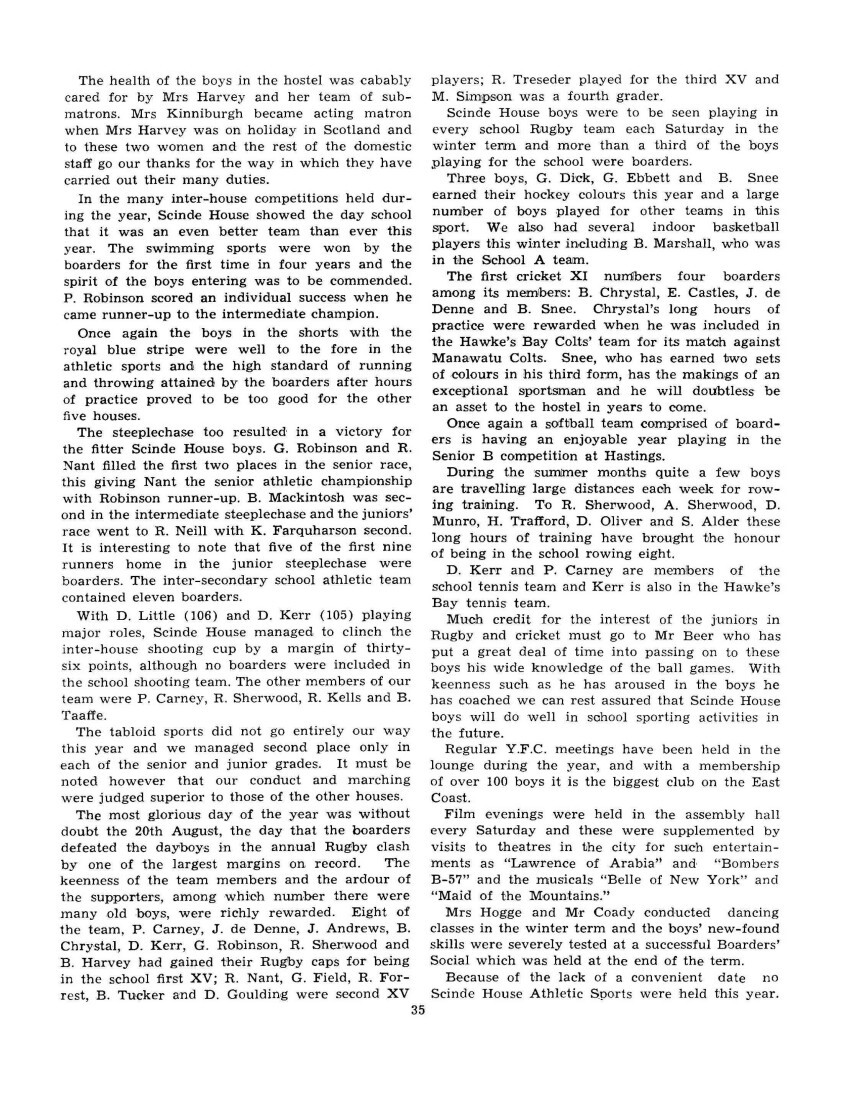
Page 36
However, the parents did not miss out completely on their annual get together for a highly successful Parents’ Ball was held in the Majestic Ballroom last term. This was on Friday, 31st July and was organised by Mr A. T. Howlett.
The Rev. G. V. Hill and Capt. P. Coughlan conducted Anglican Bible Classes during the second term while the Rev. W. R. Hay held classes for the Presbyterians.
Boarders have done well with their school work as is indicated by the fact that 70% of the boys attempting University Entrance were accredited this year. Judging by the large amount of swot which has been done in recent weeks a good fraction of those boys who sat the School Certificate examination can await the publishing of the results with confidence.
We have had our share of success in many fields this year. With the keen competitive spirit and determination to win which is one of Scinde’s proudest traditions, we can expect even greater things of the boarders in the future.
G.W.R.
Is the Hostel on the level?
Sgt. R. Malcolm and J. McMillan
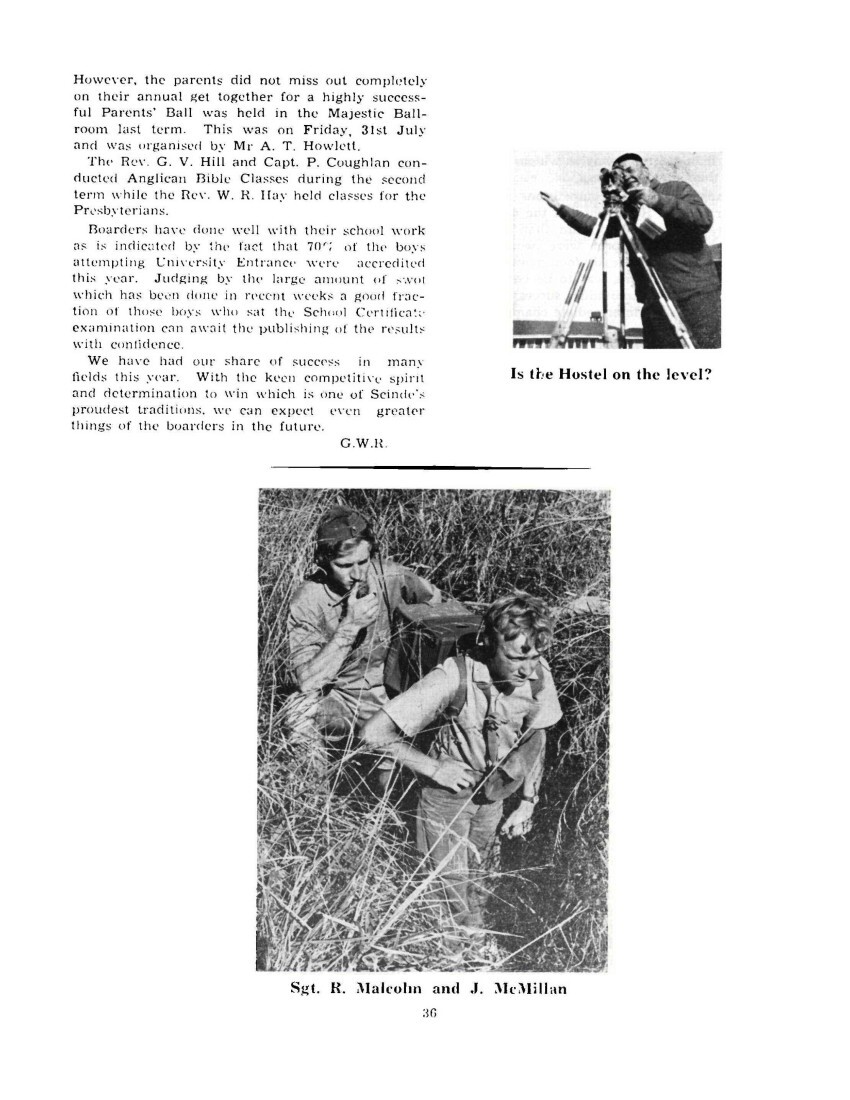
Page 47
MILITARY CADETS
A particular effort has been made this year to develop and continue a programme of diversified and liberal training. Training circuits have provided a great variety of activities in addition to the standard cadet syllabus. Mr Young has lectured to groups on engines; Mr Simpson has given courses on resuscitation; Mr Webster has prepared special assignments on local map-reading; Mr Knight has given talks on ‘Survival in the Mountains’; Mr Shorter has made sure that every boy has had a generous programme of films. For one of the training days, Mr Drinkrow, of the Ministry of Works, erected a model Bailey Bridge.
In addition, every third and fourth form boy has had at least two shoots at the .22 range on the beach, where Major Tuck has carried through a thorough and extensive programme of training. Every senior boy has had an opportunity of .303 shooting at Roys Hill. Capt. Carpenter, Lt. Nicol, and 2/Lt. Lloyd have given a great deal of time to the range shooting practices.
The training days have been 25 Feb., 25 Mar., 27 Apr., 7 May, 16 July, and 14 Aug. There are plans for two cadet days at the end of the year, on the 7th and 8th December. Senior boys are looking forward to “Exercise Overnite’” which will take place on Mr D. McKay’s property at Tangoio.
The strength of the cadet unit has been about 840 this year.
The high point of cadet training for the year was Barracks Week, 8-15 April. This again featured the diversified training that it was Major Tuck’s care to foster, and which Squadron Leader Revell has further developed. Mr Simpson’s assault course was very popular and challenging for all cadets. There were walls to scale, nets to crawl under, ropes to climb, and a flying fox to travel across.
The “A” Company field exercises drew wide-spread attention. Senior boys dressed up in old clothes and camouflage. They crawled through various types of cover on the school farm, putting into practice their knowledge of field craft and battle tactics. Various ancillary units were also involved in the operations, such as Signals and Intelligence.
On the final afternoon came the unit parade and march past, with the Pipe Band in attendance. The headmaster, Mr D. P. Caird, reviewed the parade, and spoke warm words of praise on the impressive success of the Barracks Week.
Lieutenant Monrad’s N.C.O. Training Unit has worked steadily through the year in acquiring the principles of instruction so as to take their part later in the cadet training programme. Their up-right bearing and efficient drill have impressed the spectators on all public occasions. Area Major Kearney, during his visits to the school, showed the greatest interest in their work.
The medical unit has been very generouly [genourously] supplied with a great variety of army medical equipment from the Trentham Depot this year. Twenty-six boys took the N.Z.R.A.M.C. first aid examination and obtained Army first aid certificates. The junior boys spent a profitable afternoon at Napier Public Hospital, thanks to tutor sister Currie, who organized an interesting training programme. Special compliments are due to Cpl Vivieaere who was called upon to give lectures to other platoons frequently, and showed talent with his illustrated talks.
A number of cadets have again profited from training courses at Linton Military Camp. After attending officer’s courses, 2/Lts. Lloyd, Anderson and Ware are now Officially commissioned. Certain changes have taken place in the officer staff with the departure of Sub. Lt. D. S. McKenzie, whose generous help on the rifle range receives fitting mention elsewhere in this Scindian. We print the officer strength as in force for the Barracks Week in April.
We thank Warrant Officer Hartley and his staff of R.F. instructors for their very active interest in all our work, especially for the beneficial attention they have given to parade ground drill. Staff Sergeant Hood has been extremely co-operative in obtaining films for us, often at short notice. We thank Sergeant Major Gleeson for assistance with Q stores at area headquarters, and regret that his coming retirement will bring to an end years of cheerful help that he has given to our cadet unit. The Commanding Officer, Squadron Leader D. G. Revell, has ensured that everyone had his proper place in an efficient syllabus of training. In the high standards he has set for military cadets, he has been worthily seconded by R.S.M. Karatau.
ORGANISATION
C.O.: Squadron Leader D. G. Revell.
2 I.C.: Capt. J. W. Bygate (Armoury).
Adjutant: Lt. R. Gourley.
R.S.M.: W.O.I. L. H. Karatau.
Records: Sgt. K. Weston.
Shooting: Capt. W. T. Carpenter, Sub. Lt. D. 5. McKenzie, Major R. C. Tuck.
Armoury: Sgt. J. M. C. Piper.
Pipe Band: Mr K. C. Flowers.
H.Q. Company
O.: Lt. C. Smith.
C.S.M.: W.O.II C. Lum.
Medical: Lt. R. Mundy, Sgts. B. R. Baudinet, A. J. Parker.
Signals: Lt. R. Gourley, Sgt. R. K. Malcolm.
N.C.O.T.U.: Lt. D. Monrad, Sgt. R. I. Cross.
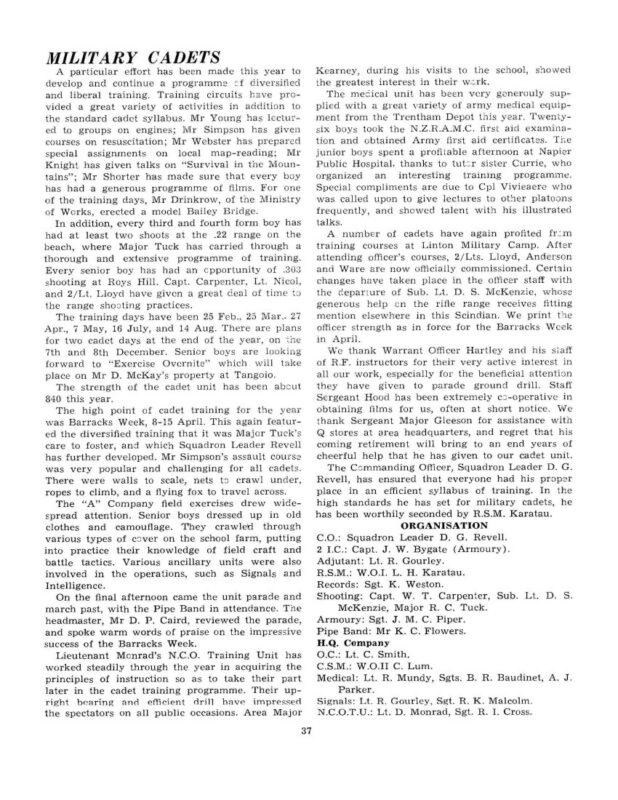
Page 38
RUGBY FOOTBALL
A Rugby season is often judged in terms of the success of the representative team, of the senior club side, or, in the case of schools, of the First Fifteen. Yet in spite of a complete “shut out” in inter-school First Fifteen matches, this has been voted one of our best seasons for a long time. The Second and Third Fifteens were not far behind the First Fifteen in ability, and their results are quite impressive. Some members of these teams can be considered unfortunate not to win their caps. Teams were well up in all grades, and two of the junior teams were at the top of their grades. This promises well for future senior teams.
Our attempts to cater for non-Saturday players continue to be met by frustration and a lack of appreciation. It seems a little unfair to deny the keenest boys the use of our own grounds and send them to outlying fields in favour of an unappreciative minority. The best we can say is that we kept these people active for the duration of the weekly sports period.
R.C.T.
FIRST RUGBY TEAM
Back Row: I. Ware, C. Brunton, D. Kerr, G. Exeter, A. Ware, J. Andrew.
Middle Row: B. Chrystal, R. Sherwood, J. Exeter, L. Campbell, J. M. Piper, G. Robinson, M. Mear. Front Row: J. de Denne, P. Tuck, L. Karatau (Captain), Mr J. D. Briasco (Coach), P. Carney, G. Kohlis.
In Front: D. McBeath, B. Harvey.
This year has been statistically unsuccessful for the First Fifteen, but the boys have still had the satisfaction of representing the high school at Rugby. The team was potentially a good one, but was slow to develop a firm unity and mutual understanding.
N.B.H.S. 1st XV competed with eight other teams in the Junior Saturday Competition. Our team won eight games and lost twelve. There were 255 points scored for the team and 213 points scored against it.
Special mention must be made of P. R. Carney, who had a very successful season in all aspects of his full-back play and scored over half the team’s total points. Carney, who has gained great confidence in his boot through hours of practice, is an up-and-coming player who should go a long way in further years of Rugby.
J. Andrews deserves special mention for his three-quarter play and has become the most improved player in the team this year. In the five-eighths, J. P. de Denne excelled for his backing
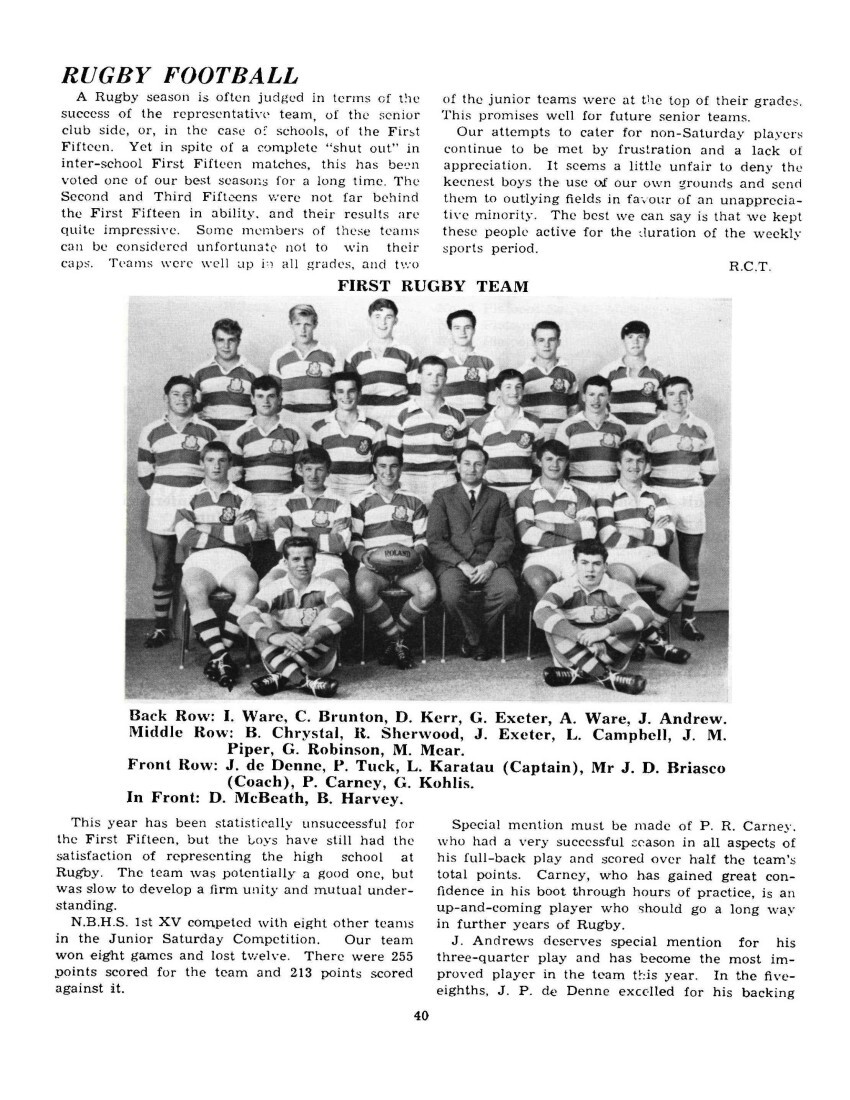
Page 41
up, and always played a sound game. Although B. Harvey and D. McBeath lacked experience in their half-back play at the start of the season, they gained some valuable experience from playing in the junior competition. Next year should prove the worth of this experience.
Our loose forwards showed great speed to the ball, particularly G. Robinson, G. Exeter and J. Exeter. They displayed their knowledge of what to do with the ball, as can be shown by the points record.
L. Campbell and D. Kerr teamed up extremely well as the big men of both the scrums and line-outs. This pair gained valuable possession in the line-outs because of their tactics and determination.
P. Tuck, who led the forward play and captained the team for two school matches, proved himself valuable for his hooking and tight play. He was helped considerably by the three experienced props, B. Chrystal, G. Kohlis and R. Sherwood, who not only displayed their versatility in the scrums but showed great speed to the ball at all times and were prominent in the tight. Chrystal and Sherwood were also noted for their low and sure tackling of a man.
Above all, the team lacked expericnesd [experience] in fundamentals and in knowledge of what to do with the ball once it was obtained.
Once again we would like to express our thanks to Mr J. D. Briasco for coaching the team this season. It is also fitting to acknowledge here some helpful advice given by Messrs Doug Dalton, K. Tremain and Don Clarke.
Individual record:
Games Tries Cons. P.G. F.G. Ttl.
Carney 20 1 23 31 3 151
de Denne 20 7 – – – 21
Andrews 15 5 – – – 15
Robinson 13 5 – – – 15
J. M. Piper 11 3 – – – 9
Chrystal 18 1 2 – – 7
Kerr 18 2 – – – 6
G. Exeter 19 2 – – – 6
Mear 10 2 – – – 6
I. Ware 11 1 – – – 3
A. Ware 12 1 – – – 3
Harvey 14 1 – – – 3
Karatau 17 1 – – – 3
J. Exeter 15 1 – – – 3
Brunton 12 1 – – – 3
Sherwood 14 1 – – – 3
McBeath 4 – – – – –
Campbell 18 – – – – –
Tuck 20 – – – – –
Kohlis 10 – – – – –
L.H.K.
v. Shirley Boys’ High School
8th June. Lost 8-6
In this first annual fixture between the two schools, Shirley brought up a strong team. Their attack was hard and fast. After eight minutes, the southerners secured a try between the posts, which was converted. Napier hit back hard but could not penetrate the defence of the other side. Our backs threw away many chances by bad passing and handling. Just on half time, Robinson kicked the ball through and Sherwood followed it up to score a try, but Carney missed the goal. Half-time score was therefore 5-3 in favour of the Christchurch team.
Our forwards fought back tremendously in the second half, and got as much possession of the ball as could be desired but the back line kept losing it by poor handling. After ten minutes, Napier made an unfortunate off-side infringement right in front of our posts, which gave an easy penalty kick to Shirley. The score was thus brought to 8-3.
The play was now almost entirely in Shirley territory, but their defence was strong and able to hold off the Napier attack. Our side made repeated attempts to score and were within an ace of two almost certain opportunities. Finally Karatau foiled a Shirley raid and sent the ball back to Piper, who enabled I. Ware to score a try. Carney
P. R. Carney
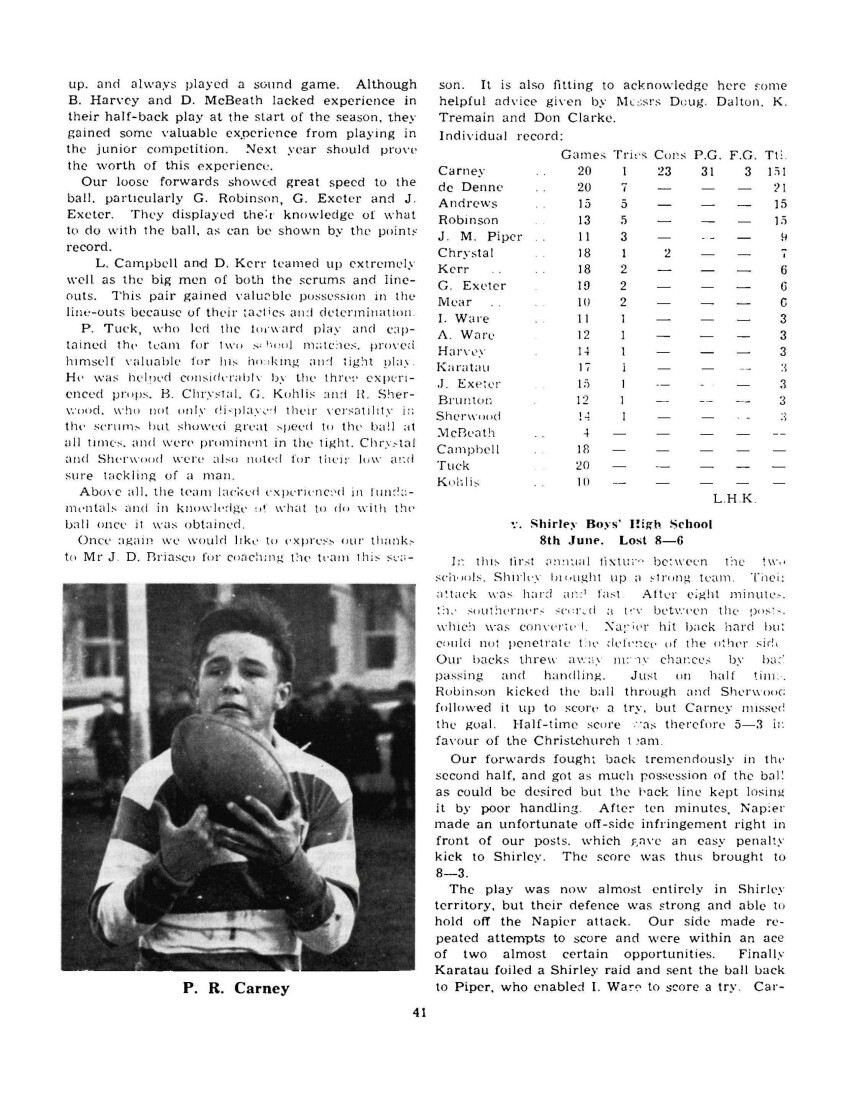
Page 42
narrowly missed converting it. With the score at 8-6, for the remaining seven minutes of ragged play Shirley held up their defence and thus retained the victory.
The team: Sherwood, Tuck, Chrystal, G. Exeter, J. Exeter, Robinson, Brunton, Campbell, Kerr, Harvey, Karatau, de Denne, J. M. Piper, Mear, I. Ware, A. Ware and Carney.
Robinson and Mear had to go off injured in the early stages of the game.
v. Hastings Boys’ High School
30th June. Lost 19-12
In this game the victory fell to Hastings for the first time since 1960. Hastings scored 2 tries, 2 goals and 1 penalty. All Napier’s points came from penalties kicked by Carney.
Play began with Napier holding their own for a lengthy period. Campbell, reaching high in the line-outs, was winning plenty of the ball for Napier. After ten minutes of play Hastings wing Torwick went over to score a try near the side-line. The conversion was missed. After fifteen minutes Carney kicked a penalty goal, bringing the score to 3-3. Our big disappointment then happened when Napier failed to find touch and Warrington went over for a try to Hastings, which Tonkin converted, bringing the score to 8-3. In the rest of the first spell, Carney kicked two penalty goals, bringing the score to 9-8.
During the second half, the Hastings forwards were galvanised into a bid for victory, and our team was on the defensive. The Hastings backs kept breaking through. Torwick eventually eluded Napier tacklers and scored in the corner. The goal kick was unsuccessful. Keeping up a furious pressure, Hastings got a clear run ten minutes before the close of play and scored a try right under the goal. Tonkin had no trouble in adding the extra two points. One minute later, Carney scored three points from a penalty goal, which brought the score to 16-12. However, right on time, a penalty kick was awarded to Hastings, and Tonkin scored from about 30 yards out, leaving the final score at 19-12. The team: Sherwood, Tuck, Kohlis, G. Exeter, J. Exeter, Robinson, Campbell, Kerr, Harvey, Karatau, de Denne, Mear, Andrews, A. Ware, Carney. The referee was Mr K. Hartley.
v. Gisborne Boys’ High School
27th July. Lost 9-6
Gisborne had a brilliant back line. They did not have it all their own way, however, because they missed three near tries by poor handling in the first half. L. Campbell was winning Napier most of the ball in the line-outs. The game had been going nine minutes on the main football field in front of our school, when Gisborne kicked a penalty goal. Carney then scored a good penalty goal to bring the score to 23. Following that, the Gisborne backs got a loose ball, and after a good manoeuvre by both forwards and backs, they scored a try in the corner but the conversion was missed. Half-time came with the score 6-3 in favour of the Gisborne visitors.
In the second spell, after thirty minutes of slogging defensive play by Napier, Carney got a penalty goal after a crooked throw-in. This brought the score to 6-6. Our men were determined to keep the score at that, and both teams were trying every trick they knew. A try to Gisborne almost on full time was the deciding feature of the game. Torrie toed a loose ball after some fumbling play, and chased the ball over the line to score by himself. No goal resulted and the final score was 9-6. A very crestfallen home team had to admit that the game was won by good following up right until the last.
The team: Sherwood, Tuck, Chrystal, G. Exeter, J. Exeter, McBeath, Brunton, Campbell, Kerr, de Denne, Karatau, Piper, Andrews, Carney, A. Ware (injured and replaced by I. Ware). The referee was Mr R. Boston.
v. Palmerston North Boys’ High School
6th August. Lost 23-5
Two days before the match our team suffered the loss of L. Karatau, the captain, who was hospitalised. In Palmerston North the team found wet weather and a muddy ground. With usual P.N.B.H.S. style, there were a fierce few minutes of opening play, but our team was keyed up to match them at all points. However, in the lull after this opening, Napier was thrown on to the defensive. All in one bruising quarter of an hour, Palmerston North scored two quick tries under the posts which were converted. While the Napier XV was fighting hard to avoid being overwhelmed the opposition followed up with two more tries. Again this year a feature of their play was their speedy wrestling of the ball into a dangerous position. Just before half-time, Kerr scored a venturous try for Napier and Carney goaled it.
The second half saw a hard, slogging match develop. The resolute and hard-working Napier forwards were possibly superior during this half. Palmerston North scored another try when the tired N.B.H.S. defence was caught on the wrong foot by Palmerston’s speedy wing. This try was converted to make the final score 23-5, with our team still fighting hard until the final whistle swung low under the showers over the boggy ground.
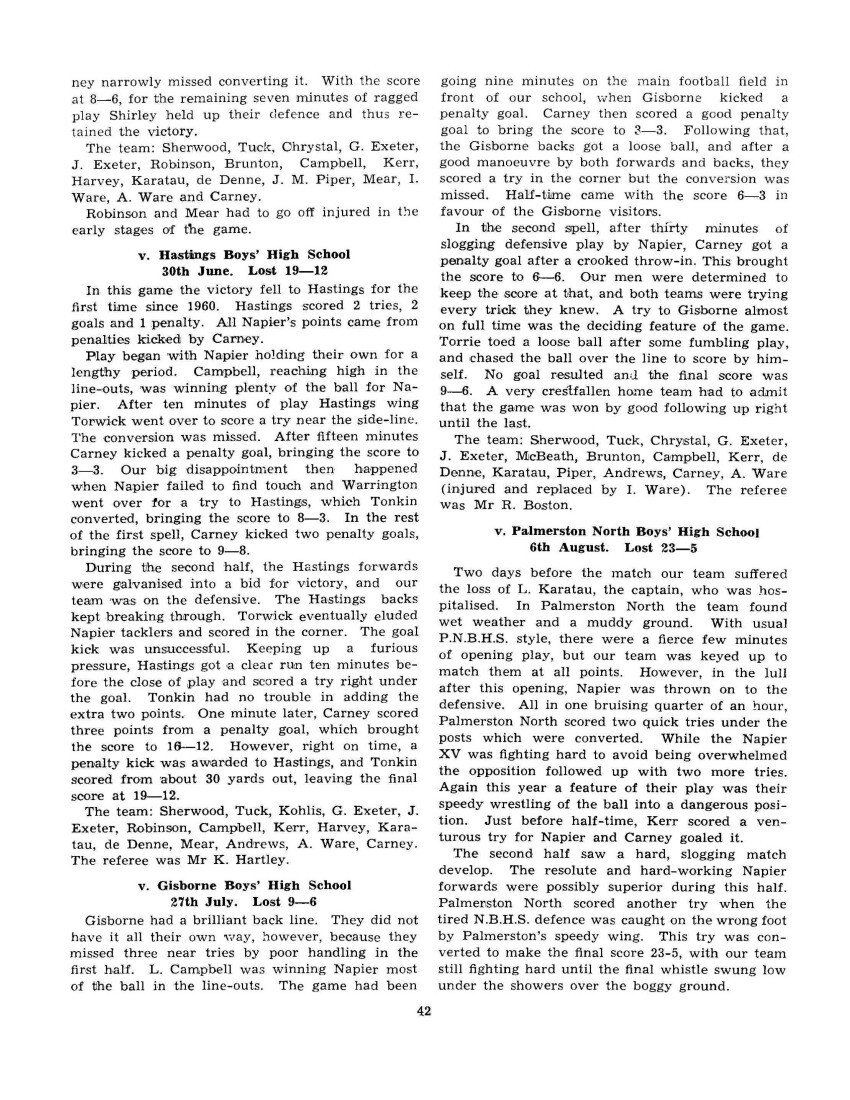
Page 43
The team: Tuck (captain), Chrystal, Kohlis, G. Exeter, J. Exeter, Robinson, Campbell, Kerr, Harvey, Bishop, de Denne, Andrews, Mear, A. Ware, Carney. Chrystal was replaced by Sherwood late in the first half.
P.C., P.T.
V. Wairarapa College
11th August. Lost 17-3.
This was Wairarapa’s first win since 1942. It was well deserved, because in the second spell Wairarapa played very well as a team. The game started sluggishly, with Napier on the defensive. The ground at Masterton was fairly heavy. A strong wind was blowing down the field, and a couple of shots which Carney had at goal in the first half were blown back out of the goalmouth by the wind.
Before long, Wairarapa scored a try after crashing through our defence. The score had reach [reached] 9-0 at half-time, from the addition of two penalty goals for Wairarapa.
After play began in the second spell a very easy try was presented to Wairarapa from a kick-back over our own line, which the opposition followed up and forced. This was converted. Next, Carney kicked a penalty goal from a handy position straight in front of their goal. Very close to the end, another try was let through by our side right out at the corner.
In general, this game was marred by poor tackling and lack of cohesion among our inside backs.
The team: Tuck (captain), Chrystal, Kohlis, G. Exeter, J. Exeter, Robinson, Campbell, Kerr, Harvey, Forrest, de Denne, Andrews, Mear, Piper and Carney. Sherwood replaced Kohlis at half-time and A. Ware replaced Mear, who was injured.
G.W.R.
DAY BOYS – BOARDERS MATCH
The Scinde House Rugby XV played the Day Boys on the afternoon of Thursday, 20th August. The two teams had about even numbers of members from the school first fifteen, but Scinde had good prospects in P. Carney, whose goal kicking has been outstanding this winter. Many Old Boys were present on the sideline and the barracking was exceptionally ardent.
The teams were: –
Boarders: P. Carney, R. Nant, G. Field, J. Andrews, J. de Denne, R. Forrest, B. Harvey, M. Simpson, D. Goulding, G. Robinson, R. Treseder, D. Kerr, B. Chrystal, B. Tucker, R. Sherwood.
Day Boys: A. Ware, I. Ware, D. Stevenson, R. Cottrell, N. Bishop, W. Eddy, J. Exeter, G. Exeter, C. Brunton, L. Campbell, M. Gudgeon, G. Kohlis, P. Tuck, M. Martin.
The game was fiercely contested from the kick-off. Scoring moves by both sides were bundled over the sideline by the opposition. The Scinde backs took a pounding, and the referee’s whistle intervened in some hot play close to the touch-line. On the whole the white team (Scinde) lasted the time better under these conditions.
From the start L. Campbell (Blue) was a marked man in the lineouts, and the ball was kept away from him. The first score went to the Day Boys with a penalty kick by R. Cottrell. After Carney had missed two penalties, de Denne, Carney and Robinson (Scinde) got away from their relentless opponents and scored a try which Carney converted. Half-time came with the score 5-3 in favour of the Boarders.
In the second half Scinde were constantly pushing into the enemy ground. De Denne finally got through a gap by himself and scored a try which was converted by Carney Ten minutes later a penalty kick was awarded to the Day Boys because of Harvey’s over-tenacious hanging-on and Cottrell scored for his side. The game, which was becoming something of a contest in long kicking by the opposite full-backs, was much influenced by the strong south-west wind, which now caused Carney to miss two penalty kicks.
Suddenly, 10 minutes before the close of play, Simpson got a pass to Robinson, who scored a try with ease, and Carney converted it with a mighty kick.
After the wind had defeated penalty kicks by both sides, the Blue team got into trouble in their own corner and G. Field emerged to score a try for Scinde. Carney kicked a fancy long conversion from the side just on full time, leaving the score Scinde 20, Day Boys 6.
SECOND FIFTEEN
Our inter-school games this year gave the best results for some three years. We lost only to Palmerston North Boys’ High School Second XV. This game was played at Palmerston North under very wet conditions to which the team was not accustomed. We were very disappointed that the game did not result in a draw.
The results of the school games were: –
v. Wairoa 1st XV; won 9-8.
v. Gisborne 2nd XV, won 13—0.
v. Palmerston North 2nd XV, lost 0-3.
v. Hastings 2nd XV, won 25-0.
The Second XV this year consisted of: A. Godwin (captain), W. Eddy (vice-captain), B. Tucker, M. Martin, J. Macleod, A. R. Lee, M. Gudgeon, D. Goulding, D. Hills, G. Wiig, G. Fuller, G. Mackay, N. Bishop, J. Hanlen R. Forrest, D. Stevenson, R. Nant, R. Cottrell, G. Field.
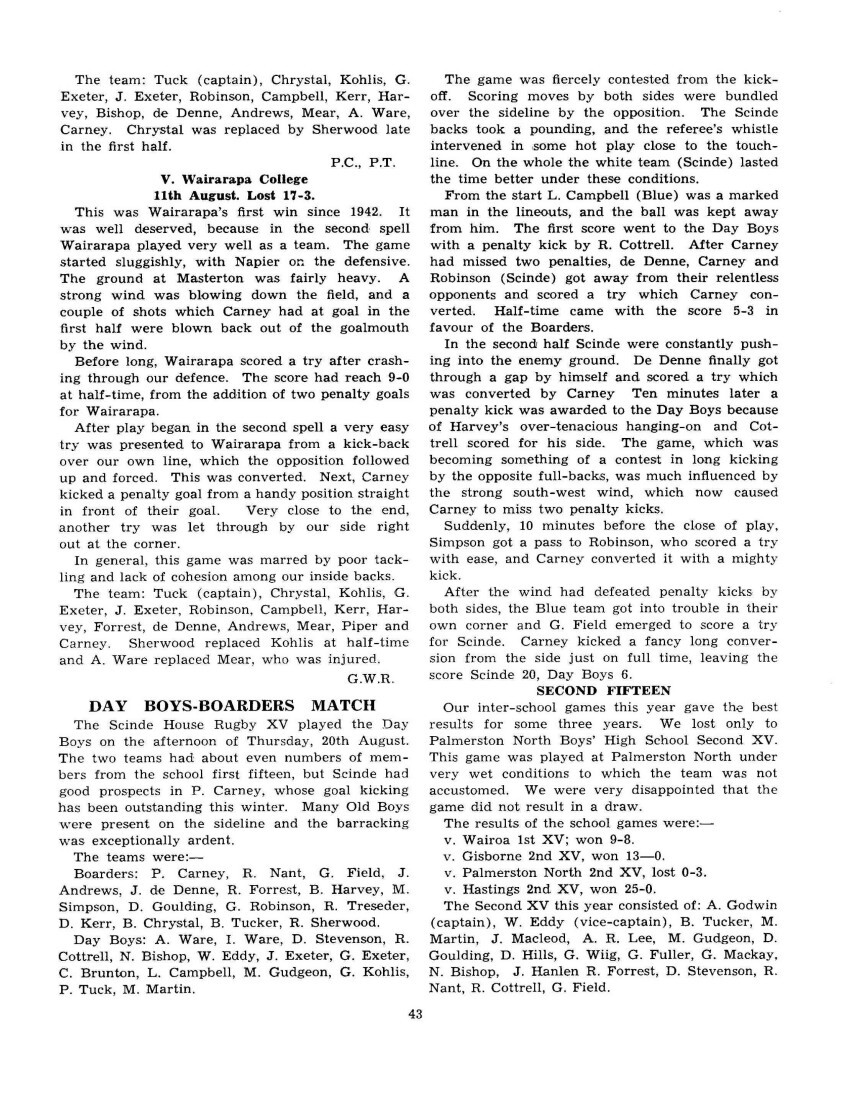
Page 44
SECOND RUGBY FIFTEEN
Back Row: J. Hanlen. B. Tucker, R. Forrest, R. Cottrell, G. Mackay. A. R. Lee.
Middle Row: M. Martin, D. Stevenson, D. Hills, G. Wiig, M. Gudgeon, G. Field, J. MacLeod.
Front Row: N. Bishop, Mr D. Brebner (Coach), A. Godwin (Captain). W. Eddy, R. Nant, G. Fuller.
We again took part in the Napier third grade competition. With several forwards over six feet tall and average weight of 12 stone, we were able to give our opponents very hard but clean-fought games. We were placed fourth in the competition, having played 23 games, won 12, lost 8, and drawn 3 (points for, 218; points against. 144).
In conclusion, I would like to thank Mr Brebner. We all valued the time he spent training the team this year.
AG.
THIRD FIFTEEN
In the Napier competition we made ten points, having won four matches, drawn two and lost 13. We played very well in our inter-school matches, managing to win three out of the four games.
v. Wairoa 2nd XV (away). won 54-3.
v. Central H.B. 1st XV (home), won 6-3.
v. Dannevirke 3rd XV (away). won 14-5.
v. Hastings 3rd XV (home), lost 9-10.
The team was: K. Cameron (captain), P. Atkin, D. Caird, F. Cameron, E. Castles. B. Davidson, J. Delugar, J. Hawkins, M. Kenah, J. Lavery, R. Le Quesne, S. Little, C. Love, B. Mackintosh, R. Meaclem, D. Munro, R. Scott, A. Sherwood, H. Tennent, H. Trafford, R. Treseder, Wilson.
We would like to express our thanks to Mr McKenzie for giving up his time and for the valu-coaching he gave to the team.
K.J.C.
FOURTH GRADE
Although four teams started out, only three teams went through the full season. The “A” team was chosen to be the best team the school could produce, and this team had seven wins in the club competition. All teams improved greatly in the course of the season, especially the Scinde team, which ended up by beating the “B” team and the Hastings team right at the end of the season. For this Scinde team. A. Pohio kicked 80 per cent of the points and M. Simpson was chosen for the Boarders-Day Boys match.
From the entire fourth grade a Fourth XV was selected to play two inter-school games. Its results were: –
v. Dannevirke, won 22-6.
v. Central H.B., won 16-9.
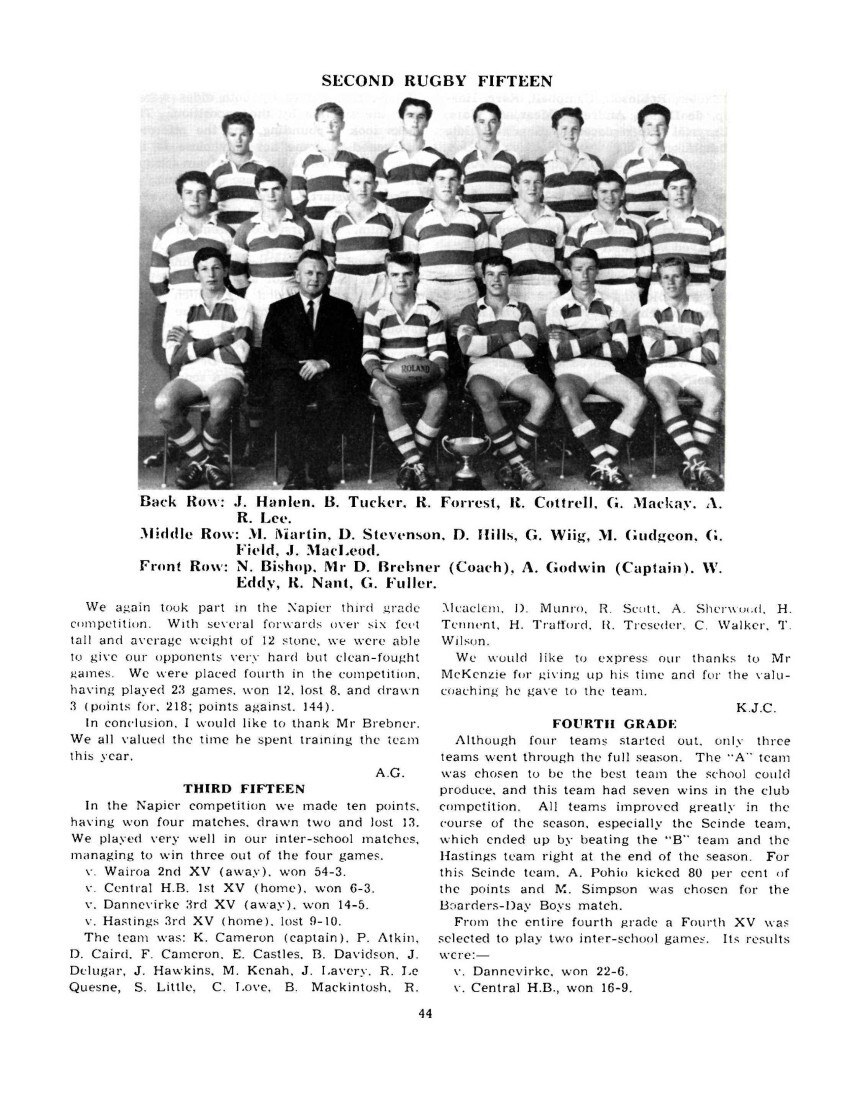
Page 45
All teams would like to thank their coaches, who devoted much time to the practices and much enthusiasm to the games.
“A” team (coach, Mr J. Lloyd): S. Alder (captain), W. Avenell, C. Clark, F. Craig, M. Dallimore, R. Farmer, B. Gardner, I. Gilray, G. Martin, P. Morrin, D. Oliver, M. Pearse, L. Peterson, M. Ross, P. Tutt, M. Willis.
Played 14 club games, won seven, drew two; versus Hastings, won 16-6.
“B” team (coach, Mr K. Flowers): B. de Denne (captain), P. de Denne, D. Foley, T. Karatau, M. McSporran, A. Marsters, A. Maru, T. Maru, P. Newham, P. Northe, T. Smith, C. Sorensen, R. Te Kira, R. Turner, S. Whitfield.
Played 13 club games, won five, lost eight; versus Hastings, lost 3-9.
Scinde team (coach, Mr G. Simpson): W. McCorkindale (captain), I. Blair, I. Buckley, K. Johnstone, G. Kingi, I. McBride, J. Parker, A. Pchio, G. Pond, J. Reid, I. Richardson, P. Robinson, M. Simpson, G. Spence, H. Struthers, R. Wright.
Played 14 club games, won one, drew three, lost ten; versus Hastings, won 16-8. lost five, W.R.McC.
FIFTH GRADE
The fifth grade (organising coach, Mr B. O’Connor) entered four teams in the Napier club competition this year. Our “Green” team came out winners in the grade after years of strong outside club competition. This team had a particularly good set of backs, who formed the core of the back line in the fifth grade representative team that played against the club teams. The “Red” team had small players, who found the opposition tough.
Reid, Manson, Merritt, Exeter, Pendlebury, Hardgrave, Wong, Tucker, Hogg and McGowan were selected for the fifth grade representative team that played against club teams, and won the game.
We would like to thank our coaches for the time they gave to helping us, and for the transport they provided when our games were at a distance.
Green team (coach, Mr B. O’Connor): P. Exeter (captain), C. Bayliss, D. Reid, B. Gillespie, E. Hardgrave, G. Hogg, T. McGowan, B. Manson, D. Merritt, G. Neal, W. Pendlebury, S. Redshaw, P. Spackman, R. Tucker, J. Winter, C. Wong.
Played 10 games, won nine, lost one; points for, 259: points against, 37. Won competition. Versus Hastings, won 16-3.
Blue team (coach, Mr B. Harrison): G. Phillips (captain), August, Brooks, Brown, Clayton, Cottrell, Fenwick, Little, MacEwan, McLaren, Monk, Parker, Thomsen, Tuck, Wood.
Played 10 club games, won four, lost six; versus Hastings, lost 0-18.
White team (coach, Mr J. Hastrop): A. Castles (captain), Andrew, Bissell, Buchanan, Chapman, Field, Fraser, Farquharson, Jones, Kyle, MacEwan, Mildon, Mills, Sutton, White, Wilson.
Played 10 club games, won two, lost eight; versus Hastings, lost 3-13.
Red team (coach, Mr O. Brown): T. Davis captain), Baudinet, Bell, Chapman, Crarer, Dawes, Goulding, Kennedy, Lancaster, McMillan, Marshall, Montgomery, Pohio, Rattray, Uriarau, Vautier, Whatarau, White.
Played nine club games, versus Hastings, lost 27-0. won one, lost eight; versus Hastings, lost 27-0.
A.T.C.
SIXTH GRADE
This year there were more boys playing in the grade, and the school entered three teams for Saturday games. In addition, an extra sixth grade team played against Hastings on the Field Day and won 3-0.
The Blue team was made up of the best Day Boys, the White team consisted of the best Boarders, and the Green team was mostly new or inexperienced players. The Blue team came first equal with St John’s in the local competition and provided five representatives to play in the Napier representative team against Hastings. This match resulted in a draw, nil all. The seven players from our school in this team were: Heap, Lemin, Ashcroft, Harris, Macdonald (Blue team) and Lee, Cartwright (White team).
We would particularly like to thank our coaches, who did a lot of work for their teams and came to practically every game.
Blue team (coach, Mr R. Pimm): B. Heap captain), M. Ashcroft, C. Ball, J. Danks, J. Fearn, C. Geddis, S. Godwin (utility back), J. Harris, N. Keefe, R. Lemin, G. Macdonald, B. Moore, K. Pettigrew, A. Spivey, S. Taylor.
Played 11 club games, won 10, lost one; points for 206, points against 14; first equal in competition; versus Hastings, drew 6-6.
White team (coach, Mr G. Beer): J. Cartwright (captain), Bergman, Bray, Cameron, Castles. Chute, Connor, Elliott, Fleming, Harvey, Lee. Leach, Macaulay, Maru, Nichol, Pearse, Taaffe, Thomsen. Played 10 club games, won seven, lost three; versus Hastings, lost 0-6.
Green team (coach, Mr Anderson): M. Nobilo (captain), Brooks, Buchanan, Croad, Ferguson, Hannah, McVicar, Morrison, Morton, Petuha, Willis, Sivewright, Stevenson, Toop.
Played 11 club games, won one, lost 10; versus Hastings, lost 3-17.
P.C.L.

Page 46
SEVENTH GRADE
Our seventh grade team had a very successful season, scoring 155 points, with 59 scored against it. We would like to express our thanks to Mr T. Carpenter and Jim Piper for coaching us.
Team members: C. Brooks, A. Williams, R. Neill, J. Greenwood and M. Halliday were chosen for the Napier seventh grade representative team.
The team was: C. Brooks (captain), Baker, Carter, Compton, Connor, Deller, Green, Greenwood, Halliday, Harvey, Keil, Limbrick, McAulay, Moroney, Neill, Perfect, Tinworth, Webster, Williams. Played 10 club games, won seven, drew one, lost two; versus Hastings, won 8-6.
C.G.B.
FIELD DAY WITH HASTINGS
On the afternoon of 18th August, a large number of Rugby players came over by buses from Hasting [Hastings] Boys’ High School for the annual Field Day. Fifteen Rugby games were played, catering for all regular school teams except the First XV, and also providing games for two extra teams of non-Saturday players. The games were played both at school and at Whitmore Park. It was a fine winter’s day and all the players seemed to enjoy the fixture. Senior boys from both Napier and Hastings First XVs were the referees. Mr R. C. Tuck organised the grounds, and the liaison with the visiting teams. Napier won five of the matches, drew one and lost nine.
QUEEN’S BIRTHDAY SEVEN-A-SIDE
On the morning of Monday, 1st June, a seven aside tournament was held at our school. The day was fine and sunny, although the ground was rather greasy.
In the final of the fifth grade, N.B.H.S. “A” team beat Colenso “A” team 13-0. In the final of the sixth grade, N.B.H.S. “A” team beat St John’s 8-0. In the seventh grade our “A” team lost to High School Old Boys in the semi-finals, and our “B” team lost to High School Old Boys “B” team, 0-3.
We should thank Mr and Mrs T. Carpenter, who gave up the morning to work on the organisational side of things.
CRICKET
FIRST CRICKET ELEVEN
Back Row: E. Castles, R. Le Quesne, J. M. Piper, B. Snee, R. Cottrell, W. Eddy. Seated: W. Turner, L. Campbell, B. Chrystal, T. Hall (Captain), Mr R. Gourley (Coach), J. de Denne, P. Exeter.
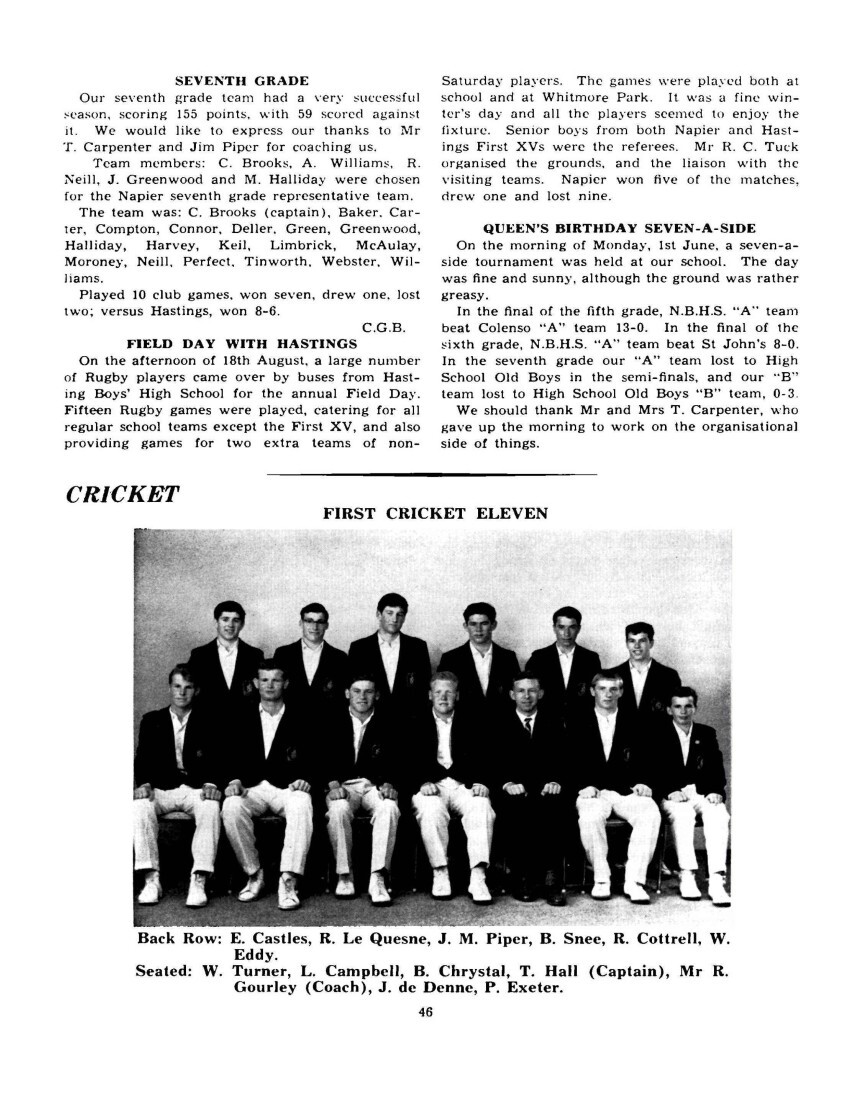
Page 37
1st XI
The team: T. A. Hall (captain), B. Chrystal (vice-captain), L. J. M. Campbell, W. E. D. Turner, J. P. de Denne, P. Exeter, W. Eddy, R. V. Cottrell, R. J. LeQuesne, B. L. Snee, E. M. Castles, J. M. C. Piper.
With the return of only five of 1963’s lst XI, things did not look bright for the 1964 lst XI. However, thanks to the coaching and guiding hand of Mr R. B. Gourley, the team turned into a strong one and in the inter-school matches produced the best results of any 1st XI for a number of years.
There were some outstanding individual performances in the school games this year. Against Gisborne list XI both Campbell and Hall scored centuries (Campbell 101, Hall 152), and together they added 170 runs in a third wicket partnership which must be a school record. On the bowling side, B. Chrystal and B. L. Snee were our mainstays. Thanks to Chrystal’s courage, determination and skill we were able to get Hastings, Gisborne and Palmerston all out reasonably cheaply. Against Gisborne and Palmerston he bowled fast-medium pace for over 30 overs in each innings without a break. This was truly a fine performance.
The team’s fielding left much to be desired at times, but was improving towards the end of the season. The 1st XI would like to thank Mr Gourley most sincerely for the time and effort he has put into his coaching. His success is seen by the results.
SCHOOL MATCHES
v. Hastings B.H.S., December 1963
H.B.H.S. 1st innings: 58 (Chrystal 4 for 20, Larsen 3 for 18).
N.B.H.S. 1st innings: 105 (Campbell 19, Turner 18).
H.B.H.S. 2nd innings: 86 (Chrystal 5 for 25, Larsen 3 for 33).
N.B.H.S. 2nd innings: 43 for 3 (Hall 23 not out).
Result: Outright win to Napier by 7 wickets.
Napier won the toss and put Hastings in to bat. The wicket showed early life and Hastings were all out for 58. In Napier’s first innings, after a good opening stand of 34, there was a collapse and the side was all out for 105.
In Hastings’ second innings they fared little better than in their first and were all out for 86. Early in the second morning of play Napier hit off the required 40 runs and won by 7 wickets. Although the wicket was not good, it could not be blamed for these low scores and the bad batting was characteristic of the game.
v. Gisborne B.H.S., March 1964
G.B.H.S. 1st innings: 172 (Snee 4 for 46, Chrystal 3 for 52, Castles 3 for 54).
N.B.H.S. 1st innings: 376 for 6 declared (Hall 152, Campbell 101, Chrystal 45 not out, de Denne 30).
G.B.H.S. 2nd innings: 221 for 5 at stumps (Chrystal 2 for 47).
Result: Draw (1st innings win to Napier by 204 runs).
Gisborne won the toss and elected to bat on a beautiful batting wicket at the Gisborne Oval. They batted steadily and reached a total of 172. In reply we amassed the large total of 376 for 6 declared. The runs were put on at a tremendous rate, as we batted for only 230 minutes. Gisborne were set with the task of getting 204 runs in 250 minutes to avoid an innings defeat. They batted sensibly and steadily and when the game was finished they had 221 for 5 wickets. This gave a convincing first innings win to Napier.
v. Palmerston North B.H.S., March 1964
P.N.B.H.S. 1st innings: 168 (Chrystal 4 for 52, Snee 4 for 56).
N.B.H.S. 1st Exeter 40).
P.N.B.H.S. 2nd innings: Snee 4 for 64).
N.B.H.S. 2nd innings: 108 for 7 at stumps (Campbell 24; Exeter 27).
Result: Draw (1st innings win to Napier by 22).
Palmerston won the toss and elected to bat. After a bad start they improved their position and reached a total of 166. In our innings the middle order batting was very sound and we passed their total by 22 runs. In Palmerston’s second innings they lost four wickets cheaply, but consolidated their position and had reached 230 (Vaikvee 92) by lunch on the second day. This left Napier to get 208 runs in 150 minutes. At no time did Napier look like achieving its object and when stumps were drawn the score was 108 for 7 wickets.
CLUB MATCHES
v. N.B.H.S. Old Boys
N.B.H.S.O.B. 1st innings: 157 (Gourley 5 for 29).
N.B.H.S. 1st innings: 178 (Gourley 37, Hall 21, Piper 21).
N.B.H.S.0.B. 2nd innings: 143 for 6 declared (Taaffe 3 for 48).
N.B.H.S. 2nd innings: 110 for 4 (Gourley 36, Seuseu 24).
Result: Win to N.B.H.S. by 21 runs on 1st innings.
v. Midland Rugby
N.B.H.S. 1st innings: 105 (Larsen 22, Turner 24).
Mid. Rug. 1st innings: 161 for 8 declared (Taaffe 3 for 45).
N.B.H.S. 2nd innings: 103 (Piper 30, McDougall 43).
Mid. Rug. 2nd innings: 48 for 0
Result: Outright win to Midland Rugby by 10 wickets.
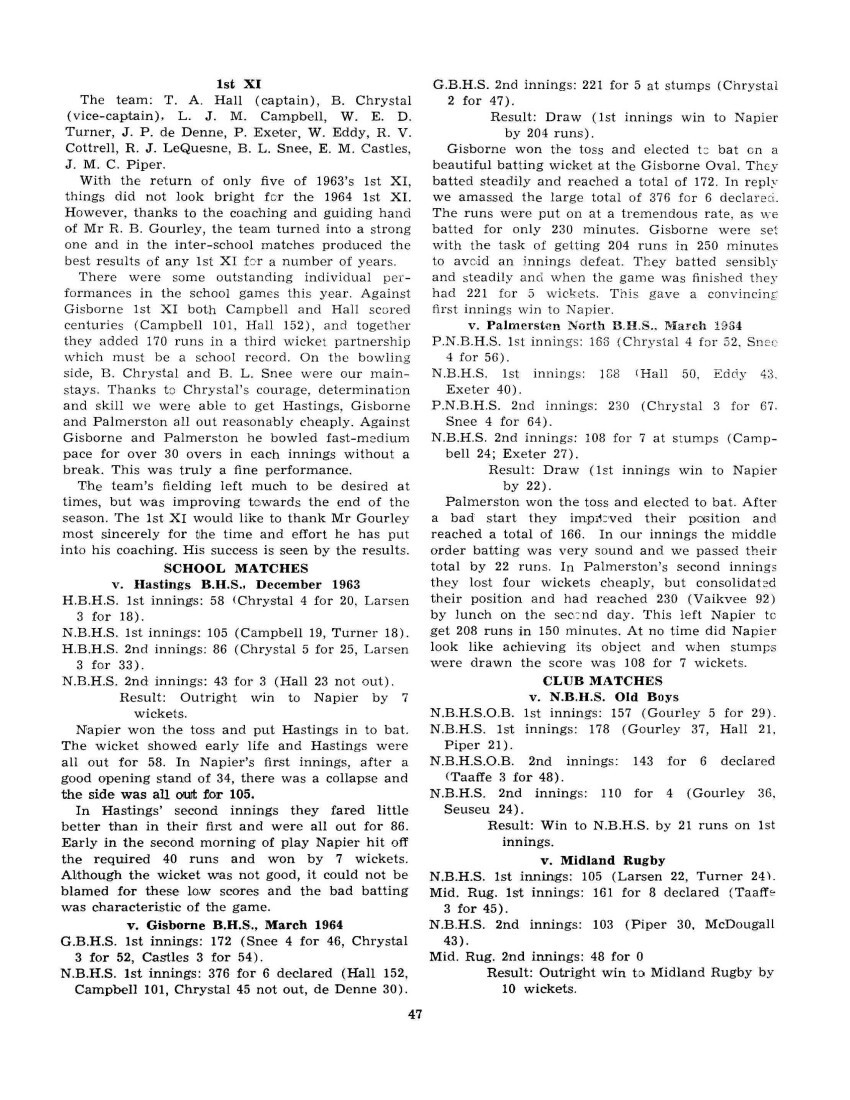
Page 48
v. Tech. O.B.
N.B.H.S. 1st innings: 125 (Hall 35, McDougall 45).
T.O.B. 1st innings: 120 (Chrystal 4 for 42, McDougall 3 for 33).
N.B.H.S. 2nd innings: 95 for 5 declared (Hall 44).
T.O.B. 2nd innings: 31 for 4 at stumps.
Result: N.B.H.S. won on 1st innings by 5 runs.
v. Marist
N.B.H.S. 1st innings: 140 (Campbell 51, Gourley 30, Exeter 32).
Marist 1st innings: 238 (Chrystal 6 for 84).
N.B.H.S. 2nd innings: 155 (Larsen 23, Exeter 56).
Marist 2nd innings: 58 for 1.
Result: Outright win for Marist by 9 wickets.
v. Taradale
N.B.H.S. 1st innings: 173 (Campbell 63, McDougall 28).
Taradale 1st innings: 284 (McDougall 4 for 87).
N.B.H.S. 2nd innings: 104 (Exeter 20, de Denne 24).
Result: Taradale won by an innings and six runs.
v. Hastings Old Boys
O.B.H. 1st innings: 245 for 8 declared (Castles 4 for 38).
N.B.H.S. 1st innings: 42 (Campbell 26).
N.B.H.S. 2nd innings: 160 (Hall 24, Exeter 48, Gourley 43).
Result: Win to Hastings O.B. by innings and 43 runs.
v. Whakatu-Mahora
N.B.H.S. 1st innings: 91.
Whak.-Mah. 1st innings: 107 (Chrystal 5 for 36, Campbell 2 for 13).
N.B.H.S. 2nd innings: 144 for 7 declared (Campbell 24, de Denne 27).
Whak.-Mah. 2nd innings: 72 for 8 at stumps (Snee 3 for 31).
Result: 1st innings win to Whakatu-Mahora by 16 runs.
SECOND ELEVEN
The second cricket XI is enjoying another successful year, being undefeated in competition matches to date. Much credit for this success must go to Mr Knight whose coaching and interest in the team have given inspiration to all its members. Only one inter-school fixture has been played this year, against Gisborne H.S. 2nd XI, and this proved to be an exciting one. After being comfortably positioned at the end of the first day’s play our team slumped badly in the latter stages to the game. This led to our being dismissed for 82 runs in the second innings (six runs short of the Gisborne total) with only a few minutes of play remaining. The team was G. Robinson, J. Piper, I. Donaldson, B. Tucker, G. Dick, G. Field, N. Bishop, C. Clark, B. Taaffe, I. McBride and R. Lee.
The results were:
Gisborne: 151 (Tucker 4-31, Field 4-28).
Napier: 179 (Robinson 84, Donaldson 42, Bishop 25).
Gisborne: 116 (Dick 3-16, Field 3-34).
Napier: 82 (Dick 25, Field 18). Gisborne won by six runs.
G.W.R.
THIRD ELEVEN
This year’s third eleven was: W. Sadler captain), K. Weston, P. Johnston, J. Greenwood, T. Wilson, P. Tuck, J. Hall, G. Barrie, W. Fleming, R. Bray, B. McCorkindale, J. Prince, P. Morrin, C. Gardner.
The team played in the schoolboy 1st grade and at the end of the first term was second in this competition behind the Karamu 1st XI. In five games the team recorded three outright wins, one draw and one outright loss, although taking first innings points in that game.
Our sincere thanks go to Mr Ware for the time he has given up in coaching the team. We believe that his ability as a coach is indicated by the success which the team is enjoying at the present time.
FOURTH ELEVEN
Some promising players are showing up in the fourth eleven. Thanks to our coach, Mr R. Anderson, we have had good and profitable practices. Playing in the Saturday afternoon competition, the 4th XI has so far met St John’s, our 3rd XI, and Lindisfarne. The 3rd XI proved too strong, but we had good games and small-margin losses against the other two teams. The team was: J. Harris (captain), A. Buchanan, D. Christie, E. Clayton, M. Cooper, S. Godwin, P. Kaukau, D. Kingi, L. Kyle, R. Lemin, S. Marshall, P. Pearse, W. Roydhouse, R. Young.
FIFTH ELEVEN
In the first term the Colts group consisted of: P. Lee (captain), Baker, Ball, Boyd, Hamilton, Hannah, Monk, Morrison, Neal, Nilsson, Olson, Petuha, Spackman, Tinworth and Toop. Coaches were Messrs Revell and Mundy. Saturday morning games were held against Napier Intermediate and Boarders-Dayboys. In the third term, Mr G. Beer (a hostel master and Plunket Shield player) has formed a Scinde House eleven consisting of: Baker, Carr, Connor, Lee, Monk, Morrison, Petuha, Pohio, Spackman, Tinworth, Toop and Wood. This has unfortunately left keen dayboys (Hannah, Neal, Olson, Hamilton and Hastie) without a full eleven; but they have continued to practise and will be valuable cricket players for the school next year.
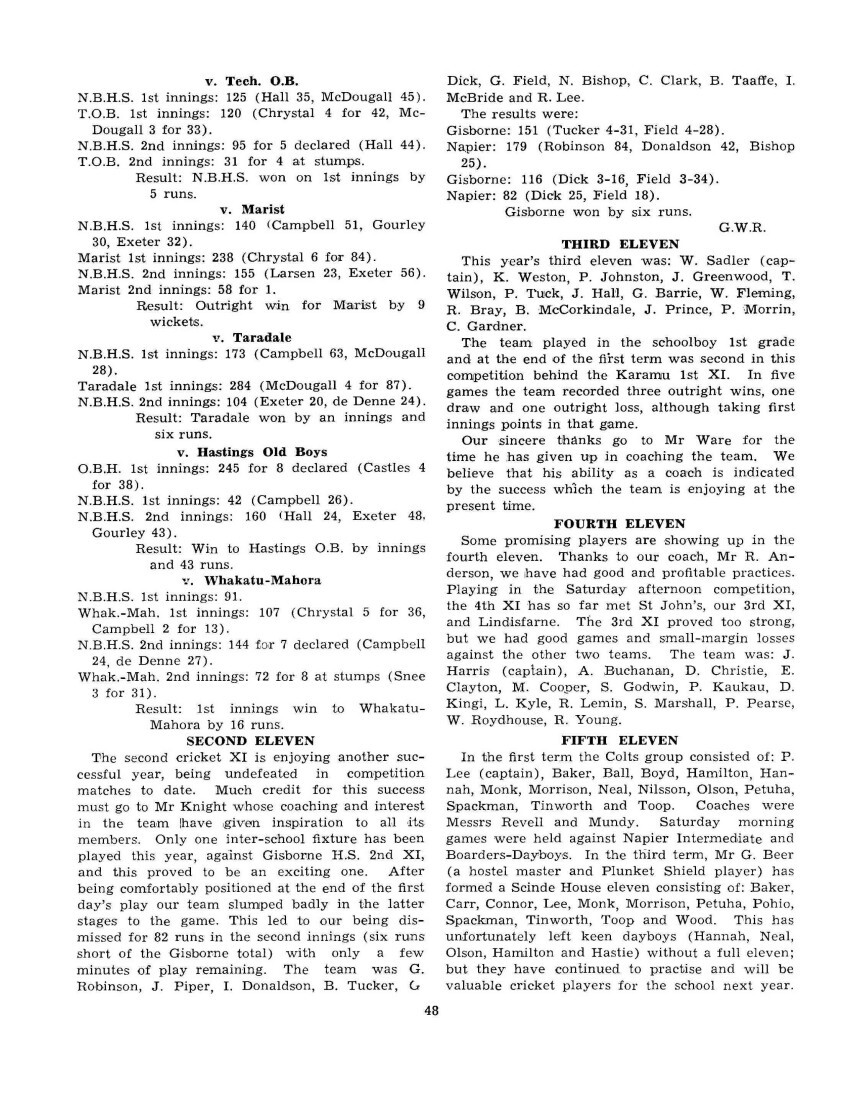
Page 49
SECOND CRICKET ELEVEN
Back Row: C. Clark, N. Bishop, I. Donaldson, B. Tucker, B. Taaffe.
Seated: I. McBride, G. Field, Mr P. S. Knight (Coach), G. Robinson, (Captain), J. A. Piper, G. Dick, A. R. Lee.
ATHLETICS
INTER-SCHOOL STEEPLECHASE
The school was host and organiser of an Inter- School Steeplechase on Saturday, 3rd October. Mr I. Roberts with the assistance of the Napier Harrier Club arranged two good courses, mainly over the school farm, and invited all the Post-Primary Schools in Hawke’s Bay to participate.
Eight schools entered teams of six runners in the Senior and Junior races. The schools were: N.B.H.S., Colenso, St. John’s. Hastings B.H.S. Karamu, Wairoa, Central H.B. and Lindisfarne.
The event was so successful that all teams requested that it be an annual sporting fixture over the same courses.
Our prominent runner was R. Nant who finished third in the senior race over four miles in the time of 24 minutes 34 seconds. Central Hawke’s Bay won the senior race and Colenso second. N.B.H.S. was fifth. In the junior event (21 miles) Colenso was first. R. Neill came in fifth with a time of 17 minutes 27 seconds: and the N.B.HS. won third placing. Twenty boys from our school acted as pointers on the two steeplechase courses.
L.J.R.
ATHLETIC TEAM
At the Inter-Secondary Schools Athletic Sports held at Wairoa on Saturday, 21st March, our intermediate hurdler M. Mear, was one of the five to break records. When he won the intermediate 80 metres hurdles he created a new record of 11.9 seconds.
In the intermediate 100 yards R. Robertson and M. Mear both took first place in their heats. There was a thrilling struggle between them in the final. Robertson won by inches from Mear, giving both first and second places to N.B.H.S. The time of 10.8 secs. was only 0.1 sec. outside the record.
The intermediate A schools relay was won by Napier in 48secs. Had the wind dropped, perhaps a record could have been broken as the record stands at 47 secs.
The following were those who represented the school at Wairoa: –
Seniors: G. Robinson (captain), R. Nant (vice-captain), J. de Denne, T. McLennan, W. Avenell. R. Malcolm, B. Baudinet, G. Wiig, A. Strachan.
Intermediates: M. Mear, R. Robertson, J. Andrews. P. Robinson, M. Pearse, B. Mackintosh, K. Weatherley, D. Boardman, R. Forrest. R. Pawluk. R. Meaclem.
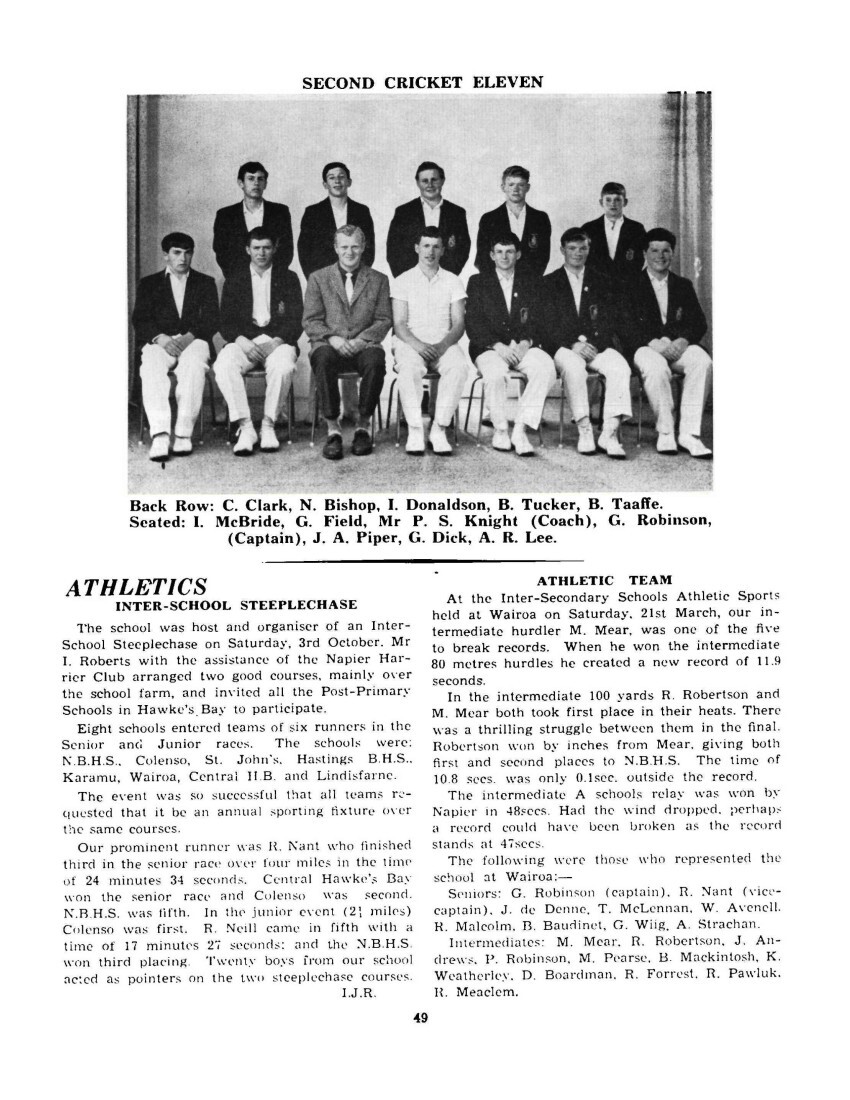
Page 50
SCHOOL ATHLETIC TEAM
Back Row: T. McLennan, R. Forrest, M. Mear, P. Robinson, G. Wiig, B. Baudinet, R. Pawluk. Middle Row: Mr C. Nicol (Coach), M. Pearse, J. Danks, S. Little, R. Meaclem, J. Andrews, R. Robertson, D. Merritt, Mr I. Roberts (Coach).
Front Row: B. Mackintosh, W. Avenell, P. Smith, G. Robinson (Captain), Mr C. Matthews (Coach), R. Nant, D. Boardman, G. Galgey, R. Schofield.
Juniors: R. Schofield, P. Smith, D. Merritt, S. Little, J. Danks, G. Galgey.
Successes won by team members in their finals were: –
Seniors: G. Wiig, 1st in discus (125ft. 43ins.). G. Robinson, 3rd in 440, 2nd in javelin. Intermediates: P. Robinson: 2nd in 440 yards. M. Mear, 1st in 80 metres hurdles (11.9 secs. record), 2nd in 100 yards. R. Robertson: 1st in 100 yards (10.8 secs)., 3rd in long jump. R. Pawluk, 3rd in discus. Relay team: 1st in A relay (48 secs).
Juniors: R. Schofield, 2nd in 100 yards. Relay team, 2nd in A schools relay.
A large party from the hostel gave good support to our team. The team were grateful to Messrs Nicol, Matthews and Roberts for their coaching before the fixture. Mr C. Nicol was the team manager.
SCHOOL STEEPLECHASE
Senior: Individual placings: 1, Robinson (Sc); 2 Nant (Sc); 3, Pishief (He); 4, Wilson (He); 5, Strachan (Sc); 6, Reid (Sc); 7, Malcolm (Col.); 8, Tuck (Ha); 9, Avenell (Sc); 10, Lavery (Cl). House placings: 1, Heretaunga; 2, Scinde; 3, Clyde; 4, Colenso; 5, Napier; 6, Hawke.
Intermediate: Individual placings: 1, Hodgkinson (Col); 2, B. Mackintosh (Se): 3, Kenah (Na): 4, Boardman (Ha); 5, Marshall (Ha); 6, Mackintosh (Se); 7, Herdman (Cl); 8, Weatherley (C1); 9, McCutcheon (Cl); 10, Fuller (Ha). House placings: 1, Colenso; 2, Scinde; 3, Clyde; 4, Hawke; 5, Napier; 6, Heretaunga.
Junior: Individual placings: 1, Neill (Se); 2, Farquharson (Sc); 3, Northe (Sc); 4, Clinch (Ha); 5, Baty (Sc); 6, McGregor (Cl): 7, Ralfe (Ha); 8, Moore (Ha); 9. Spackman (Sc). House placings: 1, Scinde; 2, Hawke; 3. Clyde; 4, Napier; 5, Heretaunga; 6, Colenso.
HARRIERS
During the winter term twenty to thirty boys have been in Thursday afternoon harriers. With Mr W. H. Tetley in charge, the programme has been long training tuns down to the end of Georges Drive or trials round the School steeplechase course. R. K. Malcolm. a senior harrier, came seventh in the school Senior Steeplechase. In the Intermediate Steeplechase. E. Hodgkinson, another member of the group, came in first. Unfortunately not all who are known as harriers in the school belong to this group as many play Rugby, and others are more closely associated with the Napier Harrier Club. B.T.D.

Page 51
PHYSICAL EDUCATION COMPETITION
It was relatively fine on the morning of the 13th November, and the third and fourth form competitions were held outside. In the afternoon heavy passing showers caused the fifth and sixth form competitions to be transferred inside to the gymnasium. The judge was Mr I. Roberts, who was on the staff of the Navy Phys. Ed. School at Portsmouth for part of the War, and also a Phys. Ed. instructor for the English Northern Board of Education. Mr Roberts found himself awarding the highest marks for enthusiasm and vigour. In general, the lower marks went to posture and physical control during the activities. ‘I would like to see more fluency of movement throughout the whole lesson, as distinct from order and drill,” commented Mr Roberts. 1963’s 3A and 3 Mod, who led their competition, won again as 1964’s 4A and 4 Mod. The results were: –
Third Form: 1st 3 Gen; 2nd 3B; 3rd equal 3A and 3 Spec.
Fourth Form: 1st 4A; 2nd 4 Mod; 3rd 4 Gen.
Seniors: 1st 5S; 2nd 5U; 3rd equal 6B gamma and 6B beta.
The individual championships will be held during the last week of the school year.
TABLOID SPORTS
Each year one of the most impressive sights on the front field of the school is the Tabloid Sports, held this year on the 8th October. Junior and senior teams from each house marched in impressive ranks from event to event, putting up well with the cold wind which made it very unpleasant to spend over an hour in phys. ed. attire.
The Deportment, with a possible of 120 marks, was won by Scinde Seniors under G. W. Robinson and Scinde Juniors under D. D. Kerr. L. H. Karatau commanded the Clyde Senior ranks to come a very good second. Colenso Juniors, who came second for Deportment in the junior competition, were well drilled and willing to put in the effort with their leader R. K. Malcolm.
Twelve activities were provided. It was hardest to qualify in the hockey dribble, Rugby punt and soccer dribble. It was easiest to reach the qualifying standard in the 100 yards sprint, the softball pitch, the 50 yards backwards, the wheelbarrow, and the standing long jump. Mr Nicol commented, “It is pretty good when you think that 60 per cent of the winning house qualified in the twelve activities.”
As Scinde House marches in its impressive columns of four around the field, most observers think that they cannot help but win the tabloid sports. The marks, however, are brought to a percentage in relation to the numbers in the house. In fact, Heretaunga won the 1962 Tabloid Sports and Colenso came first this year. Colenso were well primed with the will to win after last year’s near-success and every member put in the little extra effort.
Senior results: 1st, Colenso; 2nd, Scinde; 3rd. Clyde; 4th, Hawke; 5th, Heretaunga; 6th, Napier.
Junior results: 1st, Colenso; 2nd, Scinde; 3rd. Hawke; 4th equal, Clyde and Heretaunga; 6th. Napier.
Mr C. Nicol organized the printing of forms. the marking out of the field, the briefing of teams and the man-power for the activities. Mr D. Brebner processed the team results.
ATHLETIC SPORTS
Thursday and Friday, 5-6 March, were devoted to the Athletic Sports at the school grounds. R. H. Nant took the Senior Championship with an outstanding record of wins. In the senior championship discus, G. Wiig threw the discus 121 feet 11 inches, and broke C Bennett’s 1960 record of 114 feet 2 inches.
An intermediate record was broken when M. Mear cleared 5 feet 5 inches in the intermediate high jump and so broke the previous record of 5 feet 44 inches, held by R. Reid in 1955 and by M. Mear himself in 1963.
A junior championship record was broken by J. Danks who ran the junior championship 880 in 2 min. 25.2 sec., and so broke B. Mackintosh’s 1963 record of 2 min. 25.6 sec.
When announcing these records, Mr Caird, the headmaster, thanked Mr Nicol who was manager of the sports. He particularly mentioned Mr Simpson and the boys who did the clerical work. Mr Caird also thanked Mr Matthews, Mr Roberts and their assistants who marked out the field.
A very complicated relay was organised to be contested by the masters, the apprentices and the prefects. In this event, the prefects came in first, the masters were second and the engineering apprentices were third.
Before the sports started on Friday morning, we had a gymnastic display given by courtesy of the Naval Board, with Lt. H. Gee as instructor. This lasted for 45 minutes and included agilities with mats, agilities with mini-tramp, agilities with the trampoline and with the box-horse. To conclude, the team gave a cutlass display and a display of chair tricks suitable for the confined space of a ship. Our head prefect, G. W. Robinson, expressed the thanks of the whole school to the team at the end.
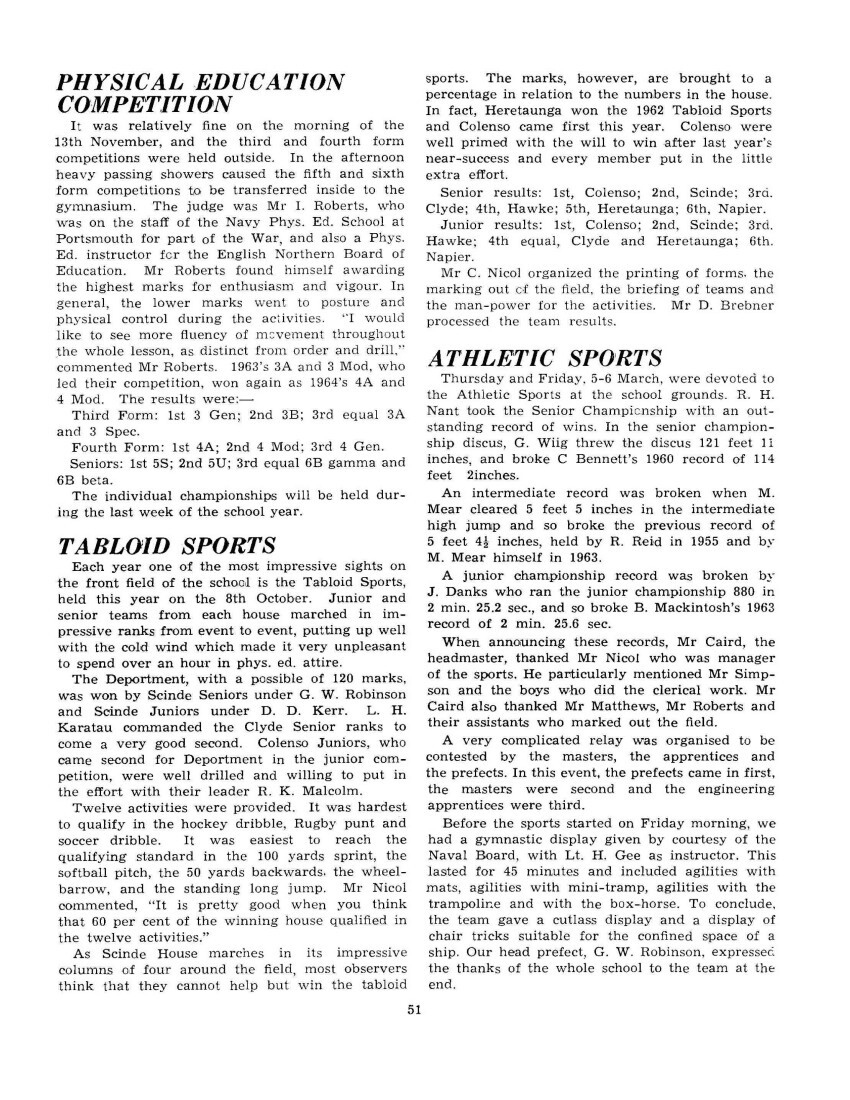
Page 52
ATHLETICS SENIOR CHAMPIONSHIP
EVENT FIRST SECOND THIRD PERFORMANCE
100 yards R. Nant (Sc.) T. McLennan (Col.) W. Avenell (Sc.) 11.2 secs.
220 yards R. Nant (Sc.) T. McLennan (Col.) W. Avenell (Sc.) 24.2 secs.
440 yards R. Nant (Sc.) G. Robinson (Sc.) W. Avenell (Sc.) 54.1 secs.
880 yards R. Nant (Sc.) G. Robinson (Sc.) R. Malcolm (Col.) 2 mins. 11.2 secs.
One mile R. Nant (Sc.) G. Robinson (Sc.) A. Strachan (Sc.) 4 mins. 48.4 secs.
120 yards hurdles J. de Denne (Sc.) P. Carney (Sc.) T. McLennan (Col.) 18.4 secs.
Long jump B. Baudinet (Ha.) R. Le Quesne (N.) M. Lambert (Ha.) 17ft 5ins.
High jump B. Baudinet (Ha.) J. Vivieaere (Col.) R. Le Quesne (N.) 5ft 0ins.
Hop, step and jump B. Baudinet (Ha.) T. McLennan (Col.) J. de Denne (Sc.) 40ft 5½ins.
Shot put G. Wiig (Col.) W. Sadler (Col.) J. de Denne (Sc.) 32ft 4ins.
Javelin throw G. Robinson (Sc.) B. Baudinet (Ha.) K. Johnstone (Sc.) 122ft 9½ins.
Discus G. Wiig (Col.) G. Robinson (Sc.) B. Baudinet (Ha.) 121ft 11 ins. (record)
House relay Colenso Clyde Napier 50.6 secs.
CHAMPION R. Nant (25.) B. Baudinet (19) G. Robinson (17)
INTERMEDIATE CHAMPIONSHIP
EVENT FIRST SECOND THIRD PERFORMANCES
100 yards R. Robertson (N.) M. Mear (Ha.) J. Andrews (Sc.) 11.3 secs.
220 yards M. Mear (Ha.) R. Robertson (N.) J. Andrews (Sc.) 24.8 secs.
440 yards D. Munro (Sc.) B. Mackintosh (Sc.) M. Pearse (Sc.) 57.1 secs.
880 yards D. Boardman (Ha.) K. Weatherley (Cl.) J. Bissell (Col.) 2 mins. 12.2 secs.
One mile B. Mackintosh (Sc.) D. Boardman (Ha.) N. Bishop (Ha.) 4 mins. 59.1 secs.
80 metres hurdles M. Mear (Ha.) R. Forrest (Sc.) D. Munro (Sc.) 12.6 secs.
Long jump M. Mear (Ha.) R. Robertson (Na.) J. Andrews (Sc.) 18ft 4½ins.
High jump M. Mear (Ha.) M. Willis (Sc.) K. Weatherley (Cl.) 5ft. 5ins. (record)
Hop, step and jump K. Weatherley (Cl.) A. Sherwood (Sc.) R. Pawluk (Col.) 36ft 7½ ins.
Shot put L. Dallimore (Cl.) R. Farmer (Sc.) J. Andrews (Sc.) 35ft 10ins.
Javelin throw R. Meaclem (Sc.) B. Marshall (Sc.) P. Robinson (Sc.) 120ft 8ins.
Discus R. Pawluk (Col.) R. Robertson (N.) R. Farmer (Sc.) 119ft 7ins.
House relay Scinde Clyde Napier 50.7 secs.
CHAMPION M. Mear (23) R. Robertson (14) K. Weatherley (9)
JUNIOR CHAMPIONSHIP
EVENT FIRST SECOND THIRD PERFORMANCE
100 yards R. Crawford (Col.) R. Schofield (N.) P. Kau Kau (Ha.) 12.1 secs.
220 yards R. Schofield (N.) G. Smith (Ha.) R. Lemin (N.) 27.2 secs.
440 yards D. Merritt (Ha.) S. Little (Cl.) B. McGregor (Cl.) 62 secs.
880 yards J. Danks (He.) R. Neill (Sc.) B. McGregor (Cl.) 2 mins 25.2 sec. (record)
80 metres hurdles G. Galgey (Col.) C. Love (Cl.) I. Baudinet (Ha.) 13.6 secs.
Long jump D. Merritt (Ha.) R. Schofield (N.) R. Lemin (N.) 16ft 0ins.
High jump R. Crawford (Col.) G. Galgey (Col.) B. Stitson (Ha.) 4ft 6ins.
Hop, step and jump R. Crawford (Col.) R. Schofield (N.) G. Galgey (Col.) 33ft 2½ins.
House relay Napier Scinde Hawke 54.8 secs.
CHAMPION R. Crawford (15) R. Schofield (14) D. Merritt (10)
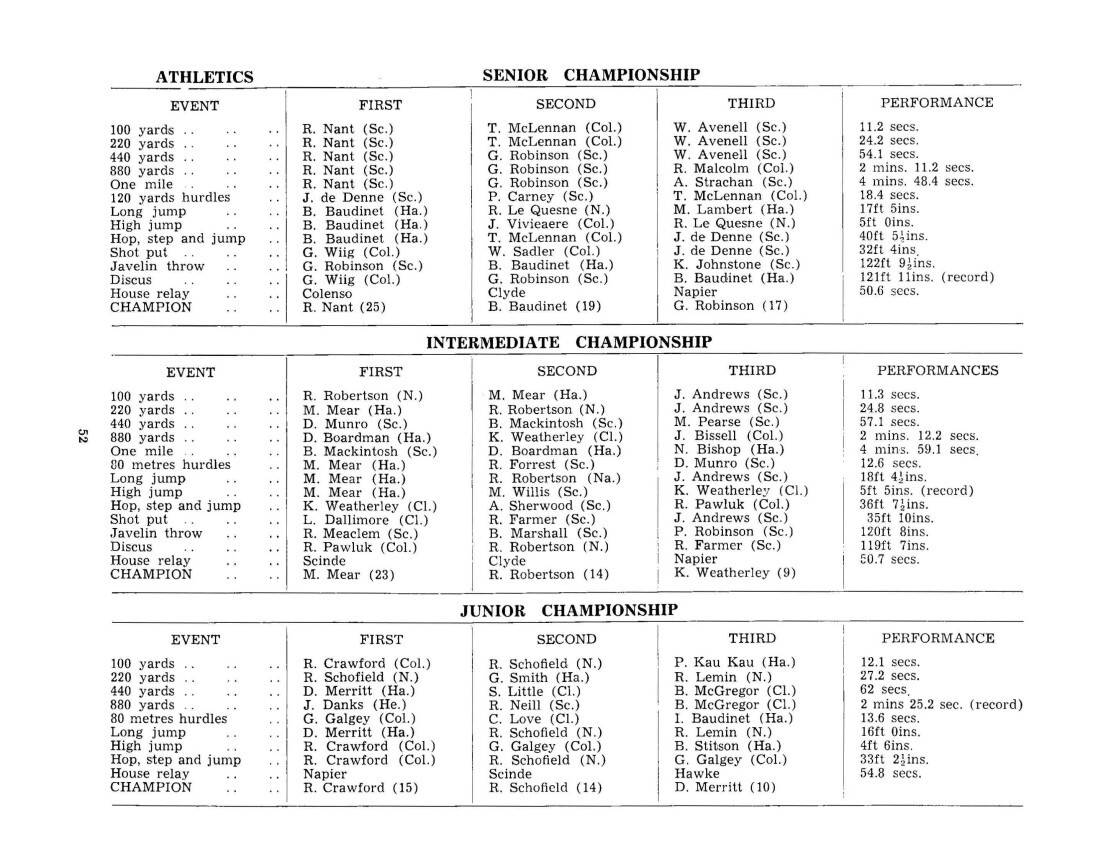
Page 53
ATHLETICS
OVER 17 YEARS NON-CHAMPIONSHIP EVENTS
EVENT FIRST SECOND THIRD PERFORMANCE
100 yards B G. Nuttall (Col.) J. A. Piper (Col.) P. Carney (Sc.) 11.7 secs.
100 yards C J. M. Piper (Col.) R. King (Col.) R. Heiford (N.) 12.1 secs.
220 yards B J. Prince (Cl.) P. Carney (Sc.) J. A. Piper (Col.) 25.7 secs.
220 yards C J. M. Piper (Col.) G. Ebbett. (Sc.) C. Smith (N.) 26.6 secs.
440 yards B J. A. Piper (Col.) P. Dick (Col.) R. Sherwood (Sc.) 58.0 secs.
880 yards B R. Sherwood (Sc.) P. Dick (Col.) J. A. Piper (Col.) 2 min 23.6 secs.
Cricket ball throw J. Pishief (He.) L. Campbell (Ha.) D. Simonsen (Ha.) 236ft 7ins.
Davis Cup hurdles G. Robinson (Sc.) T. Smith (Cl.) J. de Denne (Sc.) 17.1. secs.
Cornford Cup handicap Mile A. Strachan (Sc.) E. Hodgkinson (Col.) R. Cottrell (Ha.) 4 min. 47 secs.
High jump J. Prince (Cl.) P. Dick (Col.) L. Karatau (Cl.) 4ft 9ins.
Hop, step and jump J. Prince (Cl.) W. Turner (Col.) P. Dick (Col.) 37ft 6ins.
Long jump J. Piper (Col.) J. Prince (Cl.) R. Sherwood (Sc.) 16ft 11ins.
Pole vault B. Baudinet (Ha.) R. Frogley (He.) R. Roberts (Col.) M. Rule (He) 8ft 1in.
EVENT FIRST SECOND THIRD PERFORMANCE
100 yards B G. Dick (Sc.) C. Lum (N.) T. Smith (Cl.) 11.9 secs.
100 yards C A. Ware (Cl.) G. Exeter (Cl.) A. Godwin (N.) 11.9 secs.
100 yards D J. Slight (Ha.) G. Harvey (Sc.) G. Earnshaw (N.) 12.2 secs.
100 yards E P. Stimpson (Ha.) L. Black (N.) I. McKay (He.) 13.4 secs.
220 yards B B. Tucker (Sc.) C. Lum (N.) G. Exeter (Cl.) 26.3 secs.
220 yards C M. Simpson (Sc.) R. Paterson (Ha.) A. Marsters (Sc.) 27.0 secs.
220 yards D J. Slight (Ha.) G. Harvey (Sc.) G. Earnshaw (N.) 27.0 secs.
440 yards B T. Smith (Cl.) D. Read (Sc.) H. Trafford (Sc.) 58.8 secs.
440 yards C I. Gilray (Sc.) K. Cameron (Sc.) G. Pond (Cl.) 61.9 secs.
440 yards D C. Svendsen (Cl.) G. Harvey (Sc.) J. Slight (Ha.) 61.1 secs.
440 yards E R. Westerman (Sc.) I. McKay (He.) D. King (Sc.) 65.2 secs.
880 yards B G. Northe (Col.) H. Trafford (Sc.) I. Gilray (Sc.) 2 mins. 22 secs.
880 yards C A. Strachan (Sc.) C. Svendsen (Cl.) H. Tennent (Sc.) 2 mins. 20.9 secs.
Cricket ball throw M. Kenah (N.) G. Field (Sc.) J. Scott (N.) 241ft 7ins.
High jump D. Kerr (Sc.) C. Lum (N.) H. Trafford (Sc.) 4ft 9ins.
Hop, step and jump B. Tucker (Sc.) C. Lum (N.) A. Marsters (Sc.) 35ft 6½ins.
Long jump B. Tucker (Sc.) A. Marsters (Sc.) G. Phillips. (Sc.) 16ft 10¾ins.
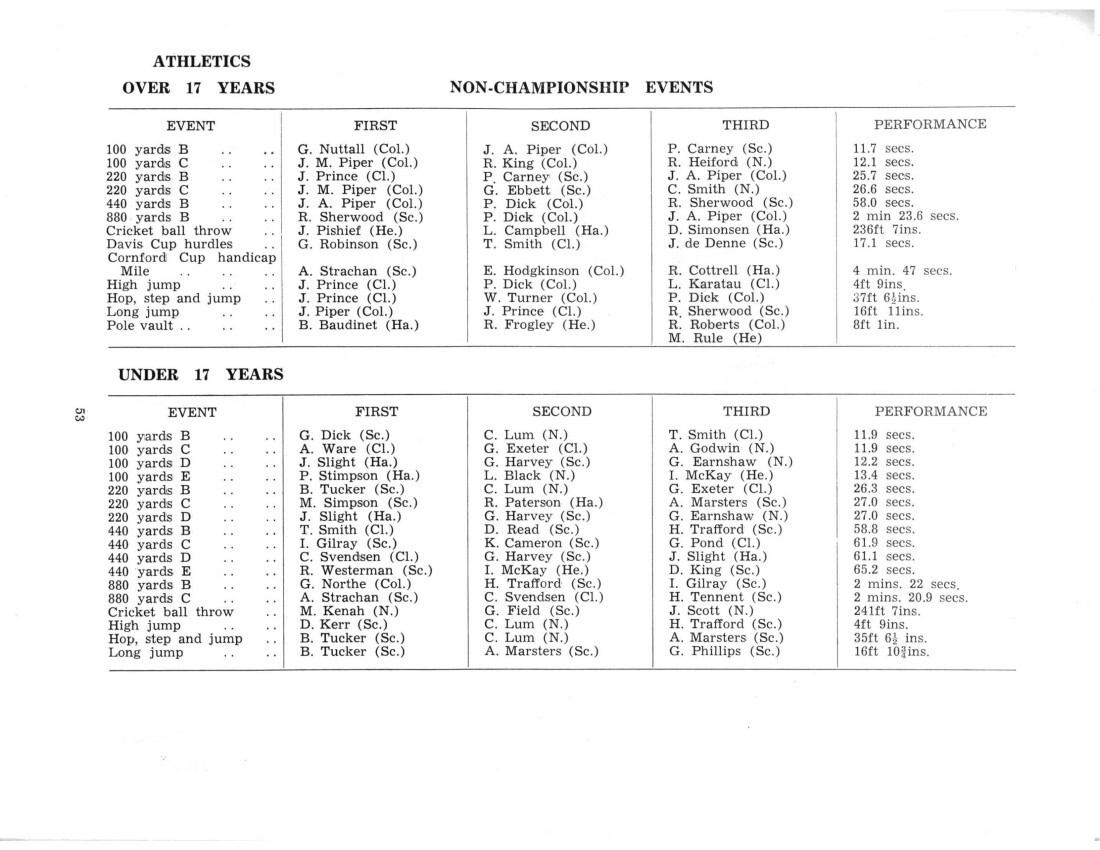
Page 54
ATHLETICS
UNDER 16 YEARS
EVENT FIRST SECOND THIRD PERFORMANCE
100 yards B D. Stevenson (Cl.) C. Clark (Col.) W. McCorkindale (Sc.) 11.9 secs.
100 yards C H. Black (Cl.) A. McGowan (Cl.) M. Martin (N.) 12.2 secs.
100 yards D P. Morrin (Sc.) D. Jenkinson (Ha.) G. Bigg (N.) 12.4 secs.
100 yards E G. McKenzie (Col.) I. Blair (Sc.) R. Jackson (Cl.) 11.8 secs.
220 yards B P. Robinson (Sc.) D. Stevenson (Cl.) J. Olsen (Cl) 26.1 secs.
220 yards C G. Crarer (Ha.) M. Kenah (N.) R. Porter (Cl.) 27.5 secs.
220 yards D W. Takiwa (Ha.) P. Morrin (Sc.) K. McClure (N.) 25.4 secs.
220 yards E G. McKenzie (Sc.) I. Blair (Sc.) R. White (Sc.) 26.8 secs.
440 yards B P. Robinson (Sc.) C. Brunton (He.) W. Takiwa (Ha.) 58.9 secs.
440 yards C M. Kenah (N.) G. Crarer (Ha.) W. August (Sc.) 62.7 secs.
440 yards D P. Morrin (Sc.) M. McSporran (Col.) R. Fleming (Sc.) 67.0 secs.
440 yards E C. Bayliss (Cl.) D. Jenkinson (Ha.) R. White (Sc.) 66.4 secs. 2 mins.
880 yards B P. Robinson (Sc.) C. Brunton (He.) B. Davidson (Sc.) 27.5 secs. 2 mins.
880 yards C W. Takiwa (Ha.) M. Kenah (N.) P. Newham (Ha.) 27.8 secs.
Cricket ball throw A. Sherwood (Sc.) J. Bergman (N.) C. Clark (Col.) 246ft 1in.
High jump G. Scholes (N.) G. McKenzie (Col.) D. Oliver (Sc.) 4ft 7ins.
Hop, step and jump L. Bennett (He.) W. August (Sc.) A. Richards (N.) 34ft 3½ins.
Long jump D. Stevenson (Cl.) B. Harvey (Sc.) R. Treseder (Sc.) 15ft 8½ins.
UNDER 15 YEARS
EVENT FIRST SECOND THIRD PERFORMANCE
100 yards B. F. Cameron (Sc.) B. Manson (N.) M. Lee (Col.) 12.2 secs.
100 yards C. G. Macdonald (He.) R. Turner (Cl.) C. Fraser (Sc.) 12.4 secs.
100 yards D. G. Veale (Col.) A. Glockling (Cl.) G. Chittenden (Col.) 12.9 secs.
100 yards E. G. Tong (He.) W. Kohlis (N.) R. Harper (Ha.) 13.3 secs.
220 yards B. B. Manson (N.) F. Cameron (Sc.) A. Parker (Col.) 26.8 secs.
220 yards C. G. Macdonald (He.) A. Hopcroft (N.) G. Fuller (Ha.) 27.3 secs.
220 yards D. D. Elliott (Ha.) R. Iremonger (Ha.) S. Cross (Cl.) 25.3 secs.
220 yards E. G. Byers (He.) G. Tong (He.) W. Kohlis (N.) 29.2 secs.
440 yards B. F. Cameron (Sc.) I. Richardson (Sc.) R. Gattsche (Cl.) 61.1 secs.
440 yards C. A. Hopcroft (N.) C. Fraser (Sc.) H. McCutcheon (Cl.) 62.4 secs.
440 yards D. G. Veale (Col.) I. Cook (N.) M. Wong (He.) 65.7 secs.
High jump A. Parker (Col.) F. Cameron (Sc.) C. Fraser (Sc.) I. Richardson (Sc.) 4ft. 6ins.
Hop, step and jump R. Turner (Cl.) B. Taaffe (Sc.) B. Manson (N.) 34ft. 0¾ins.
Long jump R. Turner (Cl.) R. Tucker (Sc.) B. Manson (N.) 15ft. 5ins.
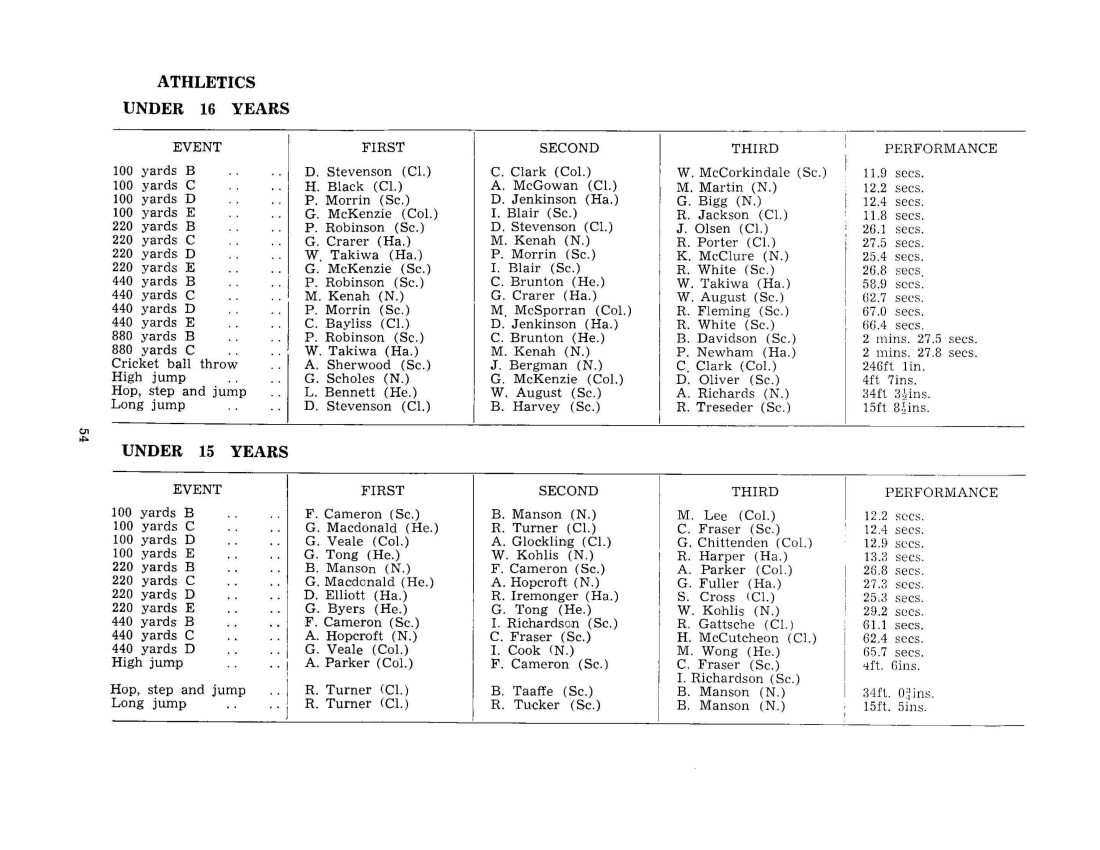
Page 55
ATHLETICS
UNDER 14 YEARS
EVENT FIRST SECOND THIRD PERFORMANCE
75 yards B. E. Hardgrave (N.) W. Leach (Sc.) A. Bowling (Sc.) 9.7 secs.
75 yards C. S. Hannah (Col.) B. Snee (Col.) W. Monk (Sc.) 9.9 secs.
75 yards D. T. Maru (Sc.) J. Brownlie (Sc.) J. Castles (Sc.) 10.3 secs.
75 yards E. F. Reti (He.) N. Struthers (Sc.) P. Puna (He.) 10.4 secs.
100 yards B. E. Hardgrave (N.) A. Williams (Cl.) R. Wright (Sc.) 12.6 secs.
100 yards C. R. Kennedy (Cl.) W. Monk (Sc.) B. Snee (Col.) 13.0 secs.
100 yards D. B. Spain (He.) T. Maru (Sc.) J. Ennor (Cl.) 13.0 secs.
100 yards E. N. Struthers (Sc.) T. Jane (He.) M. Smith (Col.) 13.3 secs.
220 yards B. A. Bowling (Sc.) A. Williams (Cl.) L. Crabtree (N.) 28.7 secs.
220 yards C. W. Monk (Sc.) L. Kyle (Sc.) J. Sutton (Sc.) 28.6 secs.
220 yards D. J. Reid (N.) J. Brownlie (Sc.) J. Ennor (Cl.) 30.6 secs.
220 yards E. N. Struthers (Sc.) P. Deller (Sc.) M. Graham (He.) 32.1 secs.
440 yards B. A. Bowling (Sc.) R. Wright (Sc.) L. Crabtree (N.) 66.6 secs.
440 yards C. L. Kyle (Sc.) S. Hannah (Col.) J. Sutton (Sc.) 67.0 secs.
440 yards D. J. Eastwood (Sc.) I. MacEwan (Sc.) J. Barrow (Col.) 70.5 secs.
440 yards E. P. Deller (Sc.) N. Struthers (Sc.) J. Hunt (Cl.) 73.5 secs.
High jump T. Uriarau (N.) W. Nightingale (Ha) A. Griffiths (He.) 4ft. 3ins.
Long jump E. Hardgrave (N.) B. Snee (Col.) I. MacEwan (Sc.) 14ft. 6ins.
UNDER 13 YEARS
EVENT FIRST SECOND THIRD PERFORMANCE
75 yards B B. Pohio (Sc.) D. Leggett (N.) P. Lee (Sc.) 10.2 secs.
75 yards C C. Olson (Ha.) T. Thornburrow (Ha.) J. Bee (Ha) 11.1 secs.
100 yards B B. Pohio (Sc.) D. Leggett (N.) D. Kingi (Cl.) 13.2 secs.
100 yards C S. Hamilton (Ha.) C. Olson (Ha.) J. Bee (Ha.) 14.3 secs.
220 yards B B. Pohio (Sc.) A. Fraser (Sc.) C. Olson (Ha.) 30.9 secs.
High jump A. Fraser (Sc.) W. Green (Cl.) B. Pohio (Sc.) 3ft 11ins.
Long jump B. Pohio (Se.) A. Fraser (Sc.) K. McLea (Cl.) 14ft 2¼ ins.
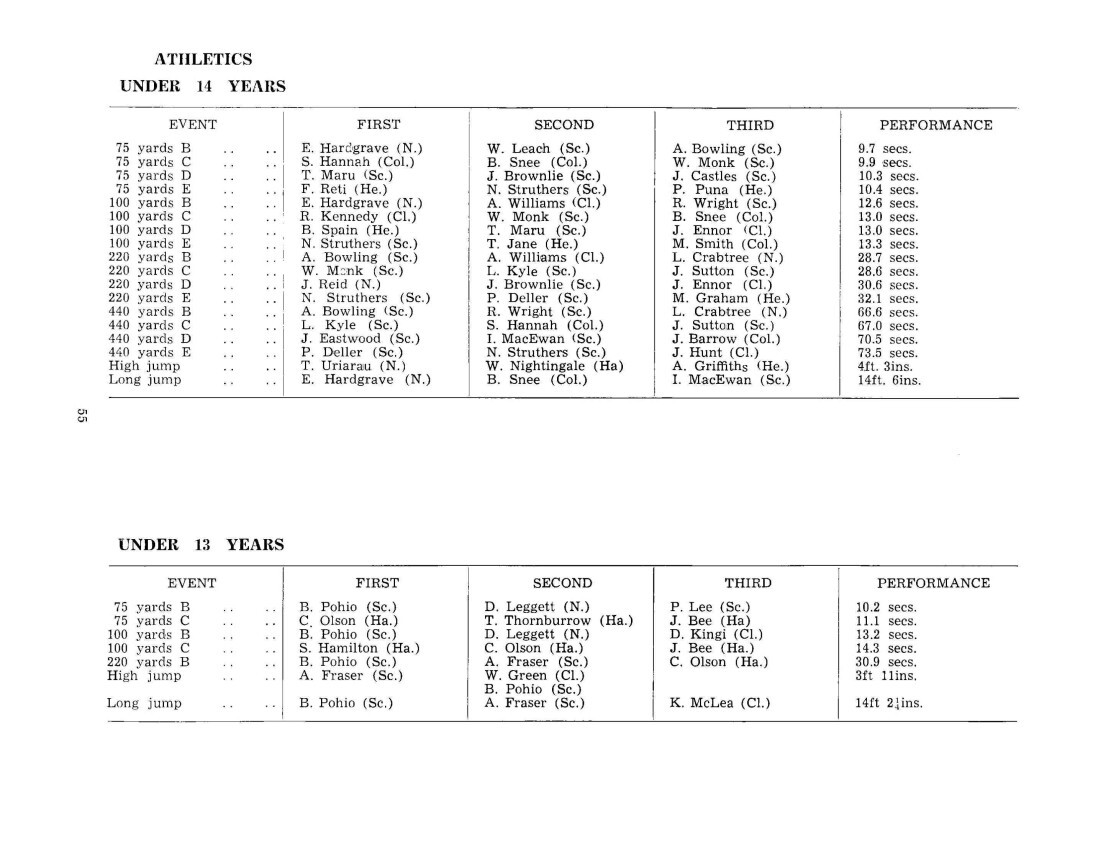
Page 56
BASKETBALL
Basketball has at last been recognised. This year basketball appears to have been at its greatest since its introduction a few years ago. Three players were awarded their colours; five represented the Napier colts and one was in the Hawke’s Bay men’s team. The A team won the men’s B grade basketball cup and all their inter-secondary school matches.
Messrs P. Knight and P. Ware have reason to be pleased with the efforts of our indoor basket-ballers.
Seven teams competed in the Napier Indoor Basketball Association competition each Monday night, three in the under 15 age group, three in the under 18 age group, and our A team in the men’s B grade.
The under 15 and 18 teams were unsuccessful in winning their grades but they filed minor placings which were a credit to them, as most players lacked experience and co-ordination. Fraser, Weaver and Glock can be commended for their vast improvement and competent playing throughout the season.
The A team on a Monday night consisted of Mr Knight (coach), P. Ware, C. Nicol, S. Kingi, R. Robertson, D. Hay, B. Marshall and J. Vivieaere (capt.). It was successful in winning the cup in the knockout competition.
With the fitness and speed of Robertson, the agility and goal dropping of Kingi, the N.B.H.S. team seemed destined to win against the eight competing men’s teams.
v. Gisborne B.H.S.
The school’s first official inter-secondary school basketball game was staged against the Gisborne Boys’ High School at Gisborne.
Applying good basketball tactics, our team maintained a good lead at half time.
N.B.H.S. 22, G.B.H.S. 12.
Weaver played a good game scoring first points. With innumerable fast breaks and accurate shooting by Kingi and Robertson, we were able to keep the lead, finishing with an over-whelming win: –
N.B.H.S. 54, G.B.H.S. 20.
Marshall and Hay played competently with Hay using his height to its fullest, scoring 11 points. Vivieaere was top scorer with 14 points scoring largely by lay-ups and set shots.
During the game Robertson was forced to retire due to an accident requiring hospital attention. The skill with which the team carried out a difficult method of attack particularly impressed onlookers. Kingi, Robertson and Vivieaere gained their colours, this being the first time colours have been issued to basketballers.
Players Kingi, Lum, Robertson, Tuck, Vivieaere and Weaver were selected for the Napier colts. They won the H.B.P.B. regional competition and went forward to the North Island champs.
J. Vivieaere gained selection in the H.B.P.B. Men’s A grade team to compete in the national championships, Palmerston North.
Basketball has indeed increased in popularity, success and recognition with over £120 spent on equipment and facilities. The basic essentials of this game have been shared, and basketball is played regularly at lunch hours and after school. With this initial interest it is hoped that more inter-secondary school matches will be arranged in the future.
Elder Child and Elder Dawes (Utah, U.S.A.) have been coming for two afternoons a week to coach the three Under-15 teams, and have been attending their games every Wednesday night. The success of their coaching has resulted in 100% improvements of the teams. We would like to thank them for their interest in our school teams this year.
J.E.V.
GYMNASTIC CLUB
Mr G. Simpson has taken 20-30 boys in the gymnasium every lunch hour through the whole year. There is over £200 worth of new equipment this year, and the boys have been making full use of it; trampoline, Swedish beams, and new floor mats. Mr Simpson says: “Because the boys have been practising every lunch hour, the school individual phys. ed. competition will be the hardest it has been for many years. It is getting to the stage where the boys could enter competition on a wider scale. If I had been here next year, I should certainly have taken the boys to Wellington. They are prepared to put in a lot of time, and are very promising.”
On the 14th August three school gymnastic teams entered the H.B. Festival of Sport in the Centennial Hall. The first team (G. Wiig, W. Eddy, J. Harris, G. Galgey) were placed first in the first J.E.V. grade. The second team (M. Wiig, Dick, May, Scarrott) were third in the grade. The third team was B. Wiig, Longney, Faulknor, Lemin. The emergency was Fenwick.
On the 20th July, a team of thirty gymnasts gave a display at a Parents’ League evening held in the Assembly Hall.
On behalf of the Gymnastic Club I would like to thank Mr Simpson for all the time and work and inspiration that he has given to us.
W.D.E.
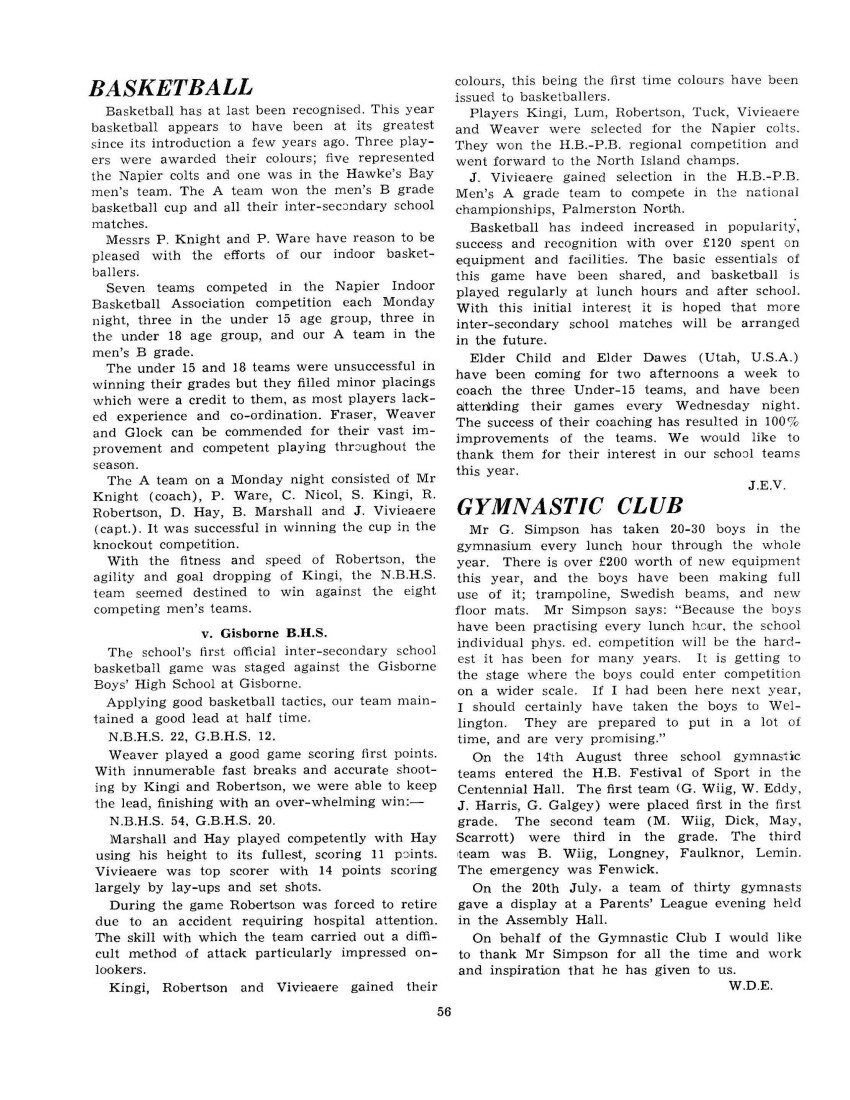
Page 57
INDOOR BASKETBALL ‘A’ TEAM
Back Row: Mr P. Knight (Coach), D. Hay, J. Vivieaere (Captain).
Seated: R. Robertson, S. Kingi, B. Marshall
FIRST HOCKEY ELEVEN
Back Row: Mr D. Revell (Coach), G. Ebbett, B. Snee, J. Scott, P. Dick, T. Hall.
Seated: J. May, T. Hyde, T. Bates (Captain), G. Dick, N. Foote, M. Cooper
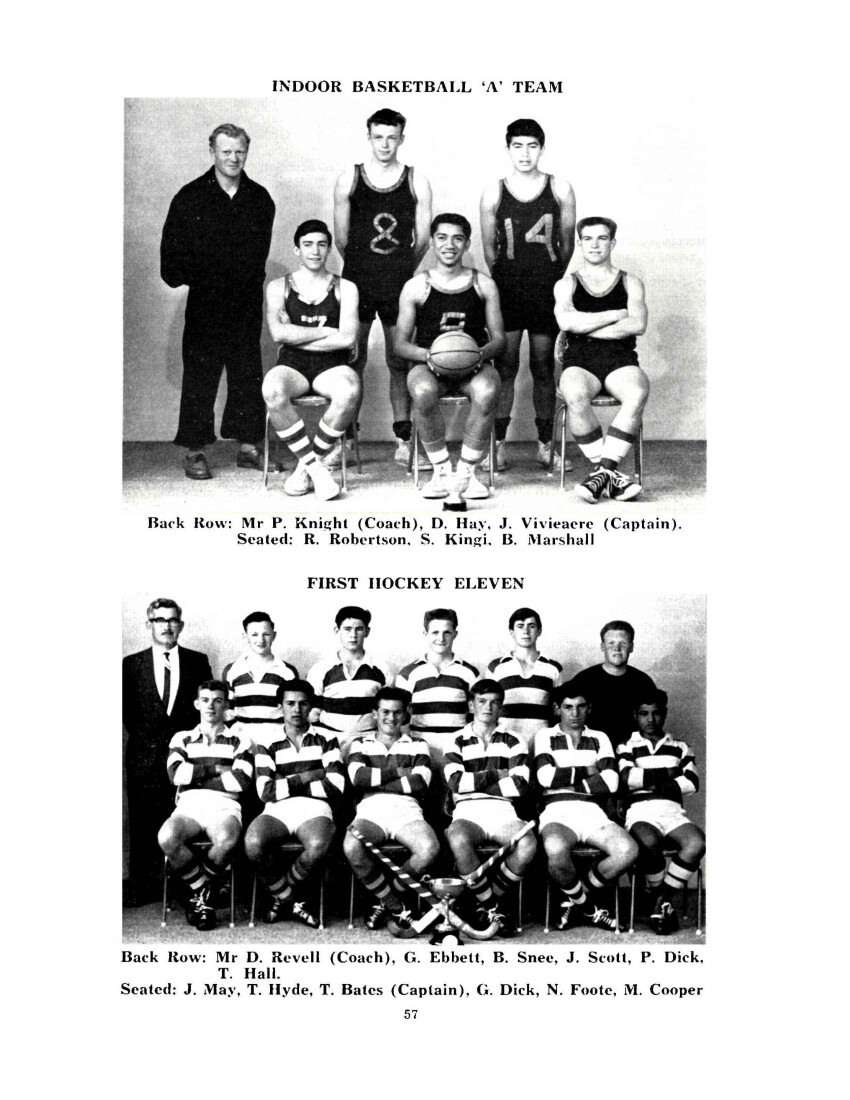
Page 58
HOCKEY
First Eleven
Members of last year’s first eleven who returned this year were N. Foote, J. Scott, G. Dick, T. Bates and W. Turner. These players were joined by T. Hall, B. Snee, T. Butler, T. Hyde, M. Cooper and G. Ebbett. J. May, R. Faulknor and P. Dick acted as reserves. The team improved greatly as it settled down to practise and obviously had a good chance of success as the Secondary Schools Tournament drew near.
Napier Secondary Schools Tournament
The first eleven was looking forward to the Secondary Schools Tournament held in Napier during the first week of the August holidays. The team was in the A section, and started with a win against King’s College. This was a big surprise of the tournament. In its section, the N.B.H.S. eleven played King’s College (won 3-2), New Plymouth (won 3-0), Mount Albert Grammar (won 1-0), and Waimea (lost 4-2). This placed the team first equal with two others in A section. A new draw had to be made, and Napier played Northland. The score was one-all at full time, but Napier lost in extra time by a hit over the back line. That put our eleven out of the tournament. Linwood eventually went on to win, by beating Northland in the final. J. Scott had the honour of being selected as reserve for the tournament team.
Inter-Town Competition
The school first eleven began the season playing in the second grade competition. After five wins it was put up into the senior men’s grade. Here it won eight games and lost five, finally coming third in the competition.
The two closing days were occupied with seven-a-side tournaments. On 12th September a team, not at full strength, played in the seven-a-side at Napier. The team lost to Colenso, to come second in the tournament. On the following Saturday a strong team consisting of Bates, Dick, Scott, Snee, Foote, Hall and Koller played in the Waipukurau tournament. The team got in the finals with Lindisfarne and the result was a draw at full time. Lindisfarne put the ball over the back line first during extended time. Thus the Napier seven lost the tournament for the first time in four years.
versus Shirley
The team was unsettled by the absence of G. Dick who was ill. His speed was very much missed on the right wing. Moreover, because of this lack of speed in the right of the forward line, the team did not really show its worth. The result was a draw 2-2, the scorers being M. Cooper and W. Turner.
versus Gisborne
This game was played at Gisborne on a firm ground. The first half was very close, ending with a lead of 1-0 to Gisborne, but the Napier players extended themselves in the second half. T. Hyde rose to the occasion with very good play. W. Turner and T. Bates both scored goals for Napier. The result of the match, therefore, was a win, Napier 2, Gisborne 1.
versus Wairarapa
This game on the school grounds at Wairarapa was very fast, and tired everybody by half-time. The weather was good but the goals were muddy. Napier was winning 2-1 when Wairarapa scored a goal just on full time. The Napier full-backs B. Snee and J. Scott played exceptionally well in breaking up the attacks by the Wairarapa forwards, who were constantly fed with the ball by their centre-half. The result was a draw 2-2. Our goals were scored by J. Scott (from a penalty corner) and T. Bates. versus Hastings
The Napier team was confident as it took the field at Napier, relying upon victories of other years. However, it was soon obvious that the match was going to be closely contested. The closing stages of the game were very tense, as N.B.H.S. fought to retrieve the situation. The main reason for our win was J. Scott’s extra good play. He came up from the back position and fed the ball up to the forwards. The final result was Napier 4, Hastings 2. G. Dick and T. Bates scored one goal each. W. Turner scored two.
Representative Honours
In the North Island Colts’ Tournament four players from this school were selected for the Eastern Zone Colts. These were T. Bates, T. Hall, J. Scott and W. Turner, although Turner did not go away with the team. T. Bates was the captain of the team, which won two games and lost three in Palmerston North.
The same four were again selected for the Hawke’s Bay team, which travelled to play at Palmerston North and Ruapehu.
Team Notes
In the goal T. Hall played magnificently throughout the season. In the tournament he was stopping the ball with his hand in the high corner of the goal and kicking it clear before it hit the ground. J. Scott was a mainstay of the team. He and B. Snee formed a pair of full-backs that the forwards could always rely on. T. Hyde, N. Foote and T. Butler, the halves of the team, made a good job of keeping up with their opposing forwards. G. Dick at right wing had a turn of speed that resulted in some magnificent goals. W. Turner played at inside right, which was not his preferred position,
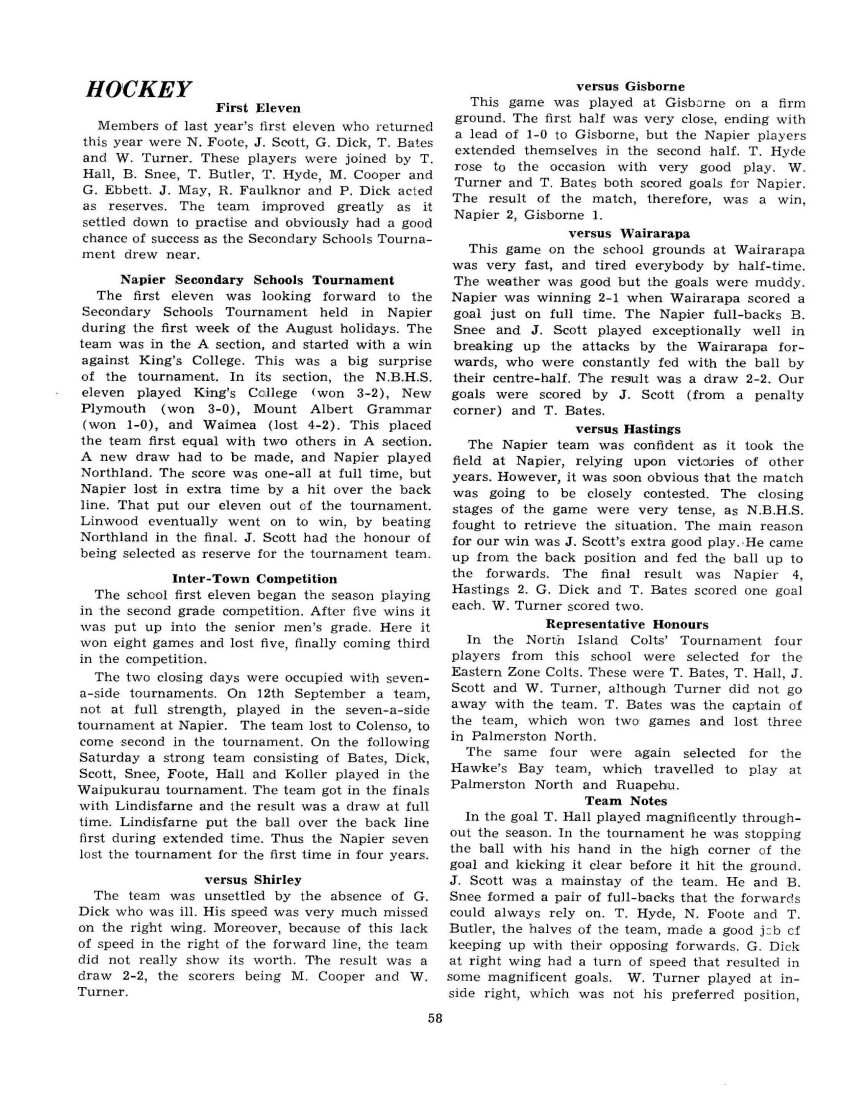
Page 59
but he had the necessary speed and was tireless in back tackling. T. Bates (captain) was a very capable centre forward and scored many brilliant goals. At inside left, M. Cooper proved himself this season, scoring good goals by following in and showing nimble stick work. G. Ebbett was a persistent player as left wing.
The visitors to the Secondary Schools Tournament were grateful for Mr D. G. Revell’s successful organisation of the tournament and the billeting arrangements. We would like to thank him, and all umpires who controlled our games during the season.
Second Eleven
The second hockey eleven played in the third grade competition and were moderately successful throughout the season. Under the capable coaching of Mr C. Nicol, everyone’s performance improved towards the end. He attended every possible practice and was a hard-working coach who expected hard work from the team.
There was a considerable turnover in the team members, with several reserves standing by. E. Robinson, G. Ebbett, P. Dick and R. Faulknor were playing for the first eleven at times during the season, and the first eleven sometimes contributed M. Cooper, J. May and T. Hyde to fill in our gaps. The team, apart from these, was: D. Christie, R. Bray, N. Campbell (forwards), K. Campbell, G. Nuttall (captain), W. Nash (halves); B. Fraser, E. Robinson (backs); W. Archibald (goal).
We were generally matched against the first elevens of other schools, and at first lost many of these games. The only inter-school fixture was against Central Hawke’s Bay, and we narrowly lost 3-1. On two subsequent occasions when we played against this team in the Saturday competition, we repaid our debt by winning both games.
G.K.N.
Third Eleven
The third hockey eleven, coached by Mr C. Matthews, played ten Saturday games, won seven, lost three, to come second in the competition, which includes Hastings teams also. It has been a successful year, and the team spirit has been high. The team was: R. Gattsche (captain), G. Barlow, I. Black, K. Eagle, R. Eagle, B. Ferguson, W. Rongo, E. Simmons, G. Strother and N. Thorp.
Fourth Eleven
In the fourth grade Napier competition this season there was a bye for the team in each round. The team played eight games, won six and lost two. Our practice times, with three teams trying to make up a game between two sides, have not been entirely satisfactroy [satisfactory] for coaching. Mr Webster has attended our games at Marewa Park and given us timely coaching on the spot. The team was: S. Bray (captain), L. Black, M. Bluck, L. Dixon, D. Doole, N. Hazlewood, J. Knight, R. McKenzie, A. Olsen, J. Spence, B. Worsnop.
Fifth Eleven
This year the fifth eleven was fortunate to have some exceptionally strong players, especially D. Riddell and T. Thessman. As a result, the games were fast and enjoyable. We played ten matches, won four and lost six. There were some promising third form players, and the beginners got a good season’s hockey. The team was D. Riddell (captain), A. Baines, P. Barham, D. Cooper, R. Corbishley, G. Hole, G. Kyle, R. Jeffares, S. Macdonald, K. McLea, T. Thessman, T. Wood and D. Youren. Coach, Mr R. Mundy.
COLOURS ANNOUNCED 1964
Cricket: T. Hall, B. Chrystal, L. Campbell, W. Turner, R. LeQuesne, J. de Denne, E. Castles, B. Snee, P. Exeter, W. Eddy.
Athletics: R. Nant, B. Baudinet, G. Wiig, M. Mear.
Hockey: T. Bates, W. Turner, T. Hall, J. Scott, B. Snee, T. Hyde, N. Foote, T. Butler, G. Ebbett, J. May, G. Dick, P. Dick, M. Cooper.
Debating: D. Kerr, G. Robinson, S. Nation.
Swimming: R. Bell.
Rugby: D. Kerr, G. Exeter, J. Exeter, I. Ware, A. Ware, P. Tuck, B. Harvey, J. Andrew, C. Brunton, L. Karatau, G. Robinson, J. Piper, B. Chrystal, M. Mear, R. Sherwood, L. Campbell, G. Kohlis, P. Carney, J. de Denne.
Shooting: L. Campbell, P. Tuck, R. Martel, H. Black, R. Malcolm, A. Wilson, J. Waterhouse. Prefects: G. Robinson, J. Piper, L. Campbell, P. Carney. R. Dallas, G. Dick, G. Ebbett, T. Hall, L. Karatau, D. Kerr, R. Malcolm, J. M. Piper, R. Sherwood.
Soccer: W. Sadler, J. Kay, B. Duncan, R. Roberts.
Indoor Basketball: J. Vivieaere, R. Robertson, S. Kingi.
Rowing: L. Karatau, R. Sherwood, D. Oliver, H. Trafford, S. Kingi, D. Munro, A. Sherwood, S. Alder, A. Castles.
Tennis: P. Carney, G. Scholes, B. Baudinet, D. Kerr, J. Scott, B. Manson, R. Bell.
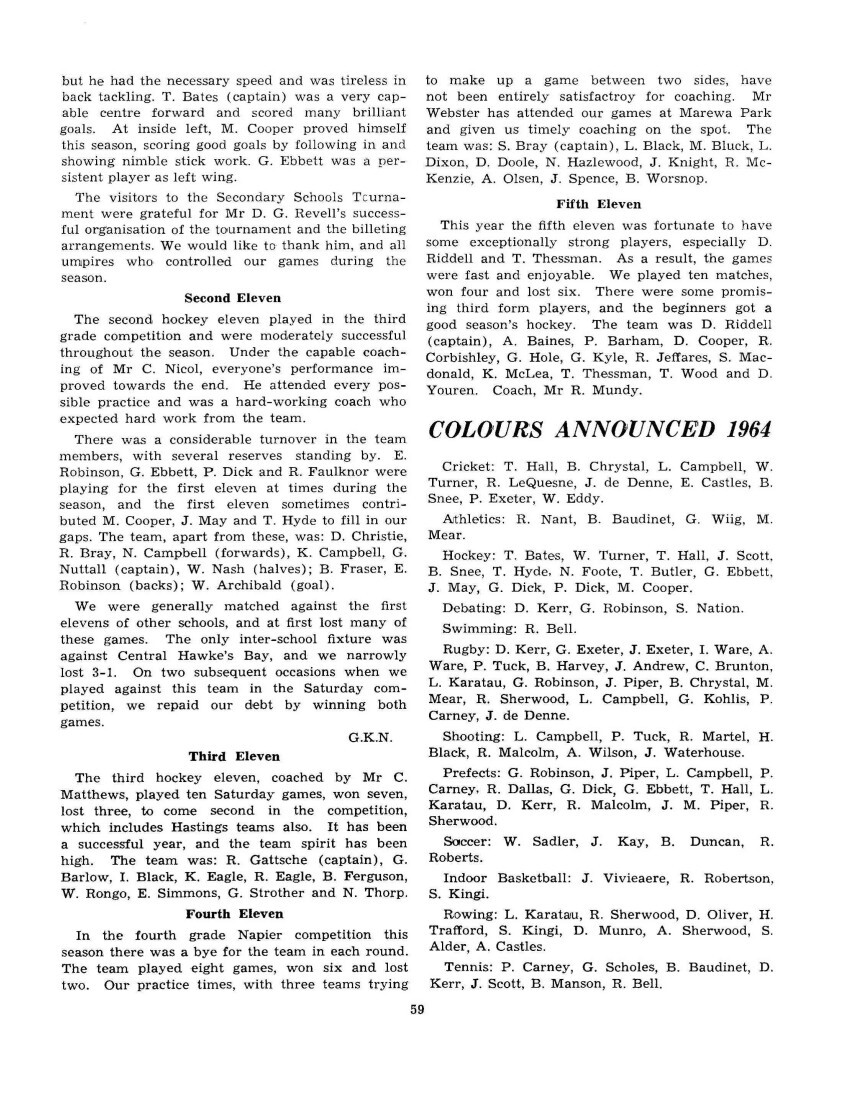
Page 60
ROWING
This year has been a full one for the rowing group which, in the first term, competed in regattas from Dunedin to Hamilton.
The first eight consisted of L. Karatau, R. Sherwood, D. Oliver, H. Trafford, S. Kingi, D. Munro, A. Sherwood, and S. Alder. Right from the 1st February they started gym training at 6 a.m. and rowing at Clive from Monday to Thursday after school, and on Saturday mornings. The crew tried to complete about nine miles each night and a total of fifty miles per week.
On the 8th of February we competed in our own Hawke’s Bay Rowing Club’s regatta. On that morning we completed ten miles training, and in the afternoon we raced in the Maiden Eights. We did not secure a place. A four (L. Karatau, R. Sherwood, D. Oliver and H. Trafford) raced in the youths’ fours and were swamped just short of the line.
After this regatta the second eight was selected. It was A. Godwin, G. Spence, I. Beattie, I. Gilray, R. Treseder, C. Sorensen, G. Warman and C. Walker. Our coach chose the two coxswains A. Castles and A. Maru.
For a week this sizeable squad trained intensively for the Wanganui championships, to be held on February 15th. At Wanganui two fours raced in the morning. Both were unplaced. At 4.30 that afternoon, the first eight raced in the ‘Schoolboys Eights’ and gained third position.
This season a school rowing team went down to Dunedin. The first eight and two reserves went by ferry and train with our coach, Mr Simpson, to compete in the N.Z. Championships at Lake Waihola, 26 miles south of Dunedin. Racing at Waihola on Saturday February 29th, the school eight gained fourth position. The placings were: Hutt Valley, West End (Auckland), Ngaruawahia, and N.B.H.S. The next morning the school raced in fours against Dunedin schoolboy crews in the harbour. The three-quarter mile race was won by our four. After this the crew did some training in a borrowed eight and used the new shovel oars.
On Sunday we left on the midnight express and travelled all night. When we reached Christchurch at 7 a.m., we were invited to Shirley Boys’ High School. The prefects entertained us to lunch and showed us around Christchurch. In the afternoon, we visited Kerrs Reach on the River Avon and the two halves of the team rowed in a Fours race.
Upon our return, both first and second eights carried on training for the Maadi Cup and the Thompson Memorial Shield, which was being defended by the second eight after the first eight’s victory last year.
On Thursday 26th March both crews travelled to Hamilton and trained for a day ready for the rowing on Easter Saturday. The racing was held on Lake Karapiro. In the Maadi Cup race at 2 p.m., the school finished fifth in a field of thirteen crews.
The places were: Wanganui Collegiate (which won in a time 10 seconds slower than the N.Z. training squad’s time for the same course), Tauranga, Kings College, and Fairfield College. The second eight competed in the Thompson Memorial Shield race and finished fifth.
With the completion of this regatta, the school’s competitive rowing is over, apart from two regattas in Wairoa in the third term.
Those who travelled away would like to thank the pupils of Fairfield College, King Edward Tech. and Shirley Boys’ High School for billeting us. We all enjoyed our stay.
The junior rowers were not able to row very much in the first term because there were almost eighty in the group. Rowing commenced for the juniors on February 13th with a training film; but most had to wait until an organised time-table was made out before they could begin regular rowing. At Wairoa it is hoped to have two third form fours, two fourth form fours, and four other crews competing in both regattas which are on the 5th and 12th of December.
The prospects for rowing next year are at the moment very doubtful, as Mr Simpson, our rowing-master and coach, is leaving us. Unless a master keen on rowing joins the staff next year, the group may have to disband, or a small group of seniors may be coached by a Hawke’s Bay Club member. We owe much to the H.B. Rowing Club and to its keen members for the use of their equipment and facilities. 1964 has been a most enjoyable year’s rowing. In looking back, we thank the parents who helped transport boys to regattas, and particularly Mr Simpson, our coach.
R.H.S.
SHOOTING
This year was another successful one for the shooting team. Our success was due mainly to our coach Mr Carpenter and Mr Lloyd who assisted Mr Carpenter. We would like to thank Messrs Carpenter and Lloyd for giving much of their time in coaching us. Unfortunately we have lost both Mr Brebner and Mr McKenzie as coaches but would like to thank them for the coaching they have done in previous years.
THE WILDE TROPHY
This is an annual shoot between Gisborne Boys’ High School and Napier Boys’ High School for the
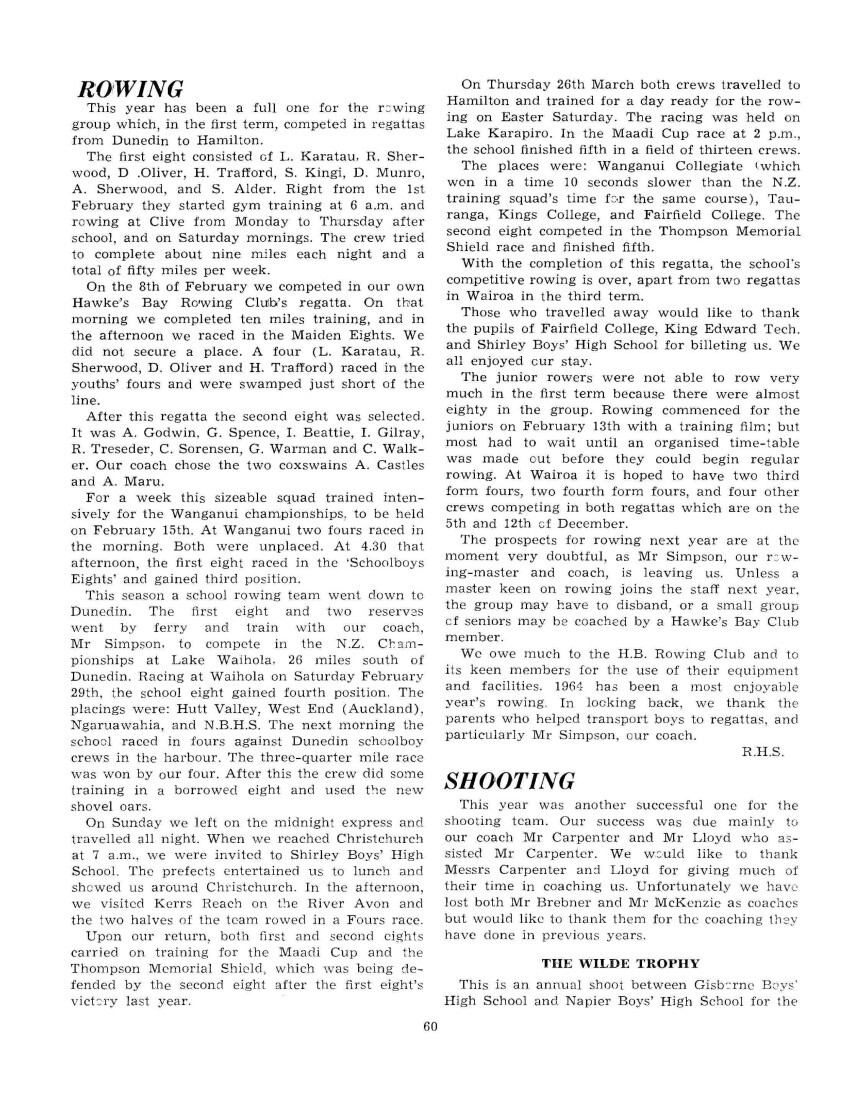
Page 61
SCHOOL ROWING TEAM
Back Row: D. Munro, H. Trafford, Mr G. Simpson (Coach), D. Oliver, S. Alder.
Seated: S. Kingi, L. Karatau, R. Sherwood, A. Sherwood.
In Front: A. Maru, A. Castles.
SCHOOL SHOOTING TEAM
Back Row: H. Black, A. Wilson, P. Tuck, J. Waterhouse, R. Malcolm (inset)
Seated: Mr W. T. Carpenter (Master in Charge), J. A. Piper, L. Campbell (Captain), R. Martel, Mr J. Lloyd (Coach).
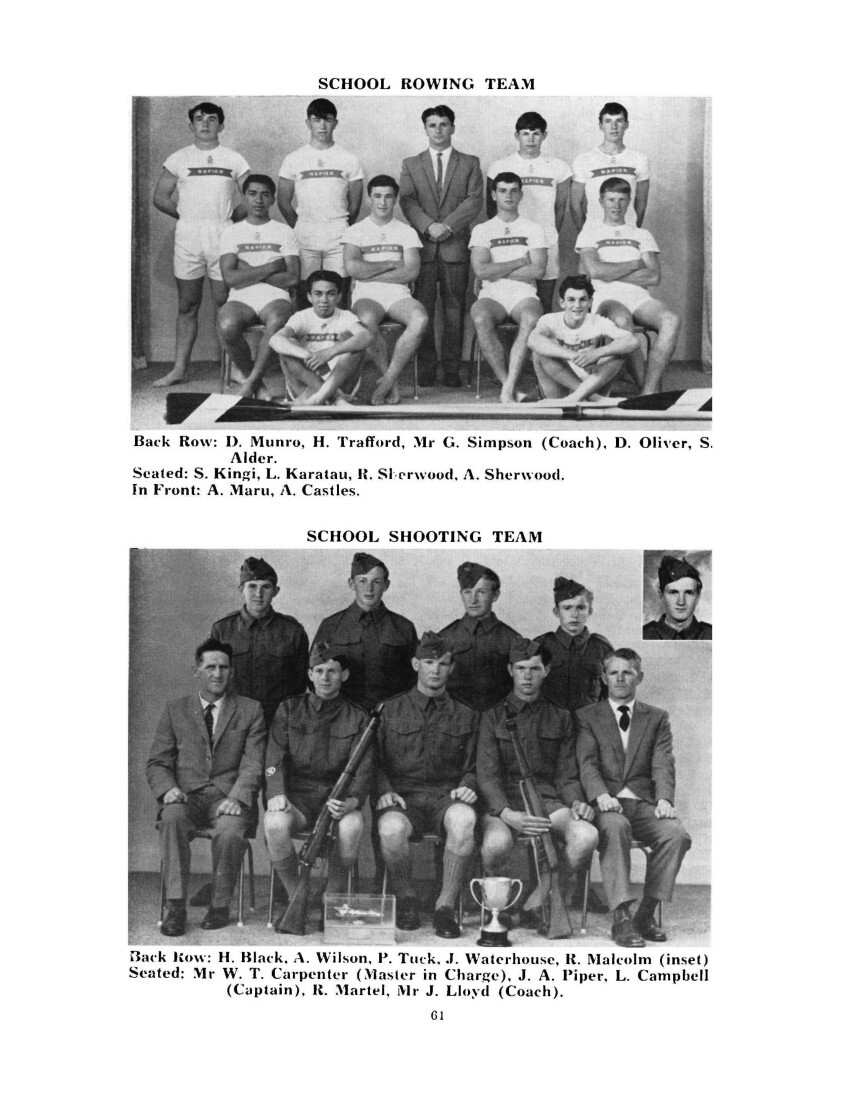
Page 62
Wilde Trophy. We retained it for the fourth year in succession with a record score of 1239 points against Gisborne’s 1105 points out of a possible 1400. The lowest score of each team was not counted.
Both L. Campbell and R. Martel equalled the range record with 192 out of a possible 200.
Scores were: –
Sgt. L. Campbell (Capt.) 192
Cdt. R. Martel 192
Sgt. T. Wilson 186
Sgt. P. Tuck 179
Sgt. R. Malcolm 169
Cdt. J. Waterhouse 166
Cpl. H. Black 155
Sgt. D. Kerr 142
COLEMAN SHIELD
We were runners up to Hastings in the Coleman shoot which was held at Roy’s Hill on 3 October in good conditions. Hastings scored 1235 to our 1197, our top scorer being T. Wilson with a very good 185.
Mr Lloyd was runner-up for the Officer’s Cup with 179.
Individual scores of the team were: –
Ap 200. Sn. 200 Rap. 200 Ap. 300 Rap. 300 Ttls
Sgt. T. Wilson 25 50 46 22 42 185
Cpl. H. Black 24 47 46 22 43 182
Sgt. R. Malcolm 24 46 46 20 41 177
Sgt. L. Campbell (Capt.) 25 50 46 22 29 172
Sgt. P. Tuck 23 46 47 21 34 171
Cdt. R. Martel 22 47 47 18 32 167
Cdt. J. Waterhouse 24 22 39 21 37 143
W.O.II J. Piper (Res) 21 38 41 21 35 156
INTERHOUSE SHOOT
1 Scinde 543
2 Heretaunga 507
3 Colenso 494
4 Hawke 487
5 Clyde 476
6 Napier 445
Winner of the Vigor Brown Belt for the highest individual score was L. Campbell with 114 out of a possible 125. Winners of the Lady Godley Cups for the highest individual score in each house.
L. Campbell (Hawke) 114
J. Waterhouse (Heretaunga) 111
R. Malcolm (Colenso) 108
H. Black (Clyde) 106
D. Little (Scinde) 106
K. Campbell (Napier) 84
CHAMPIONSHIPS
The senior championship is decided on the highest aggregate over the House shoot, Wilde Trophy and the Coleman Shield. With a possible of 525 the results were as follows:
L. Campbell 478
T. Wilson 469
The junior championship is awarded to the junior with the highest score in the Coleman Shield. T. Wilson shot 185 and is therefore 1964 junior champion.
L.J.M.C.
SOCCER
This year forty boys were catered for in Saturday soccer teams. Three teams were entered in the local competitions. The colours committee has recognized the improvement in the standard of soccer in the school this year by awarding colours to four members of the First Eleven: R. Roberts, W. Sadler, T. Kay and B. Duncan.
The First Eleven
The First Eleven consisted of T. Kay (captain), W. Sadler, B. Duncan, P. Young, B. Baudinet, R. Jackson, R. Porter, M. Wiig, G. Scholes, R. Steed, M. Bull, R. Roberts and R. Paterson. On occasions D. Gempton and R. Cowdell acted as emergencies. The team performed creditably to gain third place in its division 1 competition, winning nine of its competition games, and scoring 59 goals against 28. The patient coaching of Messrs C. Smith and I. Roberts produced results as the season advanced: The team was unbeaten in its last six matches. The top goal scorer for the First Eleven was M. Bull (30 goals). R. Roberts scored 19 goals, G. Scholes 7, M. Wiig 6, R. Paterson 5, R. Jackson 4, R. Steed 4.
Eight members of the First Eleven gained places in H.B. Representative teams. These were Roberts, Sadler, Kay and Duncan (H.B. under 18 XI); Roberts, Jackson, Scholes, Duncan, Bull and Wiig (H.B. under 16 XI). W. Sweeney, of the Second Eleven, was chosen for the H.B. under 14 XI.
In its inter-school matches, the team won two out of four encounters and scored 16 goals against 8.
v Shirley Boys’ High at Napier
Shirley took the lead almost immediately and scored two goals in the first half. Napier played most of the second spell with only ten men, but fought back splendidly. Shirley scored two more goals in the last ten minutes, to win 4-0.
v Gisborne at Gisborne
The Gisborne team plays in the Poverty Bay Senior Competition. This year our First Eleven earned the praise of a Gisborne sports columnist, who wrote: “The Napier team is now a force to be reckoned with.” Gisborne led 2-0 in the first half. In the second spell R. Roberts toiled hard for Napier, in the mid-field, initiating many of the team’s movements. Ten minutes before the end Gisborne obtained a third goal, with a high drive into the net. Final result: Gisborne 3, Napier 0.
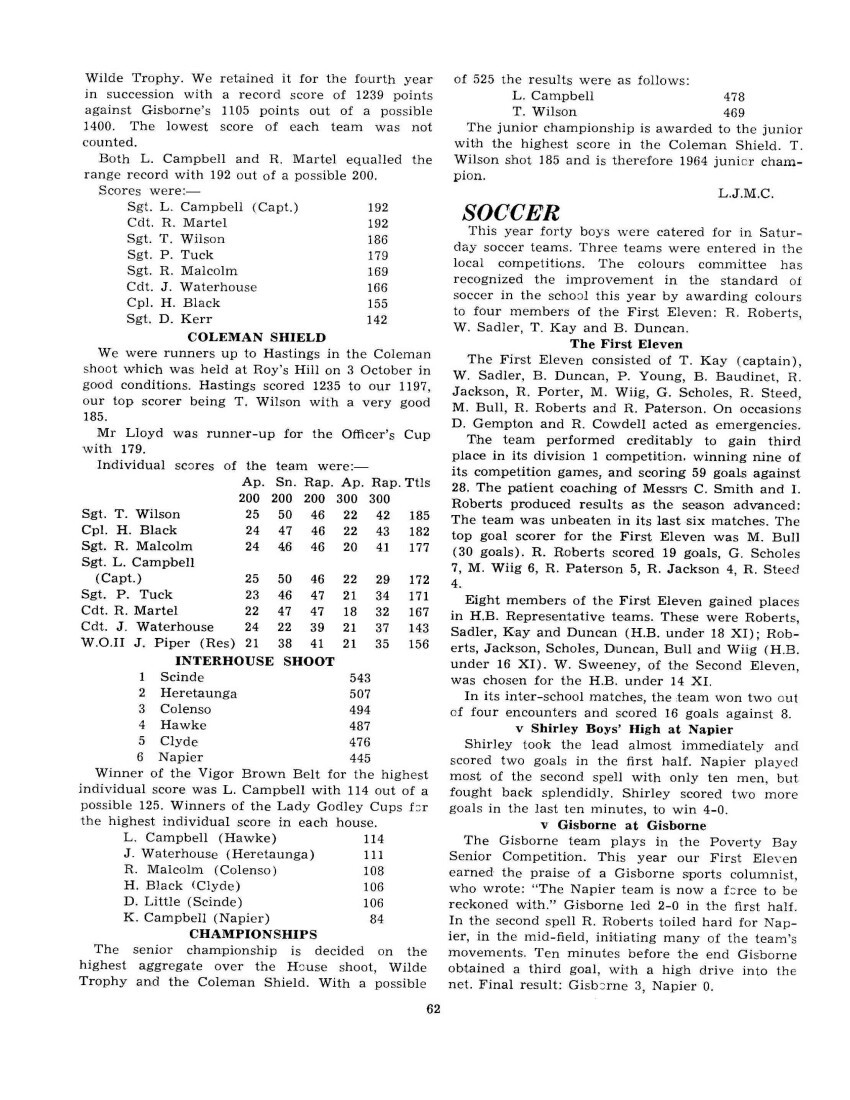
Page 63
FIRST SOCCER ELEVEN
Back Row: Mr I. Roberts (Coach), B. Duncan, W. Sadler, B. Baudinet, Mr C. Smith (Coach).
Middle Row: R. Porter, P. Young, R. Roberts, J. A. Kay (Captain), G. Scholes, M. Bull.
Front Row: R. Paterson, M. Wiig, R. Steed.
v C.H.B. College at Napier
Napier dominated this game comfortably. The team was able to retain as much possession of the ball as it wanted. The score was 4-0 at half-time, and 11-0 at the close of play.
v Hastings B.H.S. at Napier
The game was played on the annual field day under pleasant conditions. M. Bull got the first score for us, and Hastings fought back with determination, breaking up many Napier moves. Napier led 2-0 at half-time, having shown more penetration in the forwards. R. Roberts scored twice for us in the first fifteen minutes of the second spell. Our team co-operated very well in controlling the Hastings counter-attack. M. Bull added the fifth goal for Napier. Hastings scored its one goal five minutes from the end. It was through the cohesion of our team that we won 5-1.
v Masters’ Team
This game was played in the last week of the second term. Half-way through the second spell, the First Eleven was leading 5-1. A fighting comeback by the masters, however, took the final score to 5-4.
5-a-side soccer
There was a 5-a-side competition in the Centennial Hall on Monday nights during the first few months of this year. The First Eleven was represented by a team consisting of Roberts (captain). Sadler, Porter, Paterson, Duncan and Wiig. The team gained 6th place, competing in large part against senior teams.
Second Eleven
R. Shuker (captain), W. Sweeney, R. Cowdell, N. Moir, P. Rutter, R. Armour, M. Johnson, D. Gempton, S. Romans, R. Machin.
This year’s Second Eleven was the most successful for several seasons. It won the Division 2 competition. Out of fifteen games, the team recorded twelve wins, two draws, and one loss.
Third Eleven
N. Maclean (captain), B. Boyd, N. Sawyer, R. Reid, R. Scholes, R. Nobbs, A. Christie, G. Kemsley, S. Roberts, P. Stothart, C. Bayliss, J. Fulford. and M. Loader. The team, composed mainly of third formers, won the Division 4 competition, wining nine, drawing two, and losing one of its twelve games.
Our sincere thanks go to Messrs Smith and Roberts for their efforts in organising and coaching the teams. Special thanks also to parents who transported the boys to games and supported the teams during their matches. W.A S.
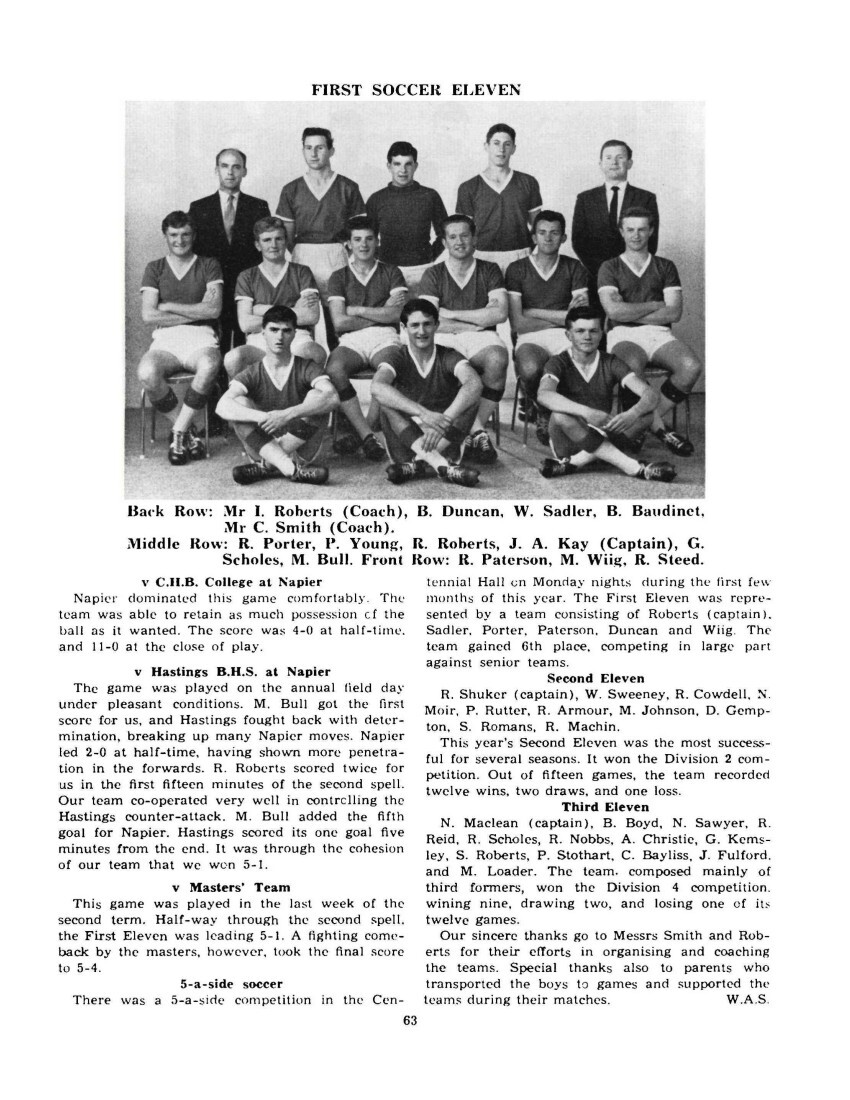
Page 64
SCHOOL TENNIS TEAM
Back Row: P. Carney, D. Kerr (Captain), G. Scholes, J. Scott.
Seated: R. Bell, Mr C. E. Shorter (Coach), B. Manson.
TENNIS
Once again tennis has been of a very high standard in the school this year. After much deliberation, a team was picked to travel to Gisborne to play Gisborne Boys’ High. Play was extended over two days. The school won sixteen out of the twenty-one matches played: nine out of twelve singles and seven out of nine doubles. We thus retained the Shuker Shield. The team was: D. Kerr (captain), J. Scott, B. Manson. R. Bell, P. Carney, G. Scholes.
Because of a late start, the school championships were not finished in the first term. They were completed in the third term after Labour weekend. B. Baudinet won the Senior Championship. B. Manson the Junior. J. Scott and B. Manson won the Doubles Championship. Several players are unable to play against Hastings this year, because of examinations and also because one is leaving school. However, I feel sure that the school team will acquit itself well against Hastings in its inter-school match, which is being held during the last week of school.
On behalf of tennis players in the school, I would like to thank Mr Shorter for the time he has put into the administration of tennis in this school during this year and the previous five years.
D.D.K.
SOFTBALL
About 200 boys have been playing softball in the Thursday afternoon sports period this year. Mr Briasco has arranged Junior and Senior House competitions. The Juniors were made up of the third formers, organised by Mr Flowers and Mr Brebner. The Senior competition is among fourth, fifth and sixth formers, organised by Mr Briasco, Mr Smart and Mr Pimm. The competition is in three rounds, and results should be available for next year’s “Scindian”. So far, Colenso and Clyde Houses, although small in numbers, have been playing enthusiastically and are coming out well.
G. M. Phillips contributes the following notes on Saturday softball: “In the 1963-64 season, the Team which entered in the Senior B competition played at Akina Park, Hastings, on most Saturdays. Although the team did not always win, some enjoyable games were played. The team was G. Phillips (Captain), A. Pohio, J. Andrews, K. Cameron, B. de Denne, L. Peterson, D. Goulding, W. August and H. Struthers.
“Some members of the team had left when the 1964-65 season began. Prospects did not look so bright until A. Ware, a South Islander, came to strengthen the team. After two games, the
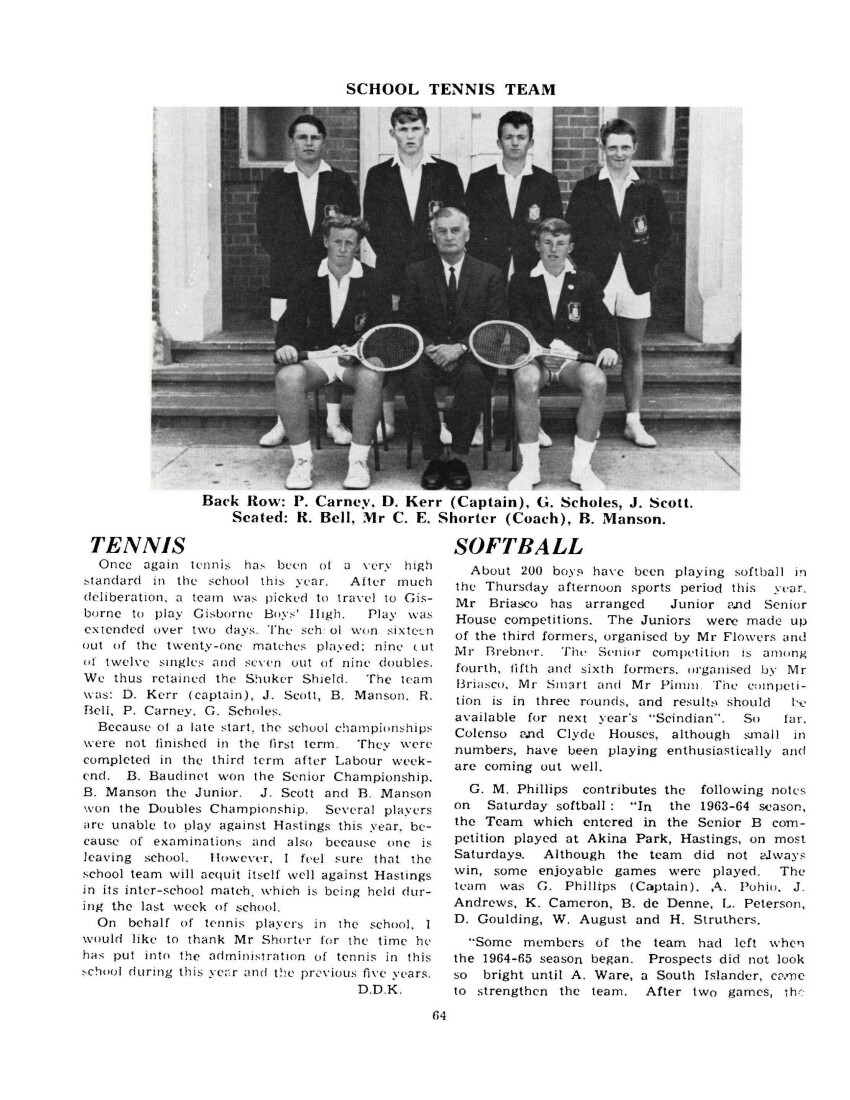
Page 65
team has had a 16-8 defeat and a 38-11 win. The team is now A. Ware (Captain), G. Phillips, A. Pohio, G. Field, W. August, B. de Denne, M. Simpson, M. Willis, A. Marsters, K. Cameron, D. Read.
“The school has provided us with five new gloves and six new bats. We would like to thank Mr Howlett, who coaches us in the Thursday sports period and is there to see us play on Saturdays.”
LIFE-SAVING
The life-saving group again reached astronomical proportions…on the first day. However, when most learned that life-saving does not mean just a dip in the baths on Thursday, numbers quickly dwindled. Life-saving means practice in personal time every day. When the baths are empty, it is land-drill or resuscitation theory. A group worked consistently for life-saving awards. Those who persevered and passed their life-saving exams were: –
Bronze Medallion (First award): S. Cook, L. Dixon, R. Farmer, N. Fenwick, S. Horton, D. Lane, P. McCallum, L. O’Brien, R. Pattison, S. Revell, N. Sawyer, I. Scarrott, R. Tuck.
Bronze Cross: S. Cook, R. Farmer, N. Sawyer
Silver Medallion (highest award): V. Bell, R. Farmer, B. Fraser, M. Howell, J. Vivieaere.
These awards include some from the third term of 1963.
From these and a few surf-club members, a team was formed to contest the Vigor Brown Shield, but Colenso proved too strong for us, and won for the third year in succession. It will strengthen our chances greatly if some championship swimmers support our competitive life-saving next year. We would thank Mr Tuck, Mr Crabb and Mr Harrison for their time and a considerable amount of patience.
M.J.H.
SWIMMING
Three records were broken this year: –
Preliminary Race Day
Intermediate one-length freestyle: D. Gempton (16.5 sec.).
Final Day
Intermediate two-lengths freestyle: D. Gempton (37.1 sec.).
Intermediate one-length butterfly: T. Bates (19.8 sec.)
D. Gempton, who won the Intermediate Championship for the second time, broke two of K. D. Anderson’s records (16.9 sec. and 38.2 sec.) which had stood since 1958. T. Bates bettered his own 1963 record of 22.3 sec. for the one-length intermediate butterfly stroke.
The preliminaries were held at the school baths on the morning of Tuesday, 18th February. The finals were held at the Municipal Baths on the morning of Thursday, 20th February. Among the guests with Mr Caird were Mr J. Edwards, M.P. (Board of Governors) and Mr F. Baudinet (Parents’ League).
The organisation of the events, co-ordinated by Mr Simpson, was of very high quality. A committee of Scinde House worked early and late to classify the entries. The heats were marshalled and started so swiftly that one heat had hardly finished before the next was in the water. Both mornings finished well within the predicted time. Between Tuesday and Thursday, Mr Simpson and his team produced and printed a nine-page programme listing all competitors in the finals events.
In the Senior Relay, Scinde and Hawke both had strong teams. A glance at the Senior Championship results might show that Hawke had the best promise; however, Scinde House won comfortably amidst terrific enthusiasm. Although Colenso were in the lead for house points after the preliminaries, Scinde House finally won the competition for house points. The results were: Scinde 327, Colenso 302, Napier 223, Clyde 211, Heretaunga 202, Hawke 190.
Swimming Champions: Senior, R. Bell (23 points); runner-up, J. Vivieaere (12 points). Intermediate, D. Gempton (20 points); runner-up, P. Robinson (14 points). Junior, R. Hellyer (13 points); runner- up, G. Galgey (10 points).
Swimming Team 1964
The team to represent us at the Inter-Secondary School Swimming Sports in Palmerston North on Saturday, 14th March, consisted of A. Christie and G. Fuller (under 15); D. Gempton, T. Bates, B. Baudinet (over 15).
Competition was very strong but all members performed creditably and two gained distinction. In the heats, Fuller and Gempton both won a first and a second placing. Gempton took part in the finals of the Senior 100 yards and 220 yards freestyle. Fuller was fifth in the final of the Junior 100 yards freestyle and third in the final of the Junior 50 years butterfly. Thanks to Mr Crabb who accompanied the team.
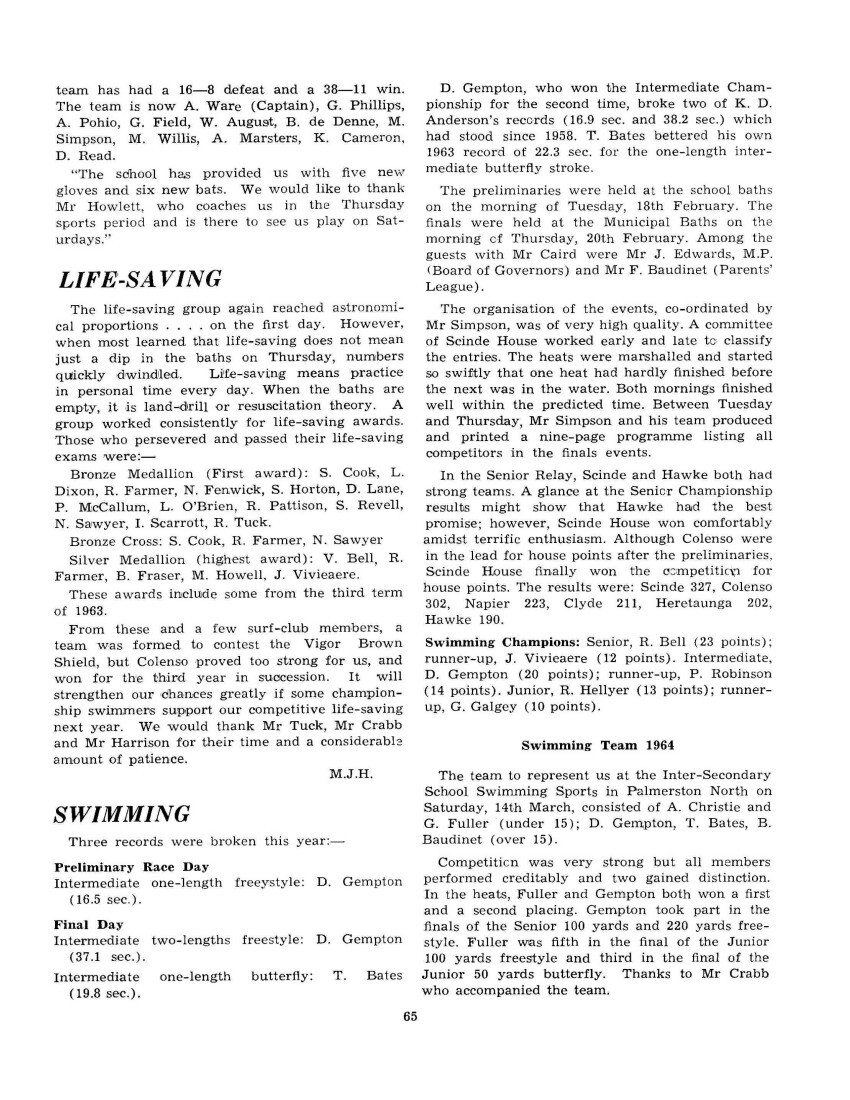
Page 66
SWIMMING
SENIOR CHAMPIONSHIP
EVENT FIRST THIRD PERFORMANCE
33 1-3 yards Freestyle R. Dallas (Cl.) R. Bell (Ha.) L. Karatau (Cl.) 18.2 secs.
66 2-3 yards Freestyle R. Bell (Ha.) R. Dallas (Cl.) G. Robinson (Sc.) 40.0 secs.
100 yards Freestyle R. Bell (Ha.) R. Douglas (N.) R. Lee (Col.) 66.0 secs.
220 yards Freestyle R. Bell (Ha.) R. Lee (Col.) V. Bell (Col.) 2 mins. 45.9 secs.
66 2-3 yards Breaststroke B. Baudinet (Ha.) J. Vivieaere (Ha.) J. Forsyth (He.) 53.0 secs.
33 1-3 yards Backstroke P. Tuck (Ha.) B. Fraser (Col.) J. Vivieaere (Col.) 21.4 secs.
33 1-3 yards Butterfly R. Bell (Ha.) J. Vivieaere (Col.) L. Karatau (Cl.) 21.4 secs.
Diving J. Vivieaere (Col.) G. Weaver (Cl.) L. Karatau (Cl.)
INTERMEDIATE CHAMPIONSHIP
EVENT FIRST SECOND THIRD PERFORMANCE
33 1-3 yards Freestyle D. Gempton (Col.) P. Robinson (Sc.) T. Bates (Cl.) 16.9 secs.
66 2-3 yards Freestyle D. Gempton (Col.) P. Robinson (Sc.) R. Harding (He.) 37.1 secs. (record)
100 yards Freestyle D. Gempton (Col.) P. Robinson (Sc.) R. Harding (He.) 62.7 secs.
220 yards Freestyle D. Gempton (Col.) R. Farmer (Sc.) T. Bates (Cl.) 2 mins. 39.2 secs.
33 1-3 yards Breaststroke P. Robinson (Sc.) R. Harding (He.) R. Farmer (Sc.) 25.5 secs.
33 1-3 yards Backstroke D. Gempton (Col.) R. Harding (He.) T. Bates (Cl.) 21.6 secs.
33 1-3 yards Butterfly T. Bates (Cl.) R. Harding (He.) 19.8 secs (record)
Diving B. Brown (Na.) I. Scarrott (He.) B. Marshall (Sc.)
JUNIOR CHAMPIONSHIP
EVENT FIRST SECOND THIRD PERFORMANCE
33 1-3 yards Freestyle G. Galgey (Col.) R. Hellyer (He.) C. Nolan (Ha.) 18.0 secs.
100 yards Freestyle R. Hellyer (He.) G. Hogg (Cl.) G. Mills (Sc.) 68.7 secs.
33 1-3 yards Breaststroke R. Hellyer (He.) G. Hogg (Cl.) I. Baudinet (Ha.) 25.7 secs.
33 1-3 yards Backstroke G. Galgey (Col.) W. Roydhouse (Cl.) G. Hogg (Cl.) 22.3 secs.
Diving G. Bulled (He.) J. Harvey (Sc.) S. Taylor (Col.)
OPEN EVENTS
EVENT FIRST SECOND THIRD PERFORMANCE
Junior relay Colenso Heretaunga Hawke 81.5 secs.
Intermediate relay Heretaunga Scinde Clyde 77.3 secs.
Senior relay Scinde A. Hawke Napier 74.2 secs.
440 yards freestyle Christie (Col.) D. Gempton (Col.) R. Bell (Ha.) 5 mins. 49 secs.
Long plunge R. Tuck (Ha.) S. Cook (Ha.) A. Wilson (He.)
SENIOR “B”
EVENT FIRST SECOND THIRD PERFORMANCE
33 1-3 yards freestyle K. Johnstone (Sc.) J. de Denne (Sc.) A. Godwin (Na.) 8.2 secs.
66 2-3 yards freestyle A. Godwin (Na.) J. de Denne (Sc.) M. Howell (He.) 42.8 secs.
100 yards freestyle A. Godwin (Na.) M. Howell (He.) R. Malcolm (Col.) 71.5 secs.
66 2-3 yards breaststroke M. Howell (He.) G. Weaver (Cl.) 59.0 secs.
33 1-3 yards backstroke J. de Denne (Sc.) M. Simpson (Sc.) G. Wiig (Col) 22.7 secs.
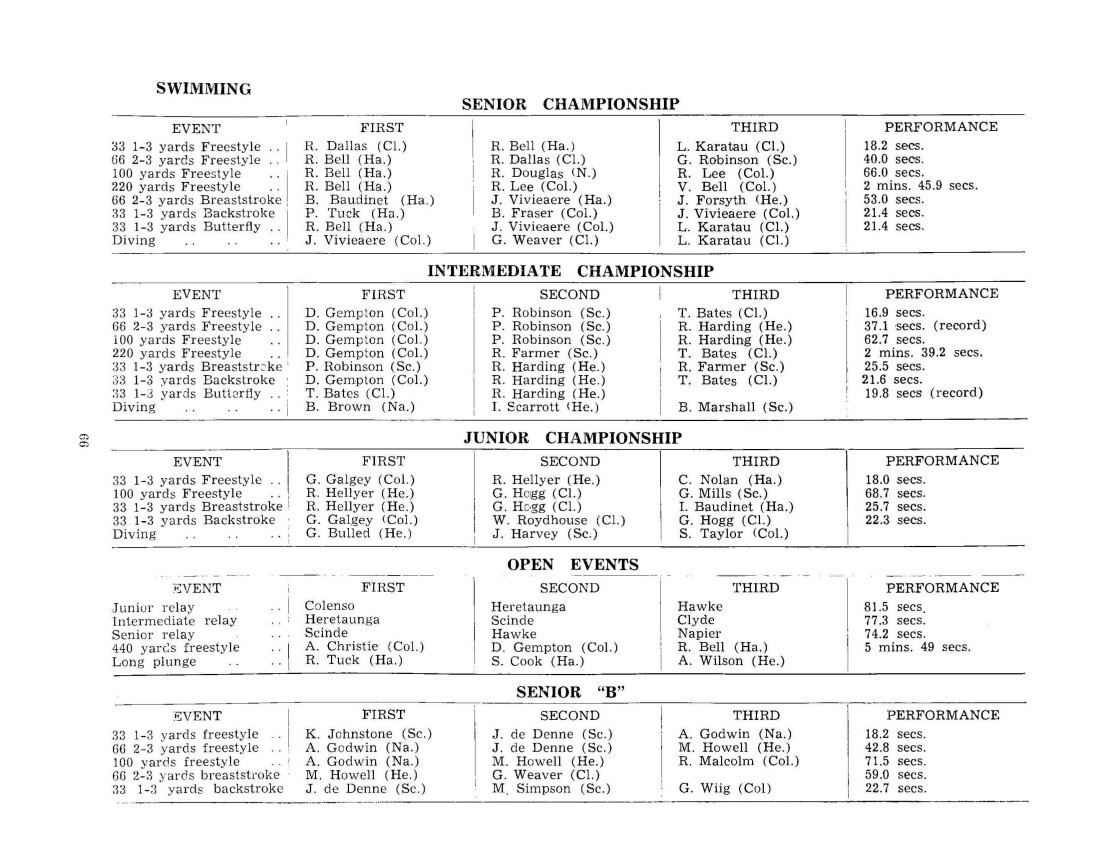
Page 67
SWIMMING
SENIOR “C”
EVENT FIRST SECOND THIRD PERFORMANCE
33 1-3 yards freestyle J. M. Piper (Col.) G. Mackay (Na.) K. Weston (Col.) 19.1 secs.
66 2-3 yards freestyle J. M. Piper (Col.) G. Mackay (Na.) K. Weston (Col.) 42.3 secs.
33 1-3 yards breaststroke J. Forsyth (He.) N. de Garis (Ha.) G. Dick (Sc.) 26.2 secs.
33 1-3 yards backstroke J. A. Piper (Col.) R. Bray (Sc.) R. Scott (Sc.) 23.0 secs.
INTERMEDIATE “B”
EVENT FIRST SECOND THIRD PERFORMANCE
33 1-3 yards freestyle R. Robertson (Na.) B. Brown (Na.) R. Turner (Cl.) 7 secs.
66 2-3 yards freestyle R. Turner (Cl.) J. Hawkins (He.) P. Tutt (Cl.) 1 secs.
100 yards freestyle B. Brown (Na.) L. Dixon (Cl.) R. Turner (Cl.) 2.6 secs.
388 1-3 yards breaststroke R. Donovan (Ha.) R. Pawluk (Col.) M. Gudgeon (He.) 8 secs.
33 1-3 yards backstroke R. Robertson (Na.) R. Turner (Cl.) W. Bell (Ha.) 1 secs.
INTERMEDIATE “C”
EVENT FIRST SECOND THIRD PERFORMANCE
33 1-3 yards freestyle M. Kenah (Na.) G. Bigg (Na.) A. Golds (Na.) 19.4 secs
66 2-3 yards freestyle M. Kenah (Na.) G. Veale (Col.) G. Bigg (Na.) 46.7 secs
33 1-3 yards breaststroke A. Yee (Ha.) G. Germain (Ha.) M. Kenah (Na.) 27.2 secs.
33 1-3 yards backstroke J. Ross (Sc.) M. Sawyer (Col.) J. White (Sc.) 25.3 secs.
JUNIOR “B”
EVENT FIRST SECOND THIRD PERFORMANCE
33 1-3 yards freestyle G. Mills (Sc.) L. Glock (Cl.) M. Loader (Na.) 18.7 secs.
66 2-3 yards freestyle G. Mills (Sc.) R. Jones (Na.) M. Loader (Na.) 41.1 secs.
100 yards freestyle L. Glock (Cl.) M. Loader (Na.) R. McKay (Na.) 70.8 secs.
33 1-3 yards breaststroke R. Jones (Na.) A. Boardman (Ha.) P. Hellyer (He.) 27.5 secs.
33 1-3 yards backstroke B. Wiig (Col.) J. Dumble (Ha.) L. Glock (Cl.) 25.0 secs.
JUNIOR “C”
EVENT FIRST SECOND THIRD PERFORMANCE
33 1-3 yards freestyle N. Fenwick (Col.) R. McLean (Ha.) B. Pohio (Sc.) 21.2 secs.
66 2-3 yards freestyle N. Struthers (Sc.) M. Bluck (Sc.) P. Pearse (Sc.) 63.0 secs.
33 1-3 yards breaststroke R. Wright (Sc.) P. Leslie (He.) G. Heaps (Col.) 33.1 secs.
33 1-3 yards backstroke W. Monk (Sc.) R. McLean (He.) N. Struthers (Sc.) 26.8 secs.
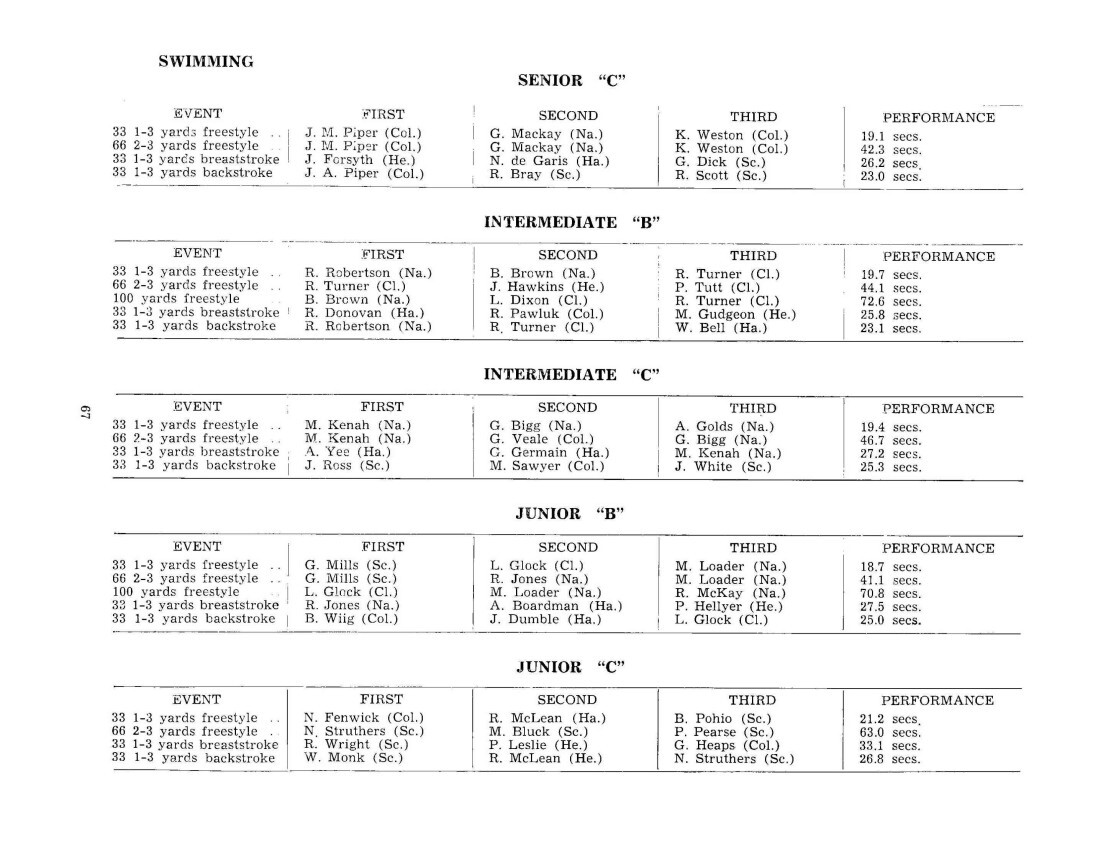
Page 68
OPEN COLUMN:
TO AN EMPTY QUAD
Dust,
Caught and tossed by the wind
Across an empty square,
To where
Flies cluster round the corpse
Of a sandwich, like conspirators
Around the corpse of Caesar.
The wind plays morosely
With a piece of paper,
Then darts down the echoing corridors,
Whistling as it goes.
A window glistens, broken, in the sun,
Cracked by an unseen missile
Launched from anonymous hands,
A rubbish tin rolls drunkenly,
Wind-blown on the concrete,
Unseen, unheard, uncared for.
R. T. Dallas, 6A.
Prize for Best Entry
WOULD YOU TRUST YOUR LIFE TO A SCHOOL BUS?
I couldn’t allow you to go through life without experiencing a journey on a school bus, so for your benefit I shall describe a typical school morning.
For some unknown reason the bus is always late. The only exception to this unofficial rule is when I happen to be late myself; then the bus is earlier than usual and I miss it. However, assuming that I have the fortune (or misfortune perhaps) to catch the bus, there is a fair chance that the inspector will be on it. There is also a fair chance he will want to see my pass. This being the case, I spend an enjoyable five minutes hunting through my pockets and between textbooks for this important little document. About this time, somebody points out, much to the inspector’s disgust, that I have been holding it in my hand for the last five minutes. I therefore commence without any more ado to explain how it came to be put in the washing machine and that it really is a bus pass.
Having got past this little formality, I hastily deposit myself in the nearest remaining seat, which unfortunately turns out to be the driver’s. Finally I see a seat at the rear, and I also see a formidable array of cases and satchels of various shapes and sizes to be passed. I finally deposit myself, thankful that I am transported to school in such comfort.
Did I say comfort? Not likely! First of all there is a window just in front of me. As it is a N.Z. Railways bus, the windows either won’t open or won’t close. This particular window won’t close and provides a convenient entrance for a steady stream of cold air. If I sit on the other half of the seat to avoid the cold, I have a steady drip of cold water on me, caused by the melting of the ice on the ventilator blades.
This brief note gives you an insight into the sufferings of a bus boy.
T. K. Davis, 5A.
A MAORI CAR
This is a short description of a Maori car.
We begin with the engine. The fan belt, in most cases, is half-torn or knotted and misses every so often. The engine is almost always missing on one piston, and maybe two. The carburettor, which is half choked with mud, silt and rust, is not much good. It is also minus a muffler.
Now the inside. The dashboard has the usual essentials. The key of the starter button has long since been lost, and instead a staple is used. The steering column is tied in by a piece of No. 8 wire. The essentials are found on the usually rotten floorboards. The accelerator is a bent piece of steel. A clutch and a brake (useless, of course) are just showing. The gearbox contains two gears, forward and reverse.
The seats are usually springless and have no stuffing. The front seat can easily and quickly be moved by opening the doors, clearing the seat, moving out countless flagons, and lifting the seat either forward or back. The seat will even move sideways, as, for example, when going round corners. The floor in the back is usually littered with old, mouldy fish and chip papers. The doors, which have to be slammed as hard as possible to be shut, are tied on with more pieces of good old No. 8.
Now for the undercarriage. This is composed of four grass-filled tyres. The wheels wobble about four inches each way. Everything else has been firmly pushed up under the floorboards, so as to be able to cross streams, creeks and any other obstacle which may occur in the course of its two-year lifetime.
There is a song about a Maori car which says, “Everybody sings in a Maori car’. They have got to drown the noise somehow!
R. Spackman and B. Pohio, 3A.

Page 69
PROGRESS OF OUR SCHOOL
This year an army of tradesmen assaulted the famous Napier Boys’ High School. The wood butchers attacked first at the rear of the wooden wing.
The first two buildings that were knocked up were a bit on the small and unstable side, and we were glad to find that they were not a new part of the school, but the smoko and tool sheds. From the top of the stairs and outside the Geography Room peered many pairs of critical, cynical, callous eyes of the 6B Beta Maths Class. They watched the four men on barrows never, never pausing for a snack, a spit, a smoke, a chat, or a major dispute over knock-off time.
This was not the only entertainment, however. The wooden wing shook like a frightened blanc mange as the lino layers lumbered in. These creatures took the place over, wielding hammers, rollers, tins of glue and deathly razor-knives. The orders of these malicious men were duly respected when they said that instruments often slipped if boys got too close or too cheeky.
The plumbing in Lab. D was pretty to watch. Like the carpenters, these workmen never had a second to spare. The chief plumbing apprentice. G. Ball, was an old boy of the school. When not talking Rugby, he had his time taken up with a cancer stick in one hand and James Bond in the other. But, alas, nobody in this department could even compete with the devastating results of the main attraction, the overall-clad paint paddlers.
These able-bodied trapeze artists could swing with the greatest of ease on a rope, desperately grasping for a grip on the windowsill of the top storey. But was it to paint or to cast their horror-stricken faces in the staff room window and see what the teachers were having for morning tea? This trio of turpentine tricksters was also very observant. From their precarious perches they surveyed the quadrangle and the countryside. Occasionally the odd brush of paint would find its mark, but usually it happened to drip accidentally on some unsuspecting body in the doorway below. The victim would stutter, “B-birds'” and look up to see the busy painter sunning himself, or tuning his paint-spotted transistor to “Memphis” or “Love Me. Do.”
As this year heralds a new era, we should be able to look forward to the next enthralling chapter of progress at our school in the next “Scindian.”
G. Exeter, 6B.
LOVE-LYRIC BY MR HONDA TO MISS SUZUKI
“My love for you, Suzuki. is far beyond compare:
I’ve proved how much love you, as far as I can dare.
I love your soft blue leather seat, the chrome plate on your steel,
Your engine-block and cooling fins. You can’t know how I feel.
“Oh, how I love the week-end when our riders ride for joy
Across the plains together, and we’re side by side. oh boy!
My heart skips revs, my oil runs hot, but I really can’t complain.
I feel you in my spark-plugs, but these things I can’t explain.”
Suzuki signed a mournful sigh, and answered him all sad:
“Your love is like a headlight gaze which nearly drives me mad.
The trouble is I fell for you the first time we touched spokes.
I love you, Mr Honda, but I dread to tell my folks.
“To marry out of family ways would turn their tail-lights red;
A Suzuki is a Suzuki, and must not inter-wed.
I can’t go on, my love for you grows stronger every day,
And I’ll marry you regardless of what the family say.”
R. L. KING, 6B.
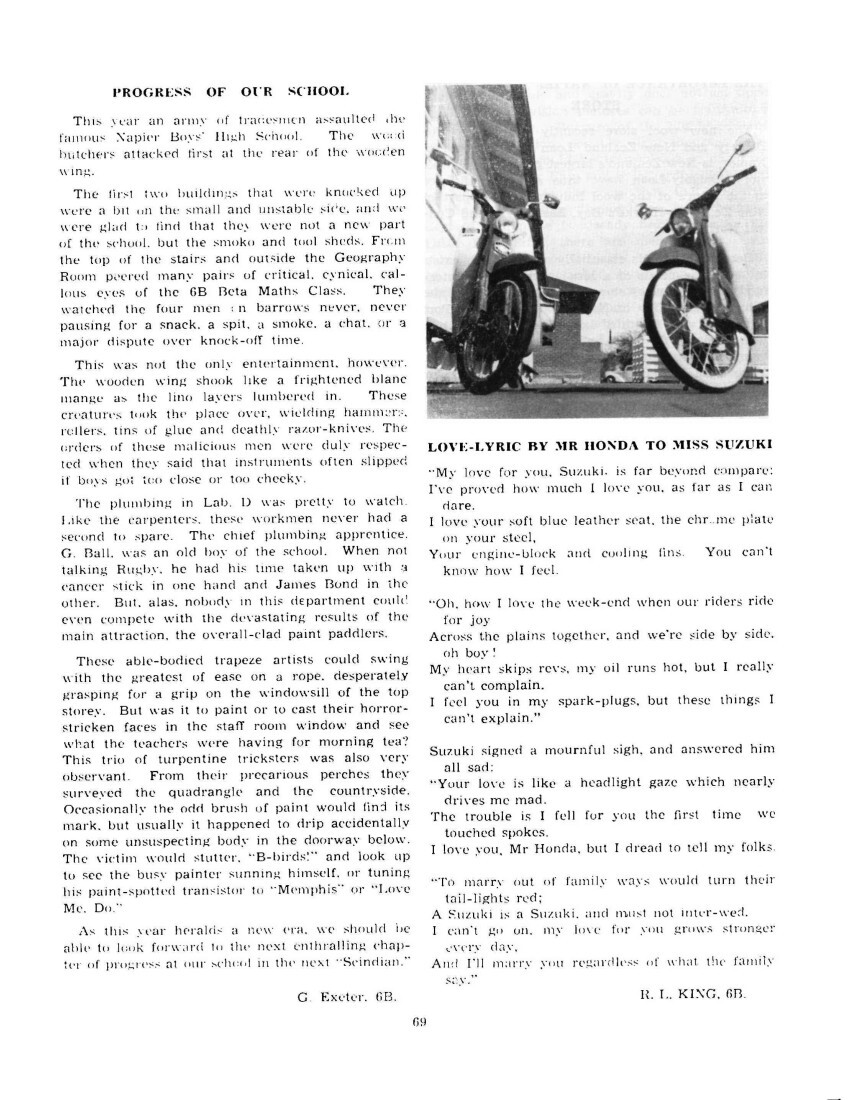
Page 70
THE IMPORTANCE OF NAPIER’S NEW WOOL STORE
The new wool store recently completed for Dalgety and New Zealand Loan Ltd. at Ahuriri, Napier, is New Zealand’s largest ground-level wool store. Dalgety-Loan have thus shown confidence in the future of the wool industry in this part of New Zealand—Hawke’s Bay, East Coast, and Central North Island.
Because Napier is essentially a city which exists to serve the needs of a large agricultural hinterland, the new wool store is of importance in the future of the City of Napier. In 1963 the Port of Napier was the third largest exporting port in New Zealand. Through it, wool, meat, timber and many other products are sent all over the world. More wool is exported from the Port of Napier than any other single product, and practically all of this wool passes through the Napier wool stores. Napier’s new wool store provides increased and improved facilities for the handling and storage of this wool. It is also able to cope with far greater amounts of wool, being capable of handling up to seventy thousand bales of wool in a season. Our city and port will benefit because the new Napier store can offer farmers modern and attractive facilities for the export of their wool.
The new wool store is one of a chain of several ground level stores built for Dalgety-Loan. This huge investment must obviously be very important to the commercial future of the company. The Napier store has cost them approximately four hundred thousand pounds to build. The part played by this seven-and-a-half acre store in the future of the wool industry in this part of the country will be no minor one. The store is equipped with very modern bale-handling equipment and many other up-to-date facilities for dealing with the wool in the store. Thus Dalgety-Loan have made an important investment in the future of the wool industry in this part of New Zealand.
To the farmer and to the buyer of wool the new store is also very important. It provides the farmer with efficient handling of his wool, the wool being presented to the buyer under the best possible conditions of space and light. Farmers and buyers are already gathering in the new wool store to see the wool handled in the most modern way possible.
D. D. KERR, 6A,
(Winner of the Dalgety-Loan Prize.)
DUCK SHOOTING
Every May, over fifty thousand New Zealanders get the enjoyment of hearing ducks as they drone down out of the sky like tiny jet planes. Many people think that duck-shooting is a cruel sport, but this is not so. The duck has just as much chance of not being shot as the hunter has of getting it. In New Zealand we are only allowed to use two-shot shot-guns, not rifles as some people think. Most people use decoys and duck callers, which are used to attract the ducks, as flies are used to attract trout.
At the Junior Wildlife meetings they talk about duck-shooting being a cruel sport, but at the Wildlife Exhibition they show more cruelty than could ever be shown by a good, clean shot out duck-shooting. At the Wildlife Exhibition three rabbits were killed, also a possum, because it had climbed up a post and wouldn’t come down. The Department of Agriculture killed the three rabbits because it is against the law to keep them. The Junior Wildlife wardens should have known this.
M. EATON, 3A.
To myself and many other people duck-shooting is just mass murder. Duck-shooters try to cover it up by calling it a sport, but a sport is a game or a match in which two teams or contestants have an equal chance of beating one another. A duck-shooter shoots everything up until he runs out of ammunition and then comes home a hero with a bag of half a dozen ducks. Duck-shooters build a ridiculous hut in the middle of a lake and then start mucking around with toy ducks which they float on the water. If this doesn’t bring the ducks along, they sit up to their waist in water and blow on whistles.
“Cruel habits start young,” must be one of the mottoes of the Juvenile Duck-shooters’ Association. It is amazing how many poor little children have been brain-washed and are taking up professional killing. There is one little killer I know who had a whole deep-freeze full of duck carcases after the shooting season, He himself reckons that duck-shooting is not cruel. I say, “Stop this unrestricted murder!”
D. J. LEGGETT, 3A.
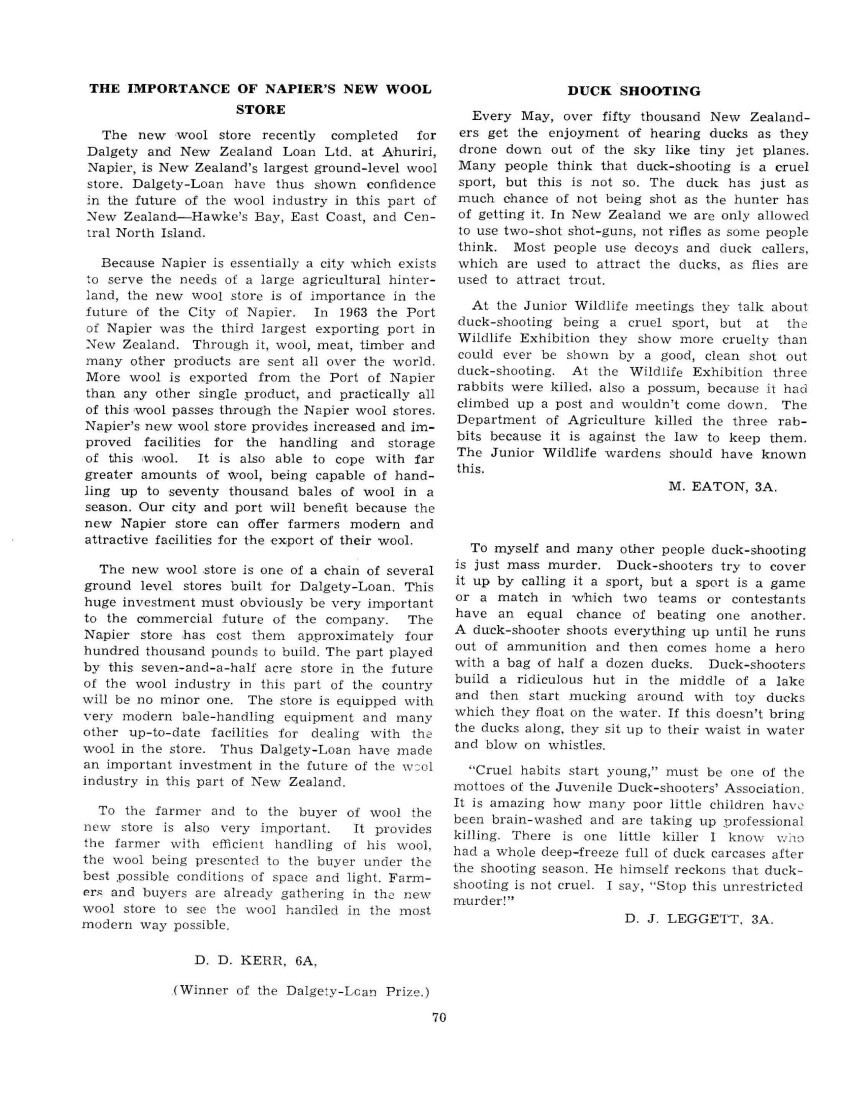
Page 71
THE WILD LIFE OF A JUNIOR WARDEN
“Low tide’s at four,” said Reg. to the band.
“Be at my place to give me a hand.
“We leave at three-thirty, so be on the dot,
“Cause if we don’t make it, we’ll be in a spot.”
Outward from Clifton, an hour and a half,
Sore from your head right down to your calf.
Start up a fire, for it’s more sav’s for tea.
Who’s first on dishes? Reg, Ross and me.
Pick out your bunks and be in them at nine,
By six the next morning, sleeping bags on the line.
Walk down to Black Reef, looking for wood,
Don’t bring back much, even if we could.
Saturday night, Commando’s the game:
Some mug goes out, and comes back half lame,
Covered in prickles, Hell, what a mess!
Still, he’s alive, and that was the test.
Sunday arrives, up with the sun,
Leaving at twelve, unless you can run.
Arrive back in Napier about half past three.
Grab up your gear and off home for tea.
D. Ramsay, 5B.
THE LASER RAY
Men have long used the wonder of light. The heliograph was used to communicate with light by dots and dashes. The Laser Ray is a beam of highly concentrated light. It was discovered in 1954 by Professor Townes while he was doing micro-wave research. To be scientifically precise, it means Light Amplification by Stimulated Emission of Radiation.
The atoms within a needle-shaped ruby crystal can be excited by a flash bulb. The ray, when it is released, will produce parallel rays several million times the intensity of the light that originally stimulated it. It has been estimated that the ray has a hundred million times the power of the light released by one square metre of the sun’s surface. The light lies within a very narrow range of wave length and produces a great heating effect. It would vaporize a human body, passing through it, and leaving ash behind.
The proposed uses of the Laser Ray are very many. First, it can be used to transmit power, although the reason for this is not fully understood even by Professor Townes. Power transmission in space by the Laser Ray could be the answer to the power needs of space craft, which obviously cannot trail wires behind them. Second, it can be used as an anti-missile weapon. For this purpose it is much easier than a bullet since its mass is negligible and gravity does not act upon it. Third, television pictures can be transmitted on a Laser Ray. Because of the highly concentrated transmission, possibly eight thousand television channels could be transmitted at one time on a single Laser Ray; and it is hardly likely that we should wish to use more than that. Fourth, welding and cutting diamonds at ten thousand degrees centigrade is already being done by the Laser Ray. Fifth, there are medical uses. An atomic explosion particularly damages the retina of the eye. A detached retina can be welded back on by scar tissue produced by the Laser Ray bombarded through the pupil of the eye. Sixth, for pure research, radio astronomy has vast possibilities from using the Laser Ray.
But this is another double-edged weapon. We are confronted wit the same problem as occurred with atomic fission: whether it will be used for peace or for war. The Laser Ray must be developed for its important uses; but it is timely to warn that human beings can use it to eliminate one another. Four hundred companies in the U.S.. alone are doing research on the military uses of the laser ray. it is again more and more important that scientists should have international control over research, so that the laser ray could not be used to make a death-ray, which is the primary object of researchers today.
J. A. PIPER, 6A.
HALF-TIME PEP-TALK
“Well, boys, you almost had them during the first half.” (Score: 30-0 to the opposition.)
‘That break-through of Brown’s was very good, but it is a pity he broke his leg. I must admit their backs are perhaps slightly faster and the the forward pack slightly heavier than ours. How does your head feel now, Smith? That was an excellent uppercut you caught, I’ll have a word to their coach about that.
“Now, Johnson, you change places with Stevenson, and play as half-back for this half. You weigh eight stone, half a stone heavier than Stevenson. Their half-back may not try to break your neck the same as Stevenson’s. By the way, I believe he weighs nine stone. What’s that, White? Yes, I bet he does feel as if he weighs nine stone, too! But don’t be disheartened.
“Front-row-prop, if that boy uses his fists again, hit him back! Okay! there goes the whistle! Greg! stop shaking like a leaf, and put the orange peel IN the bag, not AT it! I believe you can beat them, boys, so get stuck in.”
L. DUNCAN, 3A.

Page 72
WAS IT ALL RUGBY?
As Herb led his eleven Old Rottinghamians on to the field, the spectators realised this display of strength would be too much for the nine gallant lads of the St Cuthbert’s 4th XV. Herb lined up his star-studded team to give the customary “three cheers” but St Cuth’s – dirty dogs that they were – took advantage of the situation and kicked off.
To say that the Old Rottinghamians were taken by surprise would be the understatement of the century – they were flabbergasted. The ball, in fact, landed in the arms of one of the charging St Cuth’s forwards and a try seemed imminent. However, at a verbal warning from the Old Rotts’ hooker, Feet Samuels, the St Cuthbert’s player panicked completely and passed the ball two yards forward to his captain who, in turn, knocked the ball on, stepped into touch, evaded a flying tackle by an ardent Old Rotts’ supporter, and hurled himself over the line. The referee, who realised the game had begun, puffed up and awarded a try.
At half-time the teams gathered into two groups and the bottles were brought on. Herb realised his men were downhearted so, with the help of the coach and manager he rose to his feet to deliver a talk to inspire his men.
“Look here, Old Rotts, let’s give it to them this half. Thirty-six-nil isn’t hopeless. Let’s give it to them good and hard, chaps!” he yelled, bringing his right fist to his palm with such frightening velocity that his entire left arm remained paralysed for the rest of the game.
Twenty minutes later the referee blew his whistle for the game to resume and in five minutes both teams ambled back on to the field. Herb marched up to the half-way line with a look of grim determination on his face. He kicked off. The St Cuthbert’s team continued on their scoring spree and, although Old Rotts valiantly tried to stem the onslaught with brilliant defensive moves, the score mounted. Even when Herb kicked the ball into an adjoining paddock, the St Cuth’s men ignored the cunningly erected sign warning against radio-active fallout and retrieved the ball.
The few scoring chances that the Old Rottinghamians had were effectively dealt with by the injured St Cuth’s captain who, unable to stand, had patrolled the twenty-five yard line on his hands and knees, tripping anyone who was likely to score. Herb and his men had, of course, protested to the referee against this behaviour, but the referee said he could not remember anything in the rules to prevent the St Cuth’s captain from continuing his action. The game was ended, however, when the previously bribed park keeper told the referee he would have to stop the game as he had to close the park.
After lukewarm showers, the two teams met for an “after-match function”, where Herb raised a laugh by congratulating St Cuthbert’s on their fifty-four to nil win, and handed them the Eliza- down Bottington-Smith Cup, saying that the Old Rottinghamians could not win All the trophies.
J. M. C, Piper, 6B.
We wish to thank the following schools for copies of their magazines: –
Arana Hall, Dunedin; Ashburton High School, Ashburton; Auckland Grammar School, Auckland; High School, Christchurch; Central Hawke’s Bay, Waipukurau; Christchurch Boys’ High School, Christchurch; Christ’s College, Christchurch; Colenso High School, Napier; Dannevirke High School, Dannevirke; Epsom Girls’ Grammar School, Auckland; Gisborne Boys’ High School, Gisborne; Hastings Boys’ High School, Hastings; Hastings Girls’ High School, Hastings; Hobart High School, Tasmania; Horowhenua College, Levin; Iona College, Havelock North; Jeppe High School, Johannesburg; Kamo High School, Kamo; Karamu High School, Hastings; Kuranui College, Greytown; Loretto School, Scotland; Marlborough College, Blenheim; Matamata College, Matamata; Melbourne Church of England Grammar School, Melbourne; Melville College, Scotland; Mount Albert Grammar School, Auckland; Mount Roskill Grammar School, Auckland; Naenae College, Lower Hutt; Napier Girls’ High School, Napier; New Plymouth Boys’ High School, New Plymouth; Palmerston North Boys’ High School, Palmerston North; Papakura High School, Auckland; Queen’s College, Hong Kong; Robert Gordon’s College, Aberdeen; Rotorua High School, Rotorua; Sacred Heart College, Auckland; Saint Andrew’s College, Christchurch; Saint Patrick’s College, Silverstream; Scotch College, Melbourne; Scots College, Wellington; Southland Boys’ High School, Invercargill; Tararua College, Pahiatua; Taumarunui High School, Taumarunui; Tauranga Boys’ College, Tauranga; Te Awamutu College, Te Awamutu; Timaru Boys’ High School, Timaru; Wairarapa College, Masterton; Wairoa College, Wairoa; Waitaki Boys’ High School, Oamaru; Wanganui Technical College, Wanganui; Wellington College, Wellington; Whangarei Boys’ High School, Whangarei.

Page 73
LETTERS TO THE EDITOR
Dear Sir, –
After five years of the frustrations of Secondary School, I am looking forward to the relative freedom of University next year. My main criticism is that not enough time in a school day is spent actually working. At Sixth Form level this leaves too much work to be done at home. It seems ridiculous to waste time during the day at school and have to work till late at night at home to keep up with the work. At most 40 minutes of each period are spent actually working. This totals four and two-third hours per day. My school day starts at quarter past eight and finishes at 3.45 (including travelling time), a total of seven and a half hours per day. This means that nearly three hours a day are wasted at school. There are many ways in which this time wastage could be eliminated. For example, at least 20 minutes per day are wasted, in my opinion, at morning assemblies. Over a period of five years this totals 444.5 school periods, which is equivalent to over 12 school weeks or a whole term. I am sure that the standard of scholarship in the school would improve if this time was devoted to study.
I am, etc.,
L. G. Higgens, 6A.
(Prize for Best Letter)
Dear Sir,
After a recent talk with a master about the bike stands, I discovered the reason for their state of disrepair. The bike stands are to be allowed to fall down, then they will be replaced with the latest style. This style, by the way, is an outdoor bike stand with no roof.
I discussed this plan with a few of the boys and found that they did not approve of this policy of an uncovered stand. Imagine our bicycles, many of which are expensive machines and bought through our own efforts, deteriorating in all weathers in a roofless stand.
My opinion, like that of others, is that the bicycle stands should be repaired and left as they are with a roof over them.
I am, etc.,
J. W. Harris, 4A.
Dear Sir,
At the start of the season, 120 boys from the school elected to play soccer, but, because there were only two coaches and one field, only 40 of these boys could be catered for in Saturday teams. The three teams between them won or drew eighty-five per cent of their competition games, a feat which was probably not equalled by any other sporting group in the school. It is hoped that next year two fields will be provided, to help cope with the larger number of boys now playing the game. The ability of this year’s lst XI was reflected in the fact that no less than eight members of the team gained places in the H.B. representative teams. Four of these players were awarded school soccer colours, and it is hoped that next season all members of the 1st XI who represent Hawke’s Bay will be awarded colours. It should not be many seasons before all the members of the First Soccer Eleven are awarded colours.
I am, etc..
W. A. Sadler, 6A.
Dear Sir,
Something must be done to meet the demands for school sporting activities during the lunch-hour period. Games should be organised among the boys so that they can be occupied in a worthwhile and interesting activity, if they so desire, instead of wasting most of the lunch period doing almost nothing. Also, interest should be raised in the beginning of stamp, chess and draughts clubs so that those who are interested could be kept busy on dull days when the pupils are confined to the buildings.
I am, etc.,
S. Pishief, 4A.
FRENCH VERBS
Why have I taken French at school?
Oh, what dreadful bore!
For the past participle rule
Applies to verbs galore.
Learning tenses is just the same;
Who knows which is correct?
The past historic has a claim,
And so has the pluperfect!
Even the rule of Pythagoras
Makes far more sense to me
Than AVOIR and ETRE which stagger us,
Being most extraordinary.
N. FENWICK, 4B.
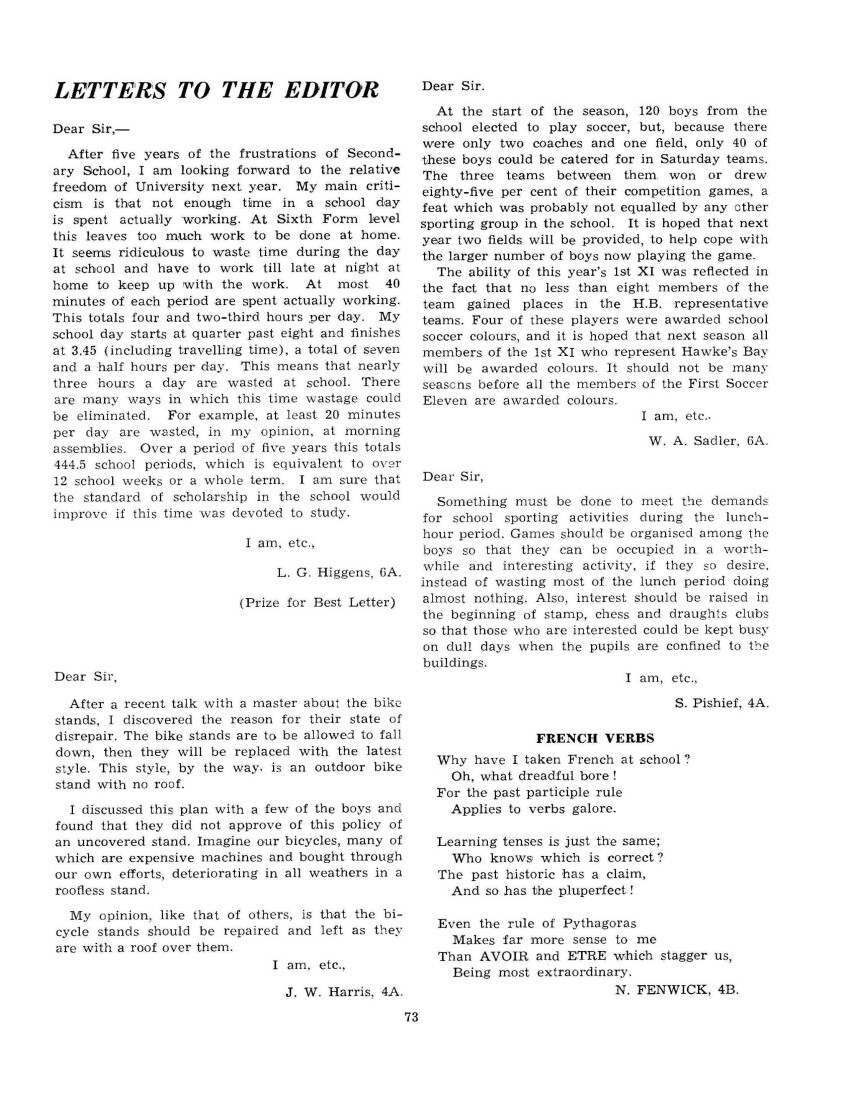
Page 74
SCHOOL ROLL 1964
FORM 6A. Dallas, R. T.; Dick, G. L.; Ebbett, G. W.; Ferguson, D. B.; Higgens, L. G.; Jackson, N. T.,; Kay, J. A.; Kells, R. I; Kerr, D. D.; Lee, A. R.; Lum, C.; Malcolm, R. K.; Piper, J. A.; Pishief, J.; Robinson, E. E.; Robinson, G. W.; Sadler, W. A.; Sherwood, R. H.; Smith, C. B.; Turner, W. E. D.; Weston, K. C.; Wilson, A. R.
FORM 6B. Alpha. Barlow, G. W.; Baudinet, B. R.; Caird, D.; Campbell, L. J. M.; Chrystal, B.; Cross, R. I.; Donaldson, I. K.; Forsyth, J. G.; Harvey, G. J.; Hills, D. J.; Howell, M. J.; King, R. L.; MacLeod, J. D.; Piper, J. M. C.; Prosser, H. W.; Shearn, D. M.; Smith, A. P.; Smith, T. A.; Stevens, R. E.; Tuck, P. J. C.; Wong Soo.
FORM 6B Beta. Armour, R. W.; Campbell, K. S.; Carney, P. R.; Daley, B. W.; Delugar, J. T.; Exeter, J. D.; Fraser, B. C.; Koller, A. R.; Lambert, M. L.; Mackay, G. A.; Nuttall, G. K.,; Rowe, A. J.; Scott, J. S.; Simpson, M. B., Tucker, B. W.; Vivieaere, J. E.; Ware, A. J.; Willis, M. W.
FORM 6B Gamma. Beattie, I. A.; Connor, A. M.; Cottrell, R. V.; de Denne, J. P.; Dick, P. M. W.; Exeter, G. L.; Goulding, D. J.; Kohlis, G.; McBeath, D. J.; McCorkindale, W. R.; Marshall, P. G.; Mear, M. D.; Nant, R. H.; Nation, S. I. W.; Nobilo, M. A.; Prichard, A. K.; Scott, R. 5.; Tennent, H. E. C.; Wilson, &. J.
FORM 5S. Atkin, P. W.; Bell, V. S.; Braid, R. B.; Brown, P. D.; Cameron, K. J.; Dunlop, R. K,; Field, G. M.; Foote, N. D.; Hall, T. A.; Hanlen, J. H.; Hay, D. J.; Holdsworth, G.; Karatau, L. H.; Lambert, B. A.; McBride, I. A.; McDougall, B. A.; McLennan, T.; May, J. L.; Millar, D. M,; Nash, W. L.; Pitt, W.; Peterson, R. L.; Phillips, G. M.; Pond, G. J.; Raitt, G. R.; Reiper, V. J.; Rutter, P. A.; Slight, J. C. N.; Stuart, G. E. C.; Wiig, M. N.
FORM 5U. Alder, S. F.; Bell, R. H.; Brown, H. p.; Craig, F. R.; de Denne, W. H.; Eddy, W. D.; Gilray, I. J.; Godwin, A. E.; Heiford. R. L. H.; Hewson, C. A. Y.; Hyde, EH. D.; Hyde. K. J.; Lavery, J. A.; Lincoln, J. J. H.; Lowe, B. B.; Macdonald, D. G.; MacKenzie, A. B.; Marsters, A.; Pohio, A. J.; Simonsen, G. R.; Sorensen, C. J.; Spence, G. R.; Stimpson, P. E. F.; Trafford, H. M.; Waterhouse, J. D.
FORM 5A. Archibald, W. I.; Bates, T. J.; Bayliss, Cc. D.; Bigg, G.; Bishop, N. J.; Black, H. C.; Boardman, D. A.; Castles, E. M.; Dallimore, L. W.; Davis, T. K.; Denford, P. V.; Farmer, R. A.; Gempton, D. H.; Harris, A. J.; Heap, W. N.; Hopcroft, A. W.; Johnstone, K. L.; Knight, J. G.; Lee, C. J. R.; Lydford, G. R.; Mackintosh, B. L.; McSporran, M.; Moir, N. R.; Olsen, A. G.; Olsen, J.; Parker, A. J.; Paterson, R. J.; Porter.
FORM 5B. Avers, M. E.; Bray, S. J.; Cameron, F. E.; Clark, C. N.; Crarer, G. M.; Davey, T.; Donovan, R. E.; Gardner, C. B.; Gudgeon, M. W.,; Hunt, M. H.; Jackson, R. G.; Joll, C. C.; Kingi, S. H.; Langworthy, R. L.; Layton, M. W.; McIntyre, D. E.; Mclaren, M. W.; Manning, L. R.; Martin, M. A.; Munro, D. L.; Pawluk, R.; Phillips, S. R.; Ramsay, D. P.; Reed, J. 5.; Sawyer, M. K.; Scarrott, I. J.; Scholes, G. M.; Smith, P. R.; Thompson, N.; Tucker, R. K.; Weaver, G. H.; White, J. R.; Whitfield, 5. R.; Wiig, G. T.; Young, P. M.
FORM 5C. August, W. P.; Bennett, L. A.; Blair, I. A.; Browne, D. R.; Castles, A. T.; Chapman, N. C.; Clifford, J. W.; Duncan, B. M.; Eagle, G. E.; Earnshaw, G. R.; de Garis, N.; Glover, D. B.; Grant, G. D.; Hart, R. L.; Harwood, R. J.; Kenah, M. C.; King, D. T. V.; McGowan, A. J.; McKay, I. D.; McKenzie, G. S.; Montgomery, W.; Morrin, P. G.; Oliver, D. T.; Puna, W. J.; Robertson, R. B.; Robinson, P. S.; Sheriff, C.; Simmons, E. R.; Stevenson, D. J.; Strachan, A. P.; Thomsen, R. H.; Tutt, P. E.; White, R. J.; Wong, C.; Young, D.
FORM 5D. Andrews, J.; Atkinson, B. D.; Avenell, W. R.; Bell, W. D.; Bishop, R. J.; Brock, N. D.; Brooker, K. A.; Brown, B. J.; Brown, I. J.; Bull, M. B.; Cowdell, R. N.; Darragh, B. T.; Gillespie, B. J.; Harvey, B. H.; Hodgkinson, E. H.; Hill, C. R.; Hope, T. M.; Irwin, R. W.; Joll, B. H.; Lawrence, D. G.; Macdonald, G. J.; McMillan, J.; Manning, J. P.; Marshall, B. M.; Martel, R. D.; Meaclem, R. O.; Pearse, M. T.; Pomare, T.; Schofield, B.; Shuker, R. W.; Simonsen, D. L.; Single, K. R.; Thomas, R.; Ware, I.
FORM 5E. Alford, D. A.; Baird-Smith, R. W.; Bergman, J. W.; Bourgeois,. T. E.; Bray, R. M; Brunton, C. J.; Campbell, T. N.; Clayton, R. R.: Davidson, B. J.; Douglas, R.; Ewart-Jones, D.; Fleming, R.; Frogley, R.; Hapi, K. K.; Johnston G. J.; Kennerley, D. A.; Kyle, G. E.; Laing, D. J.: Le Quesne, R. J.; MacKintosh, J.; Osborne, C. P.; Parker, J.; Read, D. S.; Robertson, M. H.; Rule, M. A.; Sherwood, A. B.; Treseder, R. E.; Wilson, J. R.
FORM 4A – Bailey, R. G.; Baudinet, I. L; Chapman, P. D.; Chittenden, A. W.; Chute, B. D.; Cook, S. R.; Cross, S. J.; Davidson, J. R.; Dixon, L. R.; Eastwood, K. C.; Exeter, P. R.; Forrest, R. B.; Galgey, G.; Halliday, M. M.; Harris, J. W.; Harrison, R. A.; Heath, J. M.; Johnstone, H. E.; Lemin, R. H.; Lemmon, N. P.; Leslie, P. G.; Longney, R. T.; MacEwan, D. B.; Manson, B. R.;
xxx S. R.; Roberts, R. I.; Romans, 8S. T.; Skews, T. W.; Stayt, J. P.; Thorp, N. F.; Vautier, E. W.; Wharton, T. A.
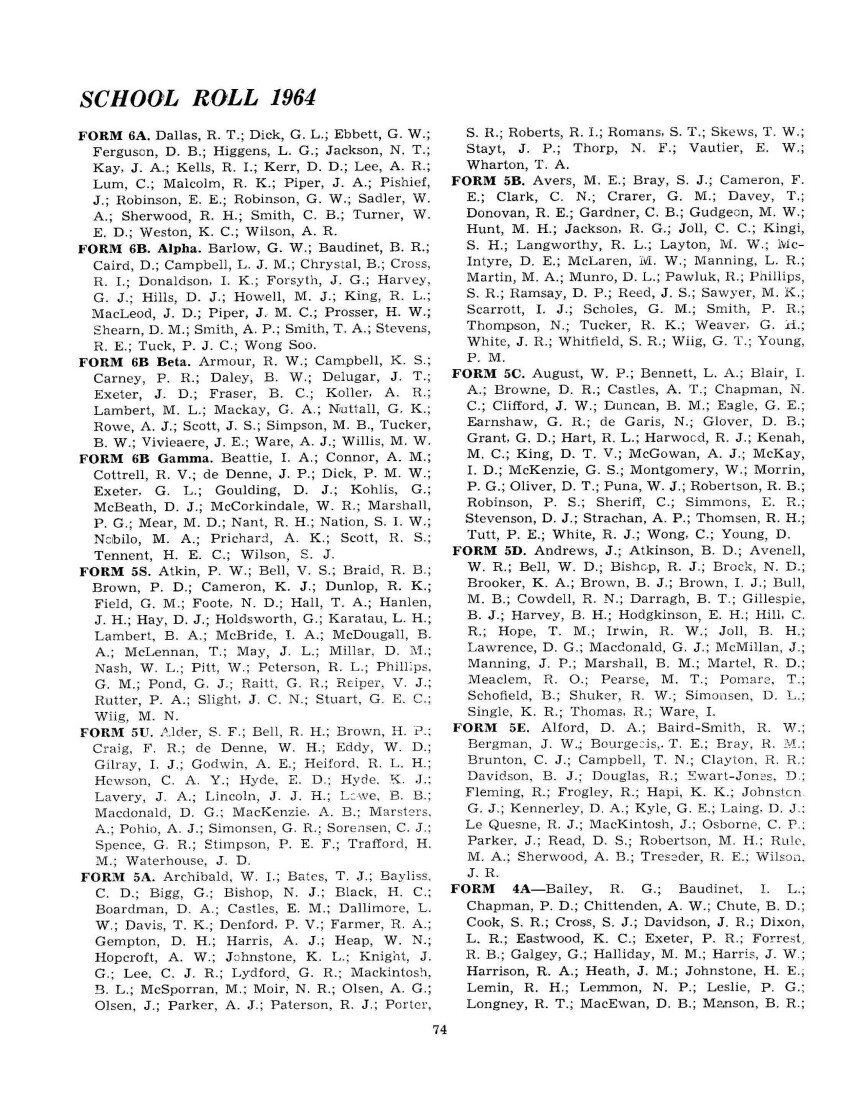
Page 75
Pattison, R. A.; Pendlebury, W. J.; Pishief, S.; Revell, S. G.; Stothart, P. G.; Thomsen, C. C.; Tuck, A. R.; Waite, M. D.; Wright, R. H.
FORM 4B. – Beard, P.; Bissell, J. J.; Bluck, M. V.; Chambers, G. N.; Clayton, E. K.; Davidson, P.; Donaldson, K. D.; Elliott, J. D.; Fearn, R. J.; Fenwick, D. N.; Girvan, W. K.; Godwin, S. J.; Greeks, G. E.; Gregory, R. G.; Harris, W. G. J.; Harvey, R. D.; Jeffares, B. R. S.; Jones, R. A.; Kyle, L. C.; Lemmon, R. A.; Love, C. B.; McGregor, M. G.; Merritt, D. J.; Mills, G. E.; Pearse, P. T.; Pepper, L. F.; Pettigrew, K. J.; Rye, S.; Taaffe, B. J.; Worsnop, B. J.; Young, R.
FORM 4 SPEC. – Absalom, G. J.; Andrew, R. Barrie, G. R.; Bramley, R. A.; Carroll, F.; Chittenden, G. C.; Cook, I. D.; Coon, R. J.; Corlett, D. W.; Dallimore, M.; Deakin, G. S.; Eddy, R. D.; Fisher, W.; Glockling, A. J.; Golds, A. R. R.; Harper, R. C. S.; Lancaster, F. D.; Le Prou, K. A.; Limbrick, B. J.; Little, D. J.; Lloyd, J. R.; Martin, G. R.; Mildon, D. A.; Mills, W. F.; O’Brien, B. J.; Rattray, B. J.; Smith, J. H.; Smith, K. S.; Spivey, A. G.; Thessman, T. J.; Thompson, H. S.; Tuck, R. G.; Vaughan, M. W.; Yelverton, K. B.
FORM 4 MOD. – Addis, P. S.; Buchanan, A. G.; Cartwright, J. B.; Cowan, W. N.; Faulknor, R. R.; Ferguson, J. S.; Fuller, G. R.; Goulding, G. E,; Harwood, G. D.; Hazlewood, N. A.; McCallum, P. T. O.; Marshall, S. C.; Maru, A. B.; Masemann, T. A.; Moore, J.; Neilsen, G. D.; O’Donnell, T. J; Phillips, A.; Pryce, R. D.; Radford, A. P.; Ralfe, L. H.; Riddell, D. G.; Rongo, W. T.; Ross, J. M.; Sawyer, N. A.; Smith, M. S.; Spence, P. OJ. Symons, R.; Tuck, R. S.; Waide, R. A.; Wiig, B. L.; Wyndham, A. G.; Young, I. J.
FORM 4 GEN. – Armstrong, D. J.; Barham, P.; Bennett, E. A.; Campbell, C. N.; Cavanagh, A. D.; Cullen, K. R.; Doole, D. J.; Dyer, K. D.; Eagle, K. W.; Field, P.; Gerrard, K. W.; Glock, L. R.; Hellyer, R A.; Johnson, K. J.; Johnson, M. P.; J. J. Karatau, T. G.; Kohlis, W.; Macan, S. G.; Macdonald, S. J.; Machin, R. B.; Maru, T. Newham, P. E.; Parker, N. J.; Parker, S.; Redshaw, S. I.; Robinson, K. A.; Snaith, S. J.; Te Kira, R. W.; Thomas, T. D.; Turner, R,; Walker, C. W.; Warman, G.; Winkley, K.
FORM 4G. – Binnie, R. G.; Bray, D. R.; Cave, I. M.; Christoffersen, A. A.; Elliott, D. S.; Elsmore, W. B.; Fraser, S. H.; Germain, G .O.; Herdman, K. J.; Haukamau, J. H.; Jenkinson, D. S.; Jobbins, A. C.; Kennedy, C. H. K.; Kingi, B.; Macaulay, N. I.; Nichol, R. M.; Nicholls, M. A. Northe, P. R.; Richardson, I. B.; Robertson, G. D.; Robottom, P. H.; Schofield, R. I; Struthers, H. H.; Scrimgeour, R.; Tong, R. C.; Weatherley, K. B.; Whatarau, E. R.; Winter, J. S.; Yee, A.
FORM 4R. – Black, L. W.; Boardman, A. D.; Bond, B.; Buckley, I. K.; Bulled, G. O.; Chapman, A. D.; Cunningham, E. G.; Foley, D. D.; Gilder, G. C.; Gilder, C. G.; Gray, A. J.; Hawkins, J. 0.; McCutcheon, H. L.; O’Brien, L. K.; Parker, W. H.; Porter, C. C.; Petuha, E.; Quinn, K. N.; Reid, R. S.; Smith, W. D.; Tucker, R. H.; Uren, J. F.; Workman, D.
FORM 4T. Brown. K.; Butler, T.; Coldicutt, G. C.; Dean, A. L.; Flett, G. J.; Foster, J. E.; Gattsche, R. L.; Harding, R. A.; Horton, S. R.; Jensen, A.; McKenzie, R. T.; MacLean, N. A.; Marshall, B. S.; Miller, P. L.; Neill, R. B.; Rankin, D. J.; Stephens, D. P.; Uriarau, C. A.; Veale, G. S.; Walker, D. J.; Wilson, H.; Wong. M.; Young, S.
FORM 3A. Absalom, N. W.; Ansell, R. J.; Bell, G. S.; Bowling, A. W.; Briasco, J. D.; Brinsley, P. S.; Brooks, C. G.; Brooks, J. P.; Brown, A.; Buchanan, R. A.; Carmichael, M. A.; Clark, J. W.; Conchie, V. M.; Double, J. E.; Ducker, D. J.; Duncan, L. D.; Easterbrook, J.; Eaton, M. D.; Farquharson, K. O.; Fraser, A. P.; Gempton, G. R.; Griffiths, A. D.; Hamilton, S. R.; Heaps, G. E.; Hunt, C. J.; Leggett, D. J. H.; McNicol, M.; Mattson, K.; Moroney, D. J.; Neal, G. D.; Nolan, C. G.; Olson, C. L.; Pohio, B. E.; Smith, S.; Spackman, P. G.; Stevens, R. W.
FORM 3B. Angove, C. N.; Ball, C. J.; Bartholomew, J. S.; Brady, A. C.; Buckle, D. J.; Carter, I. R.; Cheyne, A. P.; Corbishley, R. A.; Danks, J. E.; Dowrick, S. A.; Eagle, R. F.; Fraser, B. M.; Fraser, C. J.; Gannaway, P. R.; Girvan, R.; Graham, M. V.; Hall, J. W.; Harman, P. B.; Holder, K. J.; Jenkinson, B. S.; Lane, D. R.; Lyver, M. H.; McGregor, B. R. F.; McLea, K. L.; Moir, G. W.; Morton, J. D.; Niblett, F. W.; Scholes, R. W.; Silby, T.; Sivewright, P. J.; Start, E. H.; Steed, R. J.; Sweeney, W. J.; Taylor, C. L.; Taylor, P. S.; Wheeldon, J. W.; Williams, A. G.
FORM 3 Spec. Anderson, R. D.; Ashcroft, M. A.; Baker, I. A.; Barrow, J. B.; Baty, B. R.; Bray, A. R.; Bray, I. C.; Brown, C. A.; Christie, D. J.; Church, B. F.; Connor, K. S.; Crabtree, L. D.; Craig, P. T.; Dickey, G. D.; Eagle, R. J.; Farquharson, J. W.; Fulton, R. E.; Geddis, C. P.; Godwin, M. R.; Gosling, R. D.; Green, W. W.; Harvey, J. W.; Jones, M. K.; KauKau, P. R.; Kingi, D. D.; Lee, P. C.; Luke, W. R.; MacEwan, I.; McMullan, J. K.; Morrison, F.; Ratahi, D.; Reid, J. M.; Stevenson, M. H.; Stitson, B. J.; Tuck, A. E.; Wilson, W. J.; Wood, T. P.
FORM 3 Mod. Bird, A. C.; Bishop, D. F.; Bolingford, M.; Boyd, D. R.; Brownlie, J. R.; Castles, J. D.; Collins, W. H.; Cooper, D. R.; Dawes, L. J.; Drinkrow, P. M.; Hammond, A. W.; Hard- grave, E. P.; Harwood, D. M.; Hellyer, P. M.;

Page 76
Hogg, G. A.; Hole, G.; Hurley, W. M.; Kersey, G. R.; Loader, M. I; McAulay, D. W.; Mapu, J. W.; Monk, W. A.; Morris, N.; Nightingale, W. T.; Nobbs, R. F.; Pomare, E.; Redshaw, D. J.; Roberts, B. H.; Roberts, S. J.; Sanders, A. T.; Sigvertsen, I. J.; Smith, G. A.; Struthers, N. C.; Thornburrow, T. R.; West, K. P.; Wilson, H.; Youren, D. J.
FORM 3 Gen. Baines, A. J.; Barber, S. V.; Battersby, L. O.; Bird, R. T.; Burn, P. C.; Byers, G.; Calnan, G.; Carr, E.; Christie, A. K.; Cooper, M. K.; Cottrell, B. H.; Cullen, M. L.; Cullen, M. N.; Deller, P. W.; Dumble, J. W.; Eastwood, J. M.; Ferguson, W. G. A.; Gibbs, B. S. H.; Greenwood, J. P.; Hannah, S. W.; Hastie, M. A. K.; Johnston, P. R.; Kemsley, G.; Lawton, J. E.; Ludvigsen, J. M.; McCalmont, N. J.; McLean, R.; Martel, H. P.; Petuha, H.; Reti, F.; Smith, G. F.; Snee, B. L.; Stephens, P. A.; Sutton, J.; Viggers, P. J.; Willis, R. G.
FORM 3G. Anderson, P. J.; Bartle, R. B.; Bateman, H. J.; Bee, J. R.; Birch, I. S.; Cameron, P. J.; Collier, B. E.; Compton, B. S.; Croad, G. C.; Fleming, A. D.; Gregory, J. R.; Hart, G. J.; Holland, R.; Jane, T. R.; Joe, A. D.; Johnson, M. D.; Kirk, J. A.; McKay, J. R.; McOnie, M. J.; Nichol, D. S.; Nilsson, M. P.; Perfect, C. R. J.; Smith, R. L.; Spain, C. R.; Spooner, K.; Tinworth, B. H.; Uren, L. R.; Ward, R.; Webster, R. J.
FORM 3T. Black, I. R.; Brooks, K.; Browne, C. G.; Bulled, D. A.; Cameron, R. B.; Coburn, M. N.; de Denne, P. M.; Golds, B. P.; Hanlen, G. G.; Hawkes, D. J.; Holder, B.; Huata, H.; Leach, W. J.; Little, S. D.; Long, J. A.; Lurajud. J.; Neera, P.; Ngaronoa, A. P.; O’Brien, M. G.; Redrup, G. E.; Roberts, R. J.; Roydhouse, W. J.; Scarrott, P. M.; Sheeran, M. T.; Smith, A.; Sole, C. E.; Staal, J. W.; Stevenson, B. R.; Struthers, G. W.; Tareha, T.; Tawhai, G.; Teal, D. N.; White, W. E.; Wright, G. S.
FORM 3R. Barnes, W.; Beach, R. F.; Cameron, R. A.; Clinch, S. H.; Culshaw, M. J.; Ferguson, J. L.; Fulford, J. C.; Greaney, P. F.; Hamlin, H. T. P.; Irwin, R. D.; Keefe, N.; Keil, H. H.; Kennedy, R.; Lake, K. J.; Lawson, P.; Lett, S. G.; McKay, N. R.; McVicar, G. N.; Merrick, J. C.; Monk, W. J.; Morrell, L.; Neill, R. R.; Nicholls, B. L.; Puna, P.; Riki, J.; Scullin, B. J.; Smith-Holley, R. B.; Sparrow, S. R.; Toop, R.; Uriarau, T.; Watson, M. J.
OLD BOYS’ NOTES
1963-64 Executive
President: Mr Brian MacKay.
Vice-presidents: Messrs Murray Wall and Clyde Jeffery.
Secretary: Mr Murray Holland.
Committee: Messrs Len Morley, Clinton Holt, Alan Plested, Neville Roach.
O.B. Football Club representative: Milburn.
School representatives: Messrs M. A. F. Campbel and D. G. Revell.
Auditor: Mr Fred Sanders.
Annual General Meeting 1964.
Mr Brian MacKay presided over the annual general meeting on Saturday 17th October. There were 50 present. The election of 1964-65 officers was as follows:
President: Mr Murray Wall.
Vice-presidents: Mr Brian MacKay and Mr Barry Milburn.
Secretary: Mr Murray Holland, Colenso Chambers, Emerson street, Napier.
Elected to Committee: Mr John McBeath.
The outgoing president paid a warm tribute to the invaluable work of the secretary, Mr Murray Holland. He also expressed some concern at the dwindling membership and urged that all old boys of the school should link up actively with the association.
Annual Old Boy’s Dinner
The annual reunion and dinner was held at the H.B. Club on Saturday 17th October. As far as possible the committee tries to arange [arrange] it for the Saturday before Labour weekend, which is a date to remember for next year. It was a very enjoyable occasion although the attendance of 47 was slightly down on the previous year. Mr N. Fippard, a Hastings public accountant, proposed the toast to the school. He said that this was the first opportunity that most old boys had had of meeting and welcoming the new headmaster, Mr D. P. Caird. In reply, Mr Caird elaborated on some school matters which he wished to lay before the old boys. The Wellington branch was represented by Messrs Laurie Meads and Colin Heath. The school was represented by Messrs Caird, Revell, Campbell and Brebner.
Anzac Day Service
Once again the old boys were associated with the school in its Anzac service on the afternoon of the 24th April 1964. Mr C. J. Bagley read the Roll of Honour for the Boer War and the 1914-18 War. The Roll of Honour for the 1939-45 War was read by Mr Brian MacKay.
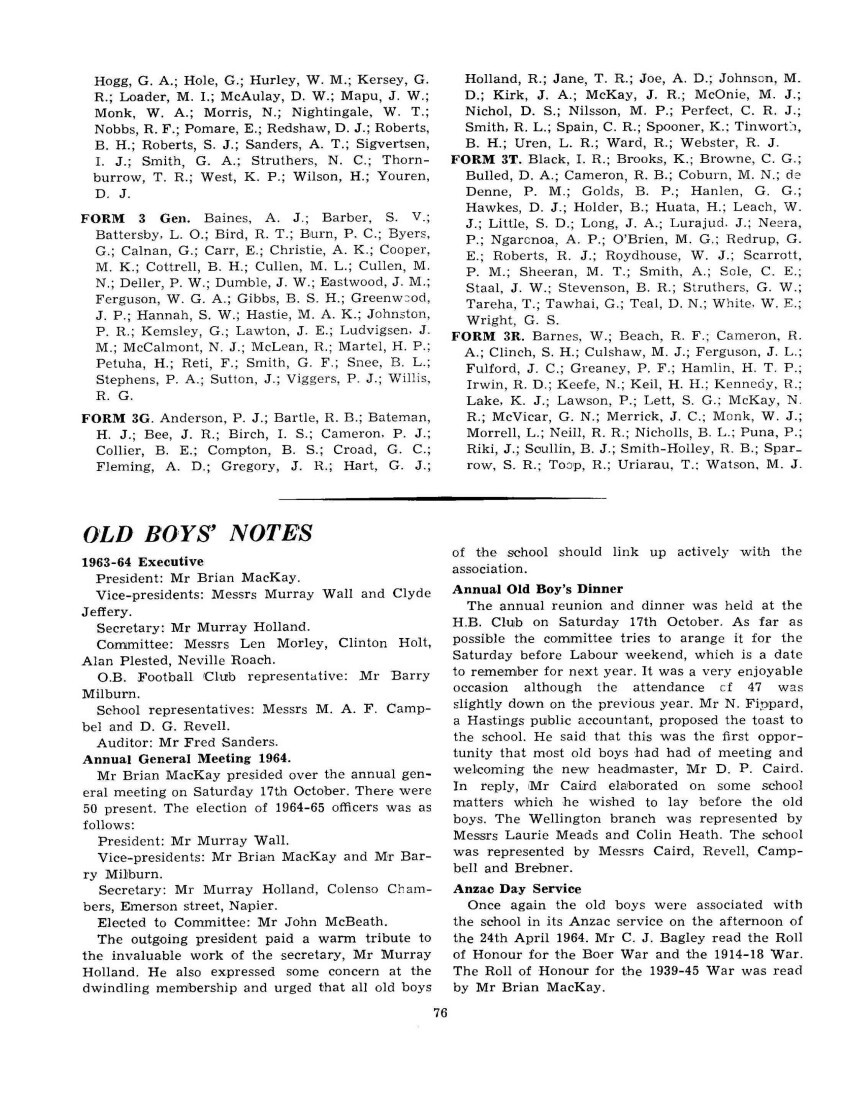
Page 77
Wellington Branch
The secretary, Mr L. A. Meads, writes: “The Wellington branch continues as active as ever. I have on my list the names of 247 old boys, who live as far north as Otaki. I shall be extremely pleased to hear of any old boys going to Wellington. We would even do our best to assist with accommodation.” Mr Mead’s address is 11 Pitarua street, Wellington N1.
There were eighty old boys at the annual reunion in Wellington on the 1st August. Messrs Caird, Roach, Walker and MacKay represented the Napier body at the reunion. Judge K. G. Archer introduced the new headmaster, Mr D. P. Caird, to the Wellington old boys, and paid a sincere compliment to Mr Caird’s youth and vision as a headmaster.
The election of officers for 1964-65 was:
President: Mr A. K. Maidens.
Vive-president [Vice-president]: Mr H. K. Bull.
Secretary: Mr L. A. Meads.
Treasurer: Mr C. Robertson.
Committee: Messrs H. Bennett, A. R. Bullen, H. G. Fownes, J. Gahagan, C. Heath, P. F. Martin, 5S. J. Mahony, W. E. Sisson.
Auditor: Mr A. R. Bullen.
The branch decided to start a fund for the school centennial project for 1972, and a generous response was received instantly from the meeting.
Palmerston North Branch
Mr B. B. Whitehead who acts as organiser for the Palmerston North reunions, called at the school in November. He reported: “We usually have thirty-five to forty at the time of the Polson Banner match, but this year Mr Caird could not attend because there were departmental inspectors at the school, and the reunion did not materialize.”
Faithful supporters of the branch are H. Essex (1907), F. Mackie (1920), A. Douglas (1924), J. M. Grant (1925), W. McBride (1926), J. Shewan (1927), V. Frost (1934), and J. Thomson (1931).
Mr Whitehead supplied the school with a copy of the school song “The Best School of All” which is always sung at P.N. reunions.
GENERAL NEWS
Auckland University
2nd year arts: Nicol Macfarlane.
1st year law: B. Brendon; 3rd year law: G. Chappell.
1st year science: A. J. Schmidt; 3rd year science: L. Goldsmith, A. Collow (proceeding to B.E.), C. McKenzie, J. Woolf.
Engineering intermediate: Geoffrey Williams.
Architecture: A. Ross.
Victoria University of Wellington
Pharmacy School: R. Lyall, R. Grant, J. Gahagan.
1st year science. G. P. Dale.
2nd year science: Digby Tuck (forestry), G. Barnes, Bill Jordan, R. McMullan.
3rd year science: Graeme Hancox, Ian Harland, Michael Cresswell.
M.Sce.: Jim Ansell (senior scholar – maths), Peter Roberts (geology).
Engineering intermediate: Jim Irwin.
2nd year law: W. Krogh; 3rd year law: Peter Tong; 4th year law: Kerry Irwin, Michael Neville, Malcolm Walker.
1st year arts: Alan Mitchell.
2nd year arts: D. Paxie (active in Capping Week events!).
3rd year arts: Bill Alexander, Jim Howell.
M.A.: Ronald Fountain.
B.A., B.Comm.: Gary Hawke (stil [still] doing brilliantly. Senior scholar 1963)
B.Comm.: Brian Wharton.
Accountancy: Colin McKinnon.
Canterbury University
lst year science: Ralph Thompson, Roger Hobin;
2nd year science: Bert Bowling and Axel Blom;
3rd year science: H. J. Purchas.
Engineering 1st professional: T. C. Wong: 2nd professional: Bernie Tuck (elected head student of Rolleston House for 1965, and prominent in Varsity sport.) Studying for B.E.: Pete Alexander, C. D. Harrison.
Ist [1st] year arts: J. Isles and W. Nicholas (both personalities of Warwick House.)
2nd year arts: J. W. Bluck (elected head student of Christchurch College for 1965. University debating representative.)
Otago University
Divinity: Preliminary studies are occupying Rex McIntyre and Roger Wiig. D. Carmichael is now engaged in Theological studies
Kim Morgan is finishing his Diploma of Phys. Ed.
2nd year law: Greg Campbell.
Medical intermediate: Kam Seuseu, Ashley Keils, Roger Chin.
1st professional Campbell.
2nd professional year: George Ngaei, Ian Dean, Doug. Knight.
Arthur Young and Trevor Young are near to completion of their medical degrees.
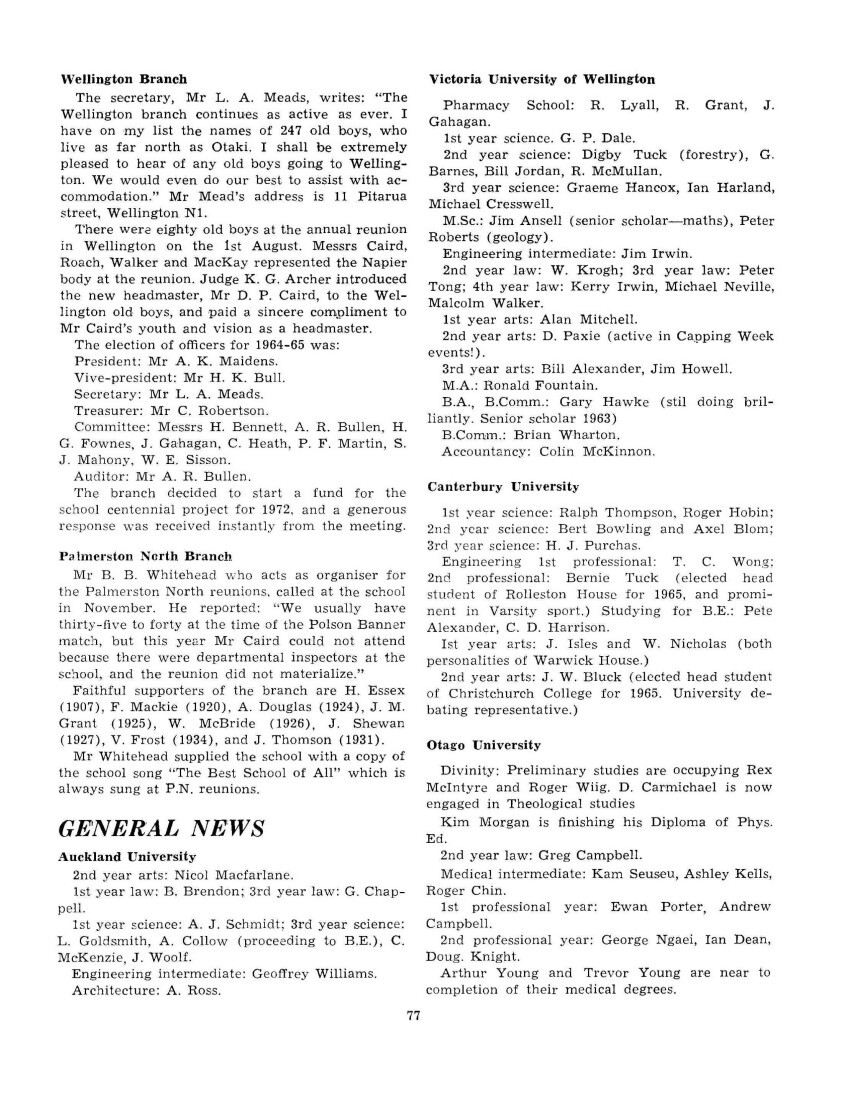
Page 78
Judge A. K. Archer (1910-13) visited the school on the 26th May and spent the afternoon with the Headmaster. Alan Barker has completed his B.Sc. and is working in the Biochemistry Laboratory of a Christchurch hospital.
Ted Bennett is married in Australia. He still intends to return to university when his singing career is over.
P. J. Berry is now teaching Phys. Ed. in Christchurch.
Axel Blom is successfully teaching music as a side-line in Christchurch.
Braeme [Graeme?] Buist has commenced private dental practice in Invercargill.
Tony Bryan has been attracting praise for his promising Rugby play this season.
Flight Lieutenant B. P. Bygate is now adjutant at Wigram R.N.Z.A.F. station.
Doug. Callaghan is now in Brisbane completing his B.Vet-Sci. degree.
John Clark has transferred from Wellington to manage the Karamu road branch of the ANZ bank.
C. J. Colbert has been appointed vice-principal of the Auckland Teachers’ Training College.
John Cullen, M.B., Ch. B., who has been working at the Palmerston North Hospital, represented New Zealand in hockey at the Tokyo Olympic Games.
Kevin Douglas, who has moved to Tauranga as a Government Life Insurance supervisor, has played as a regular member of the Tauranga XV.
J. G. Edwards (1940-1944) is the new chairman of the school’s board of governors. Present head of the school’s science department, J. D. Briasco, was his class companion throughout school.
Ossie Fountain is now teaching in New Guinea while completing his M.A. thesis in Geography. Daryll Gilliland has been doing wonders in field sports, and won the national junior hammer throw championship.
Brothers D. V. Hamilton and R. G. Hamilton brought distinction to the school in an unusual way this year. D. V. Hamilton won the Tewsley Cup for the best all-round seaman trainee at Tamaki; and R. G. Hamilton won the Davis-Goff Cup for the best all-round non-seaman trainee. The latter is an electrical recruit.
Rex Hawkins is in the N.Z. police contingent acting as part of the United Nations peace-keeping force in Cyprus.
Don Henderson has commenced a private dental practice in Wellington.
Dr W. E. Henley was one of the Governor General’s advisory committee for the selection of the Rhodes Scholar.
Peter Holland graduated in Auckland last year B.Arch. (Hons.). He is working in Hastings.
Gilbert Howell (1957) is teaching at Wellington College.
Peter Irwin topped New Zealand in the Electricians’ Registration Board exam this year.
Chief Engineer N. Jenner (1937) is Director of Apprentice training at H.M.N.Z.S. Philomel.
Jock Kearney is now area officer of Napier. Ra Kohere is teaching maths and Phys. Ed. at Mana College, Wellington.
P. F. Martin (1956) has completed his medical degree and is working in Wellington.
Dave Mitchell, after an overseas trip for a year, is working in the Customs Department in Wellington.
Terry Mortensen (1961) and Noel Hawkins (1960) are to be seen “on the beat” in Wellington.
R. B. Mountjoy has completed his B.E. with honours.
Roy Peach returns weekly to the school for motor maintenance classes.
D. Ramage is teaching design at Wellington Polytechnic.
Max Rispin (54-57) has recently returned to Napier after teaching and working in many parts of Canada.
“Lucky” Roberts has transferred to Auckland as the Schweppes representative. He is still playing excellent cricket, and was a Wellington rep. player last year.
Laurie Rolls is the South Island correspondent for a farming newspaper.
Keith Sayers has completed his M.A. degree with honours at Otago University and is now in Christchurch.
Colin Simmonds is stationed with the R.N.Z.A.F. at Wigram.
Richard Spence (Dux 1958) has been appointed junior lecturer in mathematics at Victoria University.
Wilton Vinton, with his theology course completed, takes up Cromwell Presbyterian parish next year.
John Verboeket completed his B.D.S. last year. This year he has been an assistant lecturer at the Dental School in Dunedin.
Nelson Wattie (1958) was singing a leading role in the N.Z. Opera Company’s “Rigoletto”. He has been studying English III and German III as well this year.
P. Wrightson (1948) turned up with a prosperous-looking fleet of trucks to asphalt the hostel driveway this winter.
Trevor Wyndham (1963) was sponsored by Napier Rotary to attend the Outward Bound School this year.
Grahame Yonko has gone to South Africa with the Rothmans Group of companies.
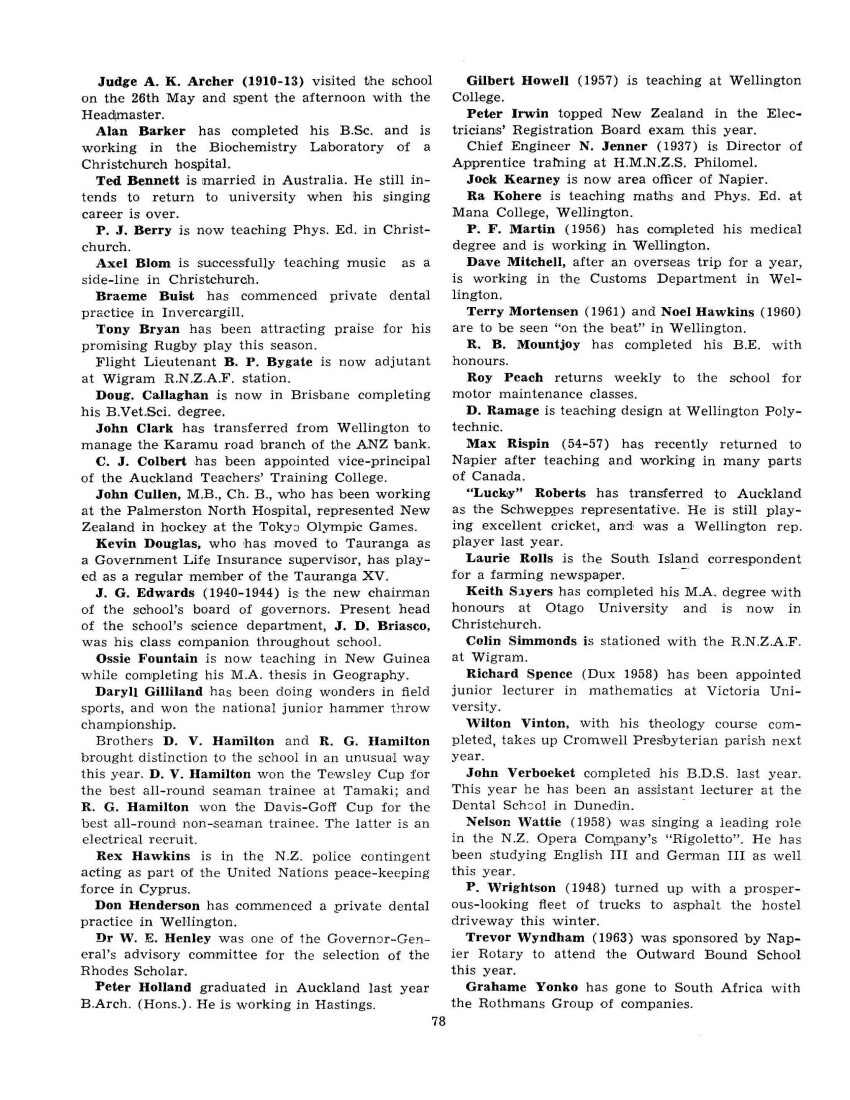
Page 79
OBITUARIES
Mr H. K. Bull
Mr Henry Keith Bull
Mr Keith Bull, who died suddenly on August 21st. 1964, was a very good friend of all Old Boys and a tower of strength to the Wellington Branch of the Old Boys’ Association. He was an executive member of the Wellington Branch for eight years, treasurer for six years and this year had been elected vice-president.
Mr Bull was born in 1918 and became Head Prefect and Captain of the First Fifteen at the Napier Boys’ High School. He went through the war in the Middle East from 1941 to 1944, and then returned to his position as an officer of the Inland Revenue Department. Only four years ago Mr Bull went into partnership in the independent practice of accountancy.
Many fine spheres of service in which Mr Keith Bull had served his fellow men were mentioned at his obsequies. We offer our profound sympathy to Mrs Bull and to his sons, Roger, Barry and Kevin.
Mr W. A. Beck
A former member of the N.B.H.S. First Cricket Eleven, Mr W. A. Beck, died suddenly at Taupo on March 23rd, 1964.
Mr Beck was a well-known cricket administrator. As a schoolboy he was selected for a Plunket Shield trial match, and later captained the Hawke’s Bay representative eleven. We express our sympathy to Mrs Beck, to Gary, John and Philip, and to his daughter, Louise.
Mr P. P. Mayo
Mr Percy Mayo, who won the shooting championship while at the Napier B.H.S., died suddenly at the age of 58 on December 13th, 1963. Mr Mayo played a major part in the construction of the new St Augustine’s Church and served the St Augustine’s Parish very devotedly and faithfully.
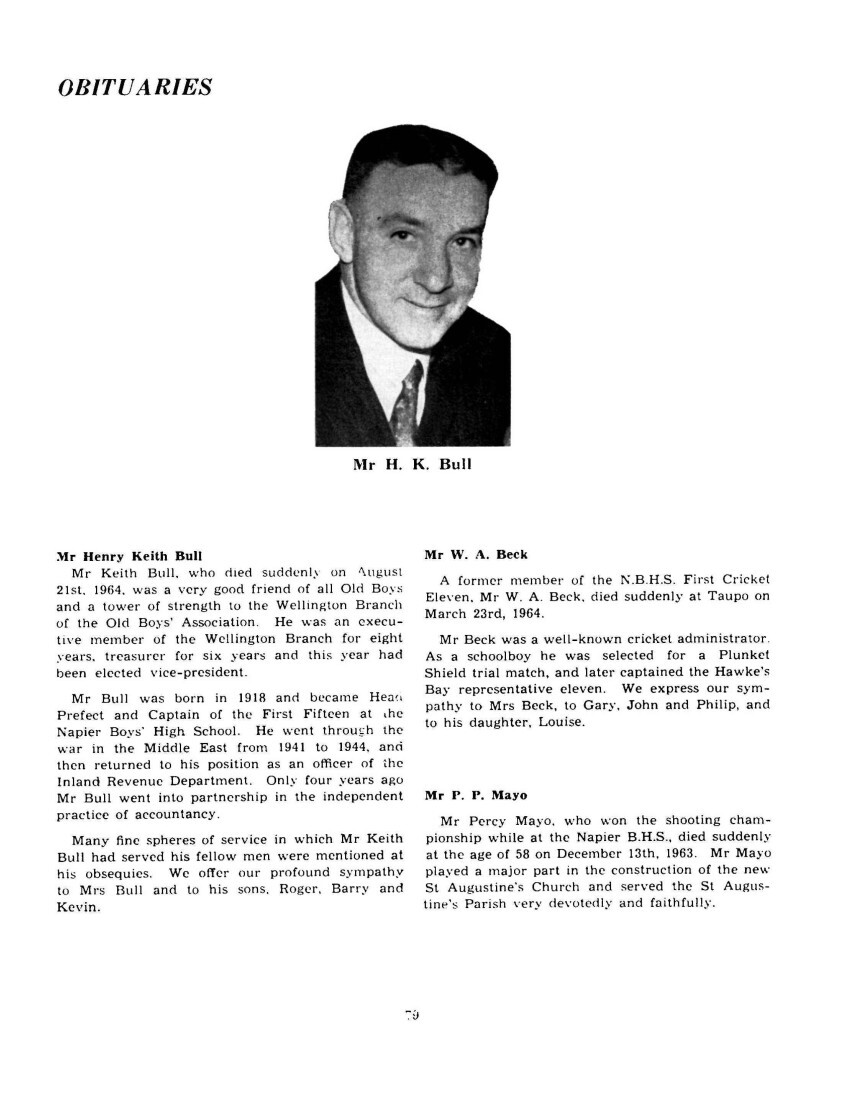
Page 80
OLD BOYS’ RUGBY CLUB
This was the most successful season the club has had for many years. Everyone knows that players like Kelvin Tremain (captain-coach), Rod Abel, Gordon Love, Gus Meech, Hylton Meech, Tony Dick, Tony Nattrass and Paul Evans lifted the performance of the pack to such a high level that few clubs in the country could match it. Barry Neal, Campbell Hogg, Ian Bishop and Doug Curtis made the most of the possession the forwards gained for them. Then there were the stalwarts like John Chrystal, Doug Haig, Stewart Little, Colin Hay, John Foster, Pat Lynch and John Howell.
The winning of the H.B. Challenge Shield, Maddison Trophy, Banks Shield, as well as two Easter tournament cups and three inter-club cups – a record to be proud of.
Then the highlight of the season was the fabulous end-of-season game between a North Island XV and the Hawke’s Bay team organised by the club’s executive.
The Juniors, under the guidance of John McKenzie, had a quite a good season, with the inclusion of one or two of the previous year’s First XV boys. This team played many fine games as well as having terrific club spirit. These boys were good club workers.
The Third Grade, with Harry Marrett at the helm, started off the season with fifteen players and before the end of the season were nineteen strong. It was a pleasure to see the keenness of these boys, especially at training. Their club spirit, too, was exceptional. What with more boys from the school next season, this team could be very strong.
The club would welcome boys from the school, especially Third and Fourth Grade players. Remember, boys, it is your club Napier High School Old Boys.
B.H.
OLD BOYS’ CRICKET CLUB
This year it is a pleasure to report that the senior team is entirely composed of N.B.H.S. Old Boys, who all played at some time for the School First Eleven. The senior team is: R. Schofield (captain), B. Spooner, D. Alexander, R. Clement, D. Devine, J. Howell, B. Husheer, D. Jones, W. Larsen, A. McDougall, W. Nation and T. Reaney. It is a young team – Robin Schofield and John Howell seem to have a bright future ahead of them; and Warren Larsen and Alan McDougall were in last year’s School First Eleven.
Unfortunately, it was not possible to arrange a match with the School Eleven this season. The Old Boys’ team enjoys this game and likes to make it an annual fixture. Naturally, members of the First Eleven who are leaving school are always very welcome prospects for the Old Boys’ Cricket Club.
Normally there are three Old Boys’ elevens playing competition cricket, but the third team finished early this year, and there are just the senior and junior teams. The junior team will always welcome cricket players who are leaving school.
B.S.
INDEX
Editorial 3
School Diary 4
Examination Results 6
Prize List, 1963 6
Mr D. S. McKenzie 8
Staff Notes 10
Parents’ League 13
Board News 15
Visitors to the School 17
Prefects 19
Debating and Public Speaking 20
6A Notes 22
Memorial Library 23
Music and Pipe Band 24
Club Notes 25
4R Social Studies Tour 29
Interviews 30
Farm Notes 32
House Notes 34
Military Cadets and A.T.C. 37
Rugby 40
Cricket 46
Athletics 49
Basketball 56
Hockey 58
Colours 59
Rowing 60
Shooting 60
Soccer 62
Tennis 64
Softball 64
Swimming and Lifesaving 65
Open Column 68
Letters to the Editor 73
School Roll 74
Old Boys’ Notes 76
Obituaries 79
O.B. Rugby and Cricket

Non-commercial use

This work is licensed under a Attribution-NonCommercial 3.0 New Zealand (CC BY-NC 3.0 NZ).
Commercial Use
Please contact us for information about using this material commercially.Can you help?
The Hawke's Bay Knowledge Bank relies on donations to make this material available. Please consider making a donation towards preserving our local history.
Visit our donations page for more information.

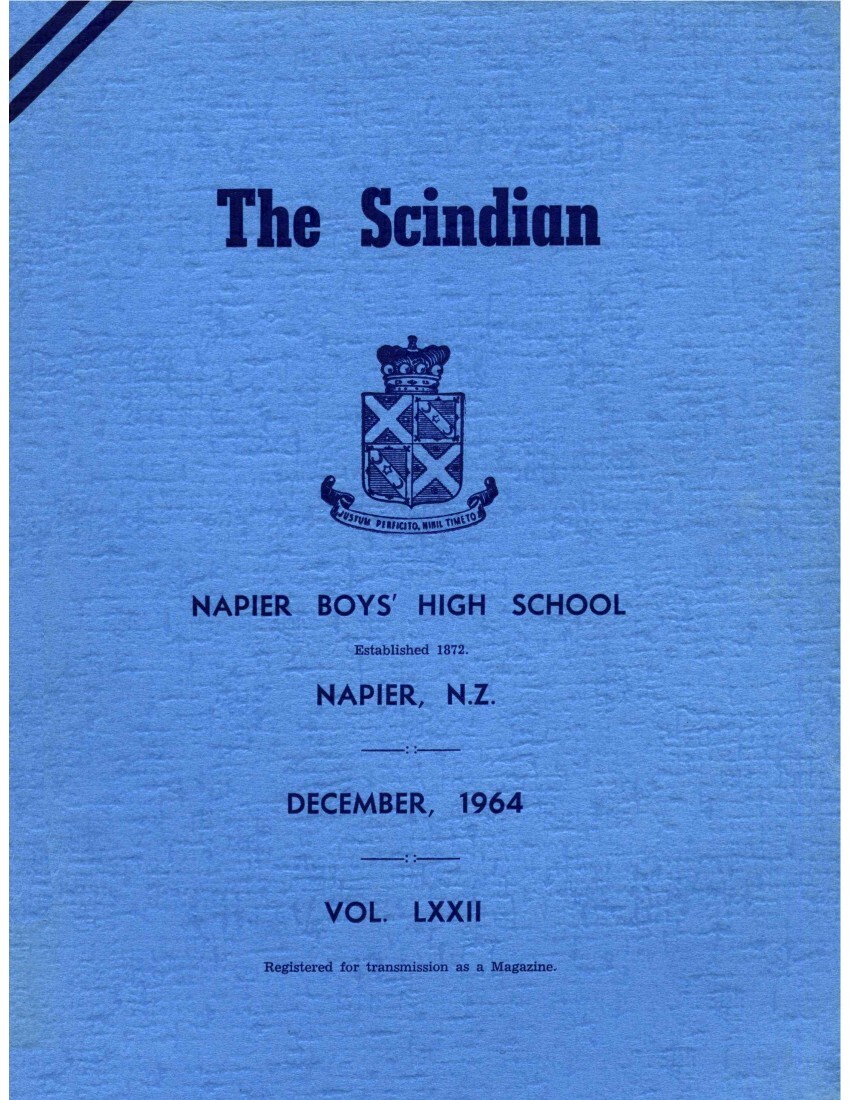
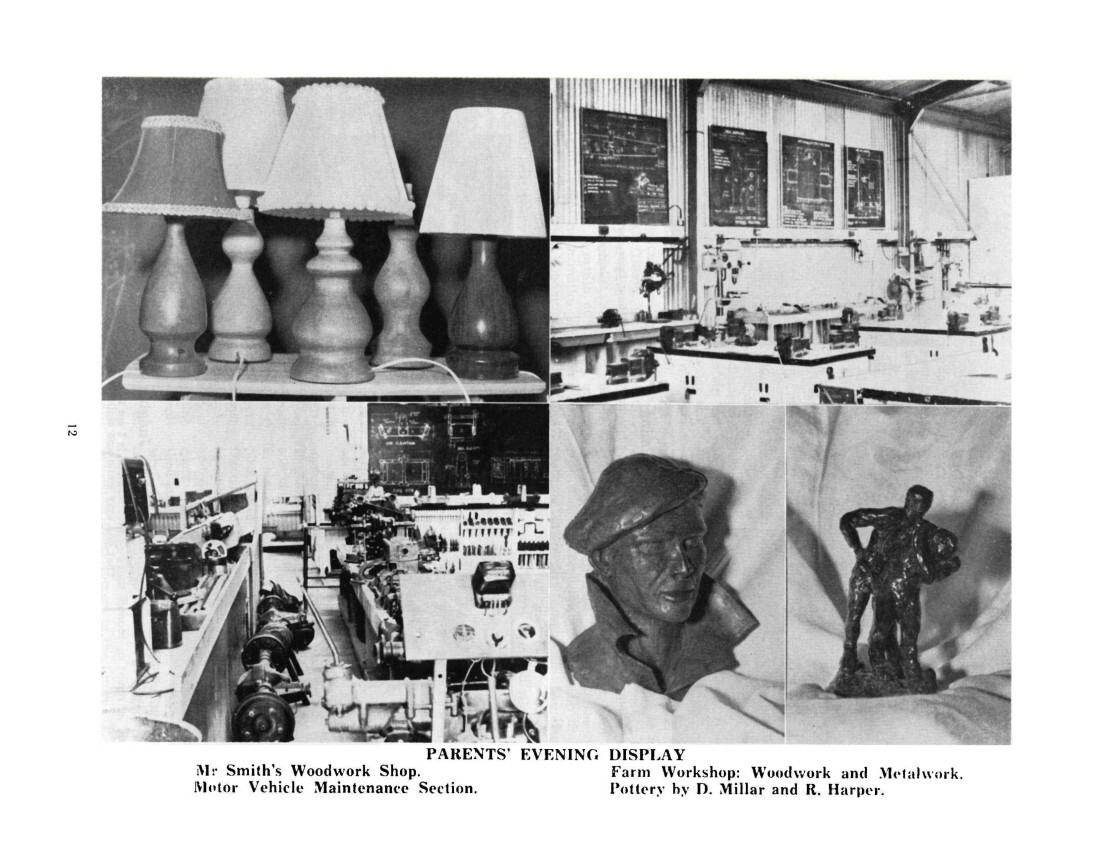
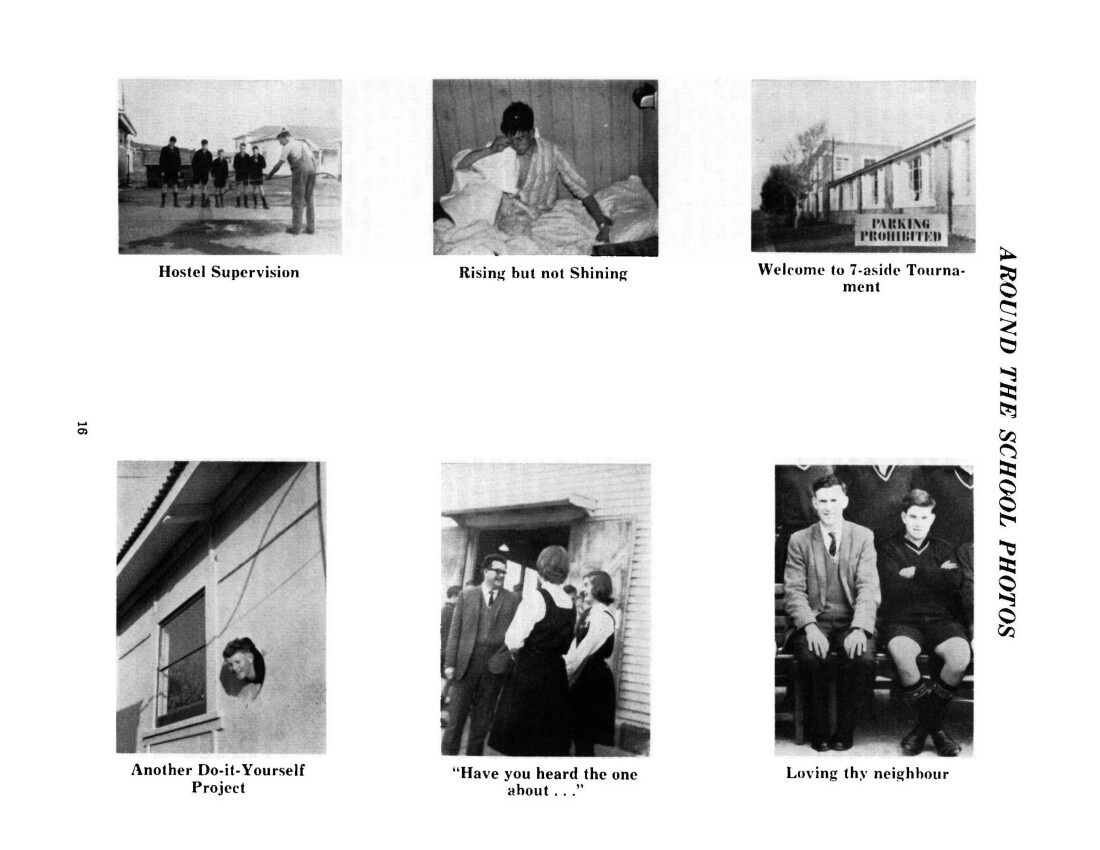
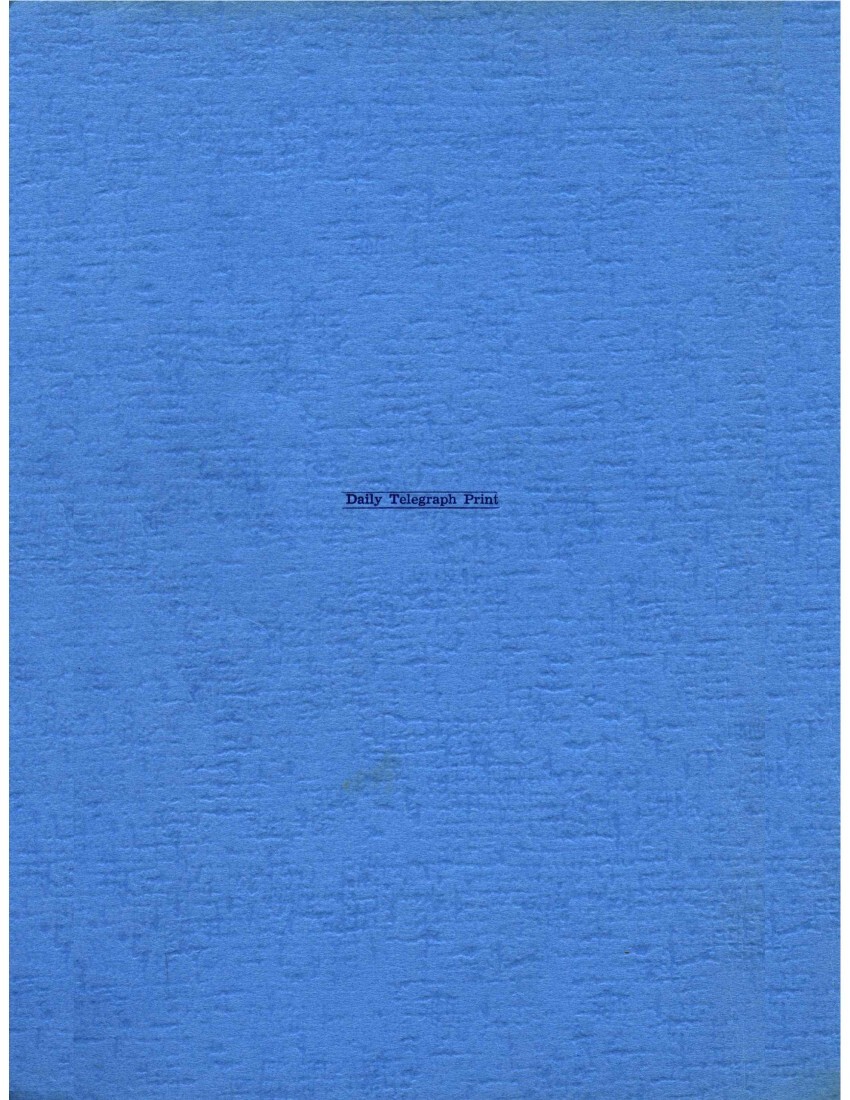









Do you know something about this record?
Please note we cannot verify the accuracy of any information posted by the community.